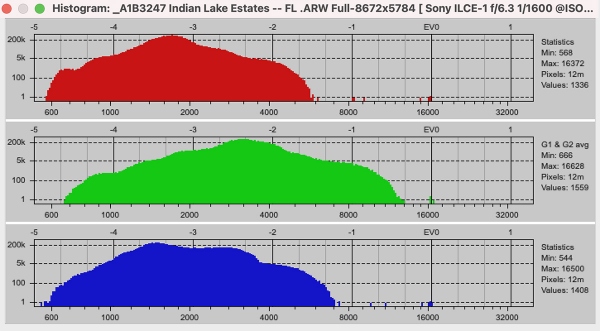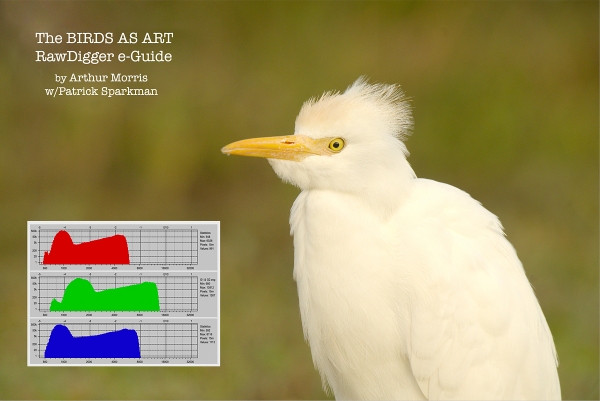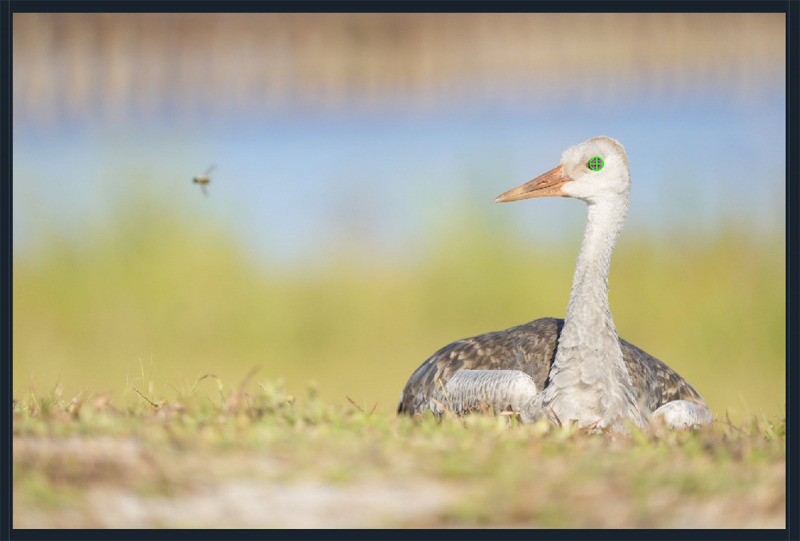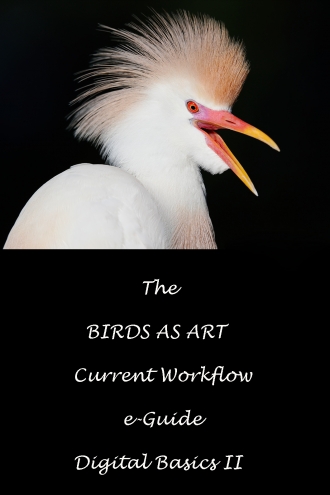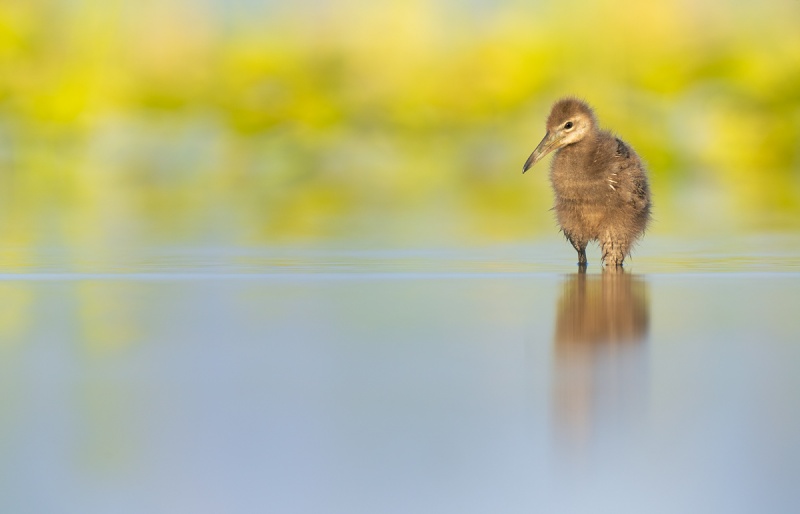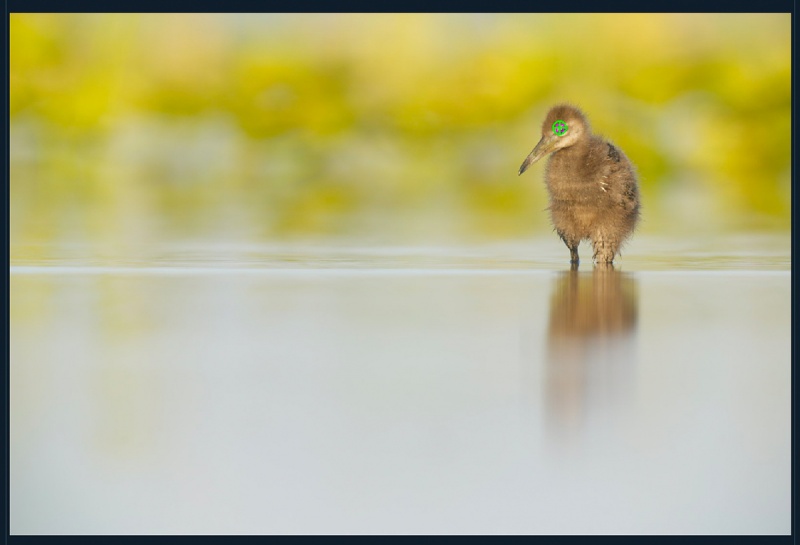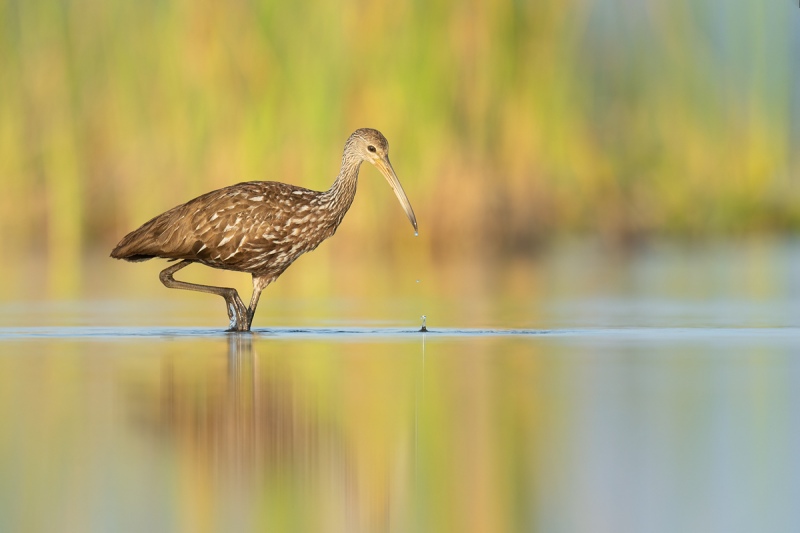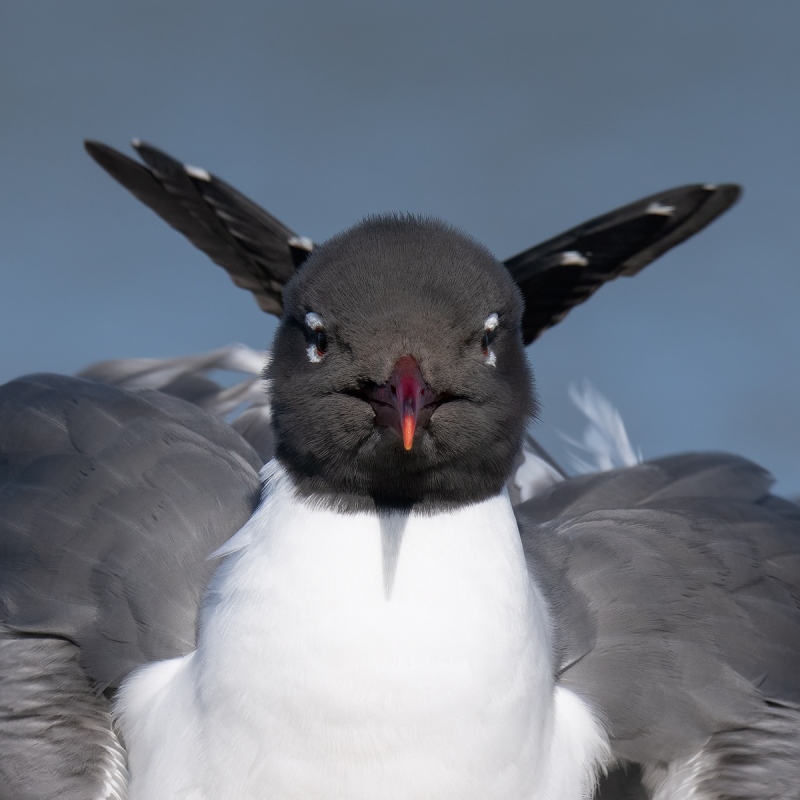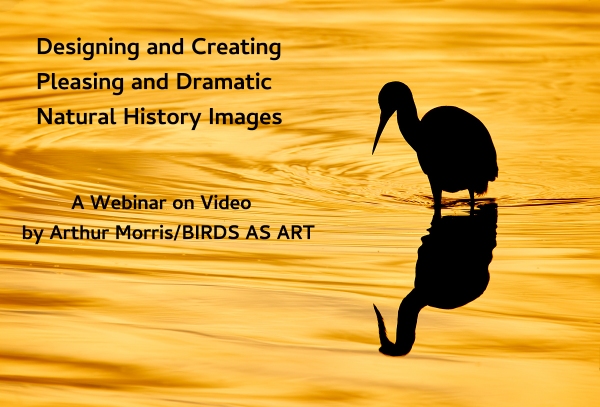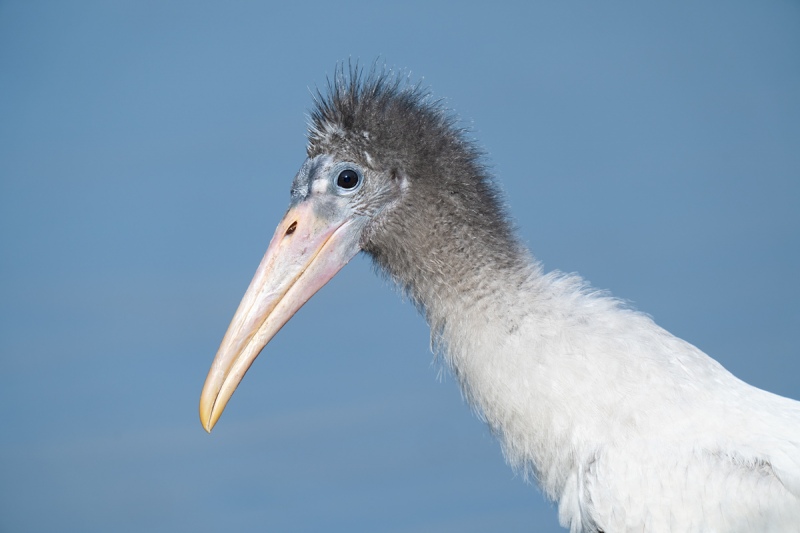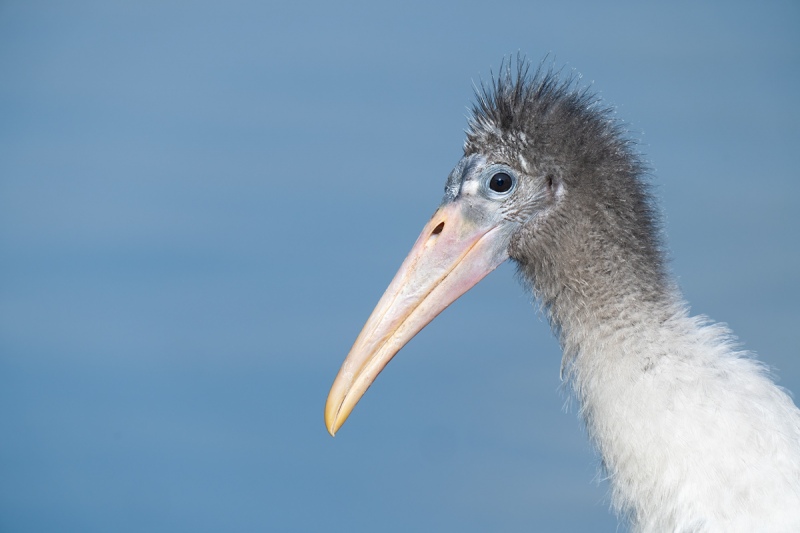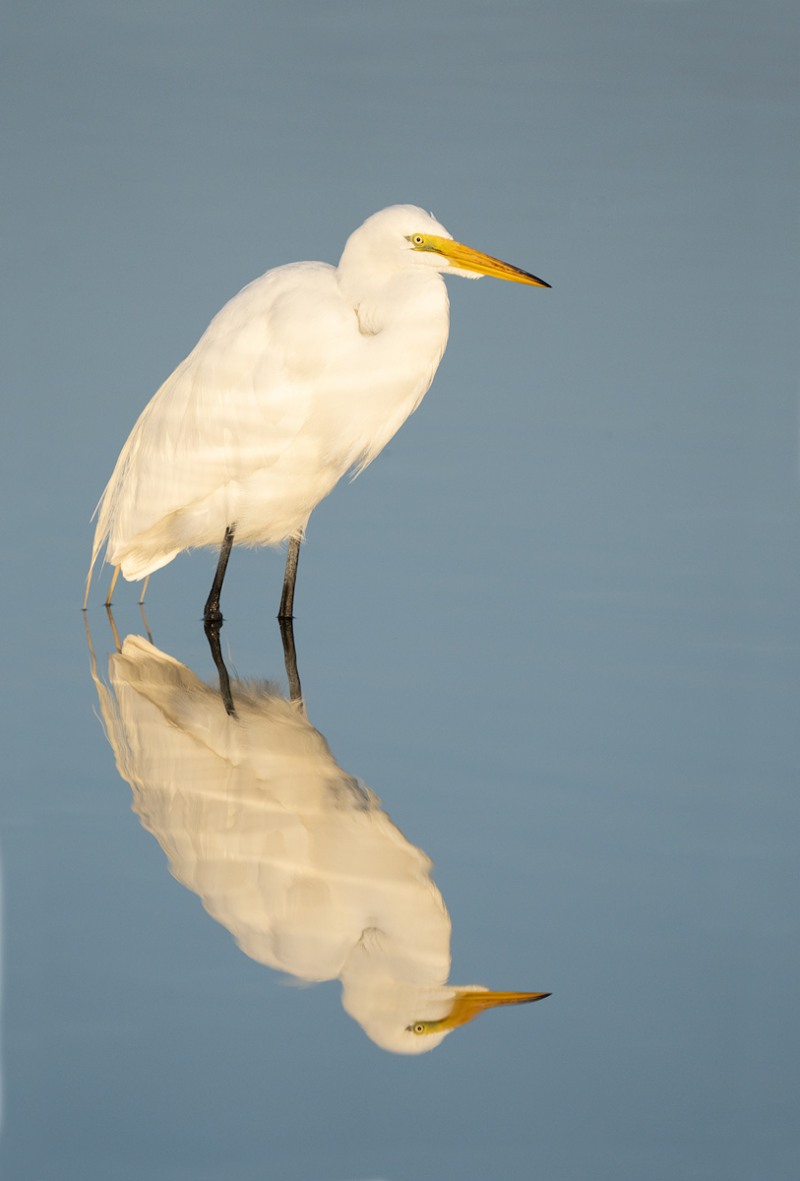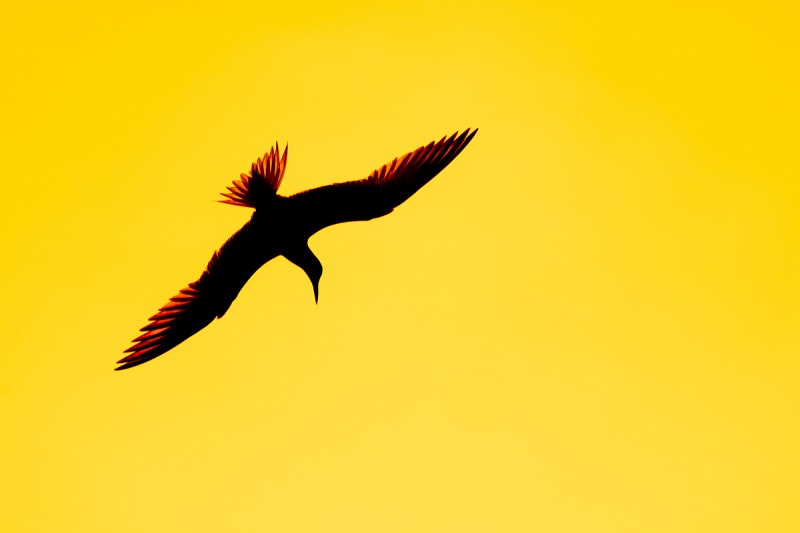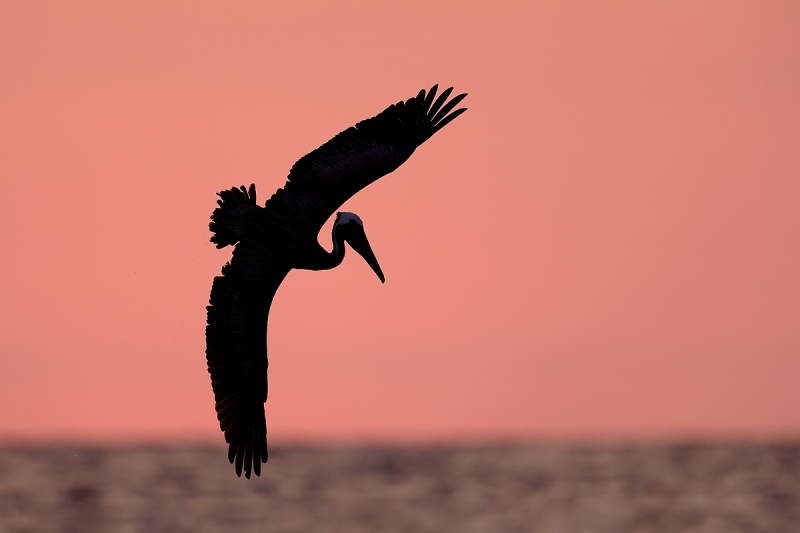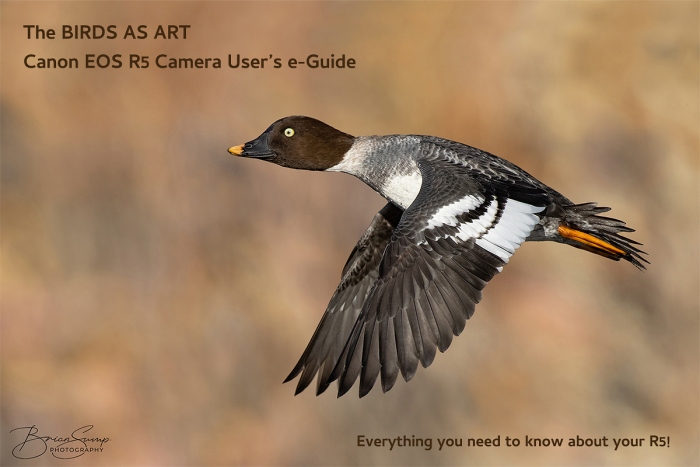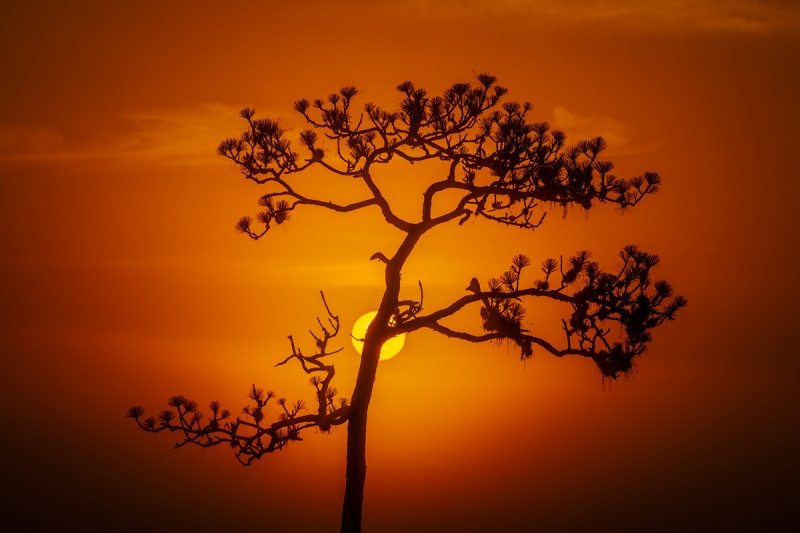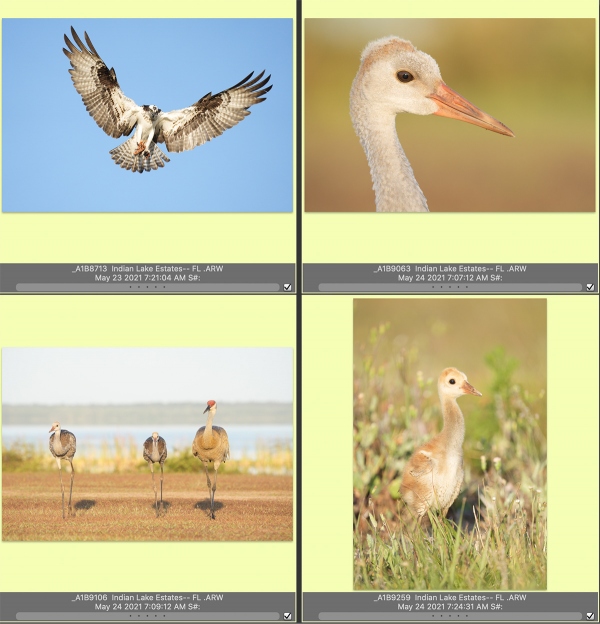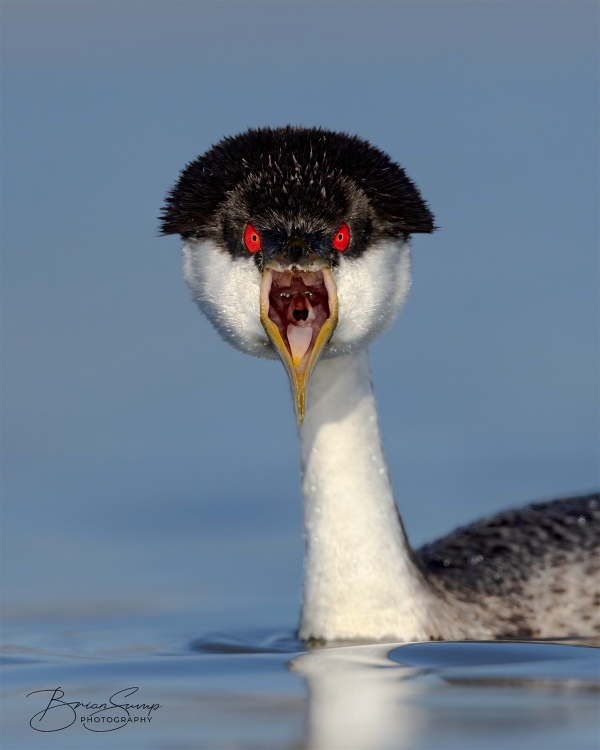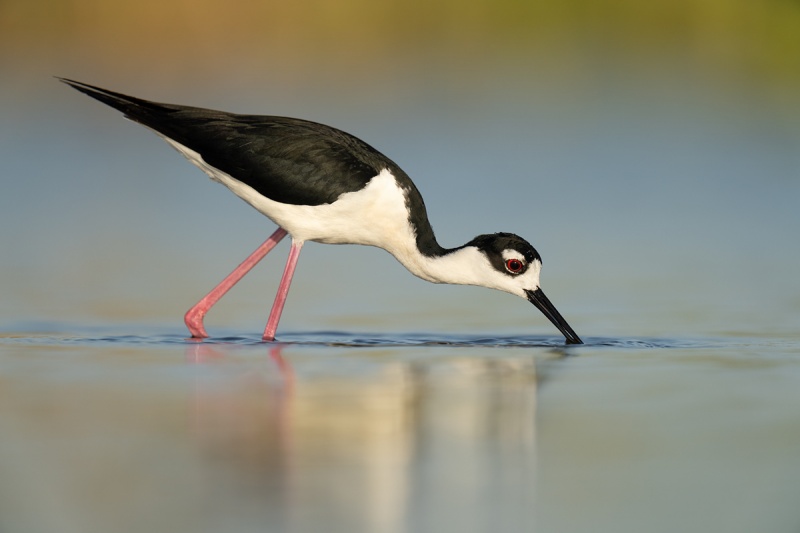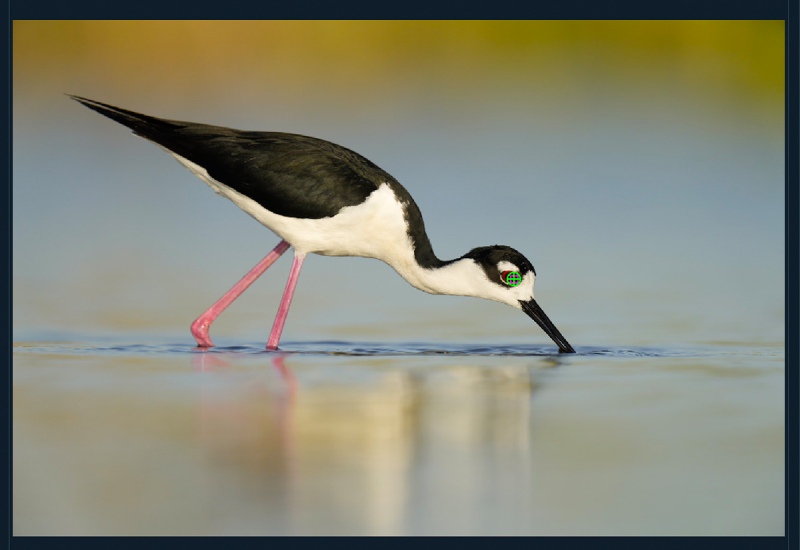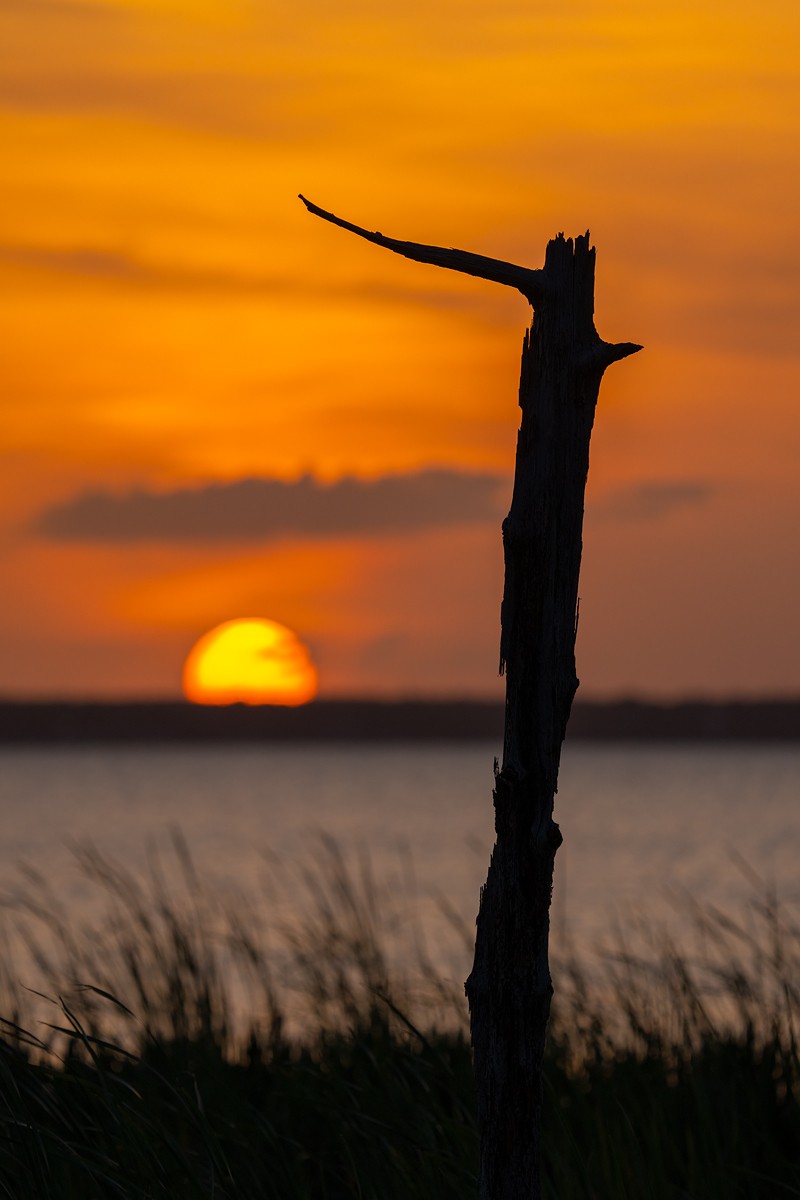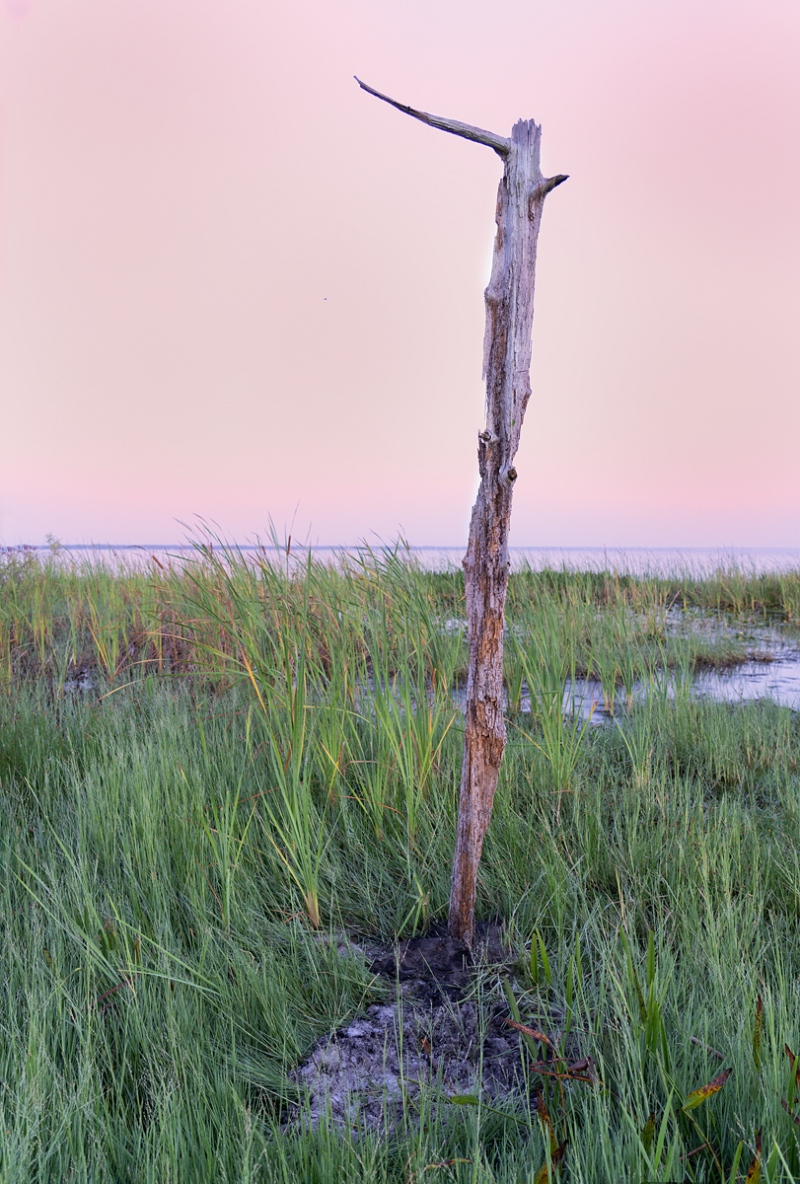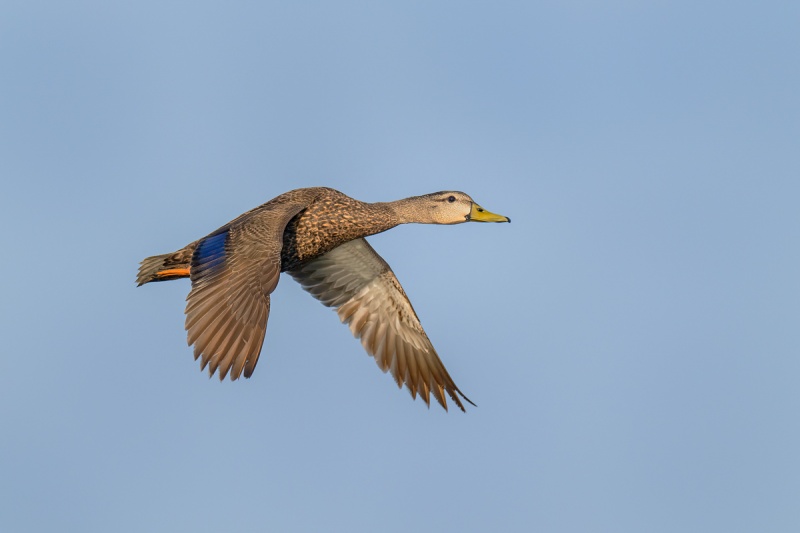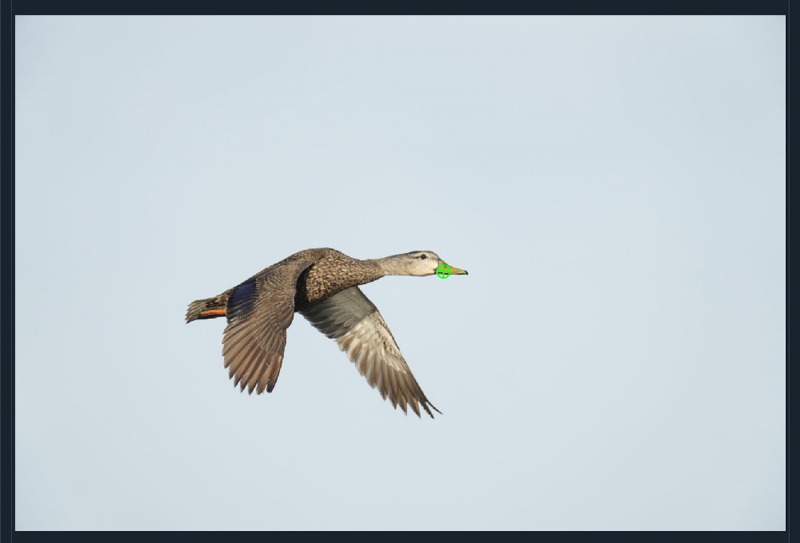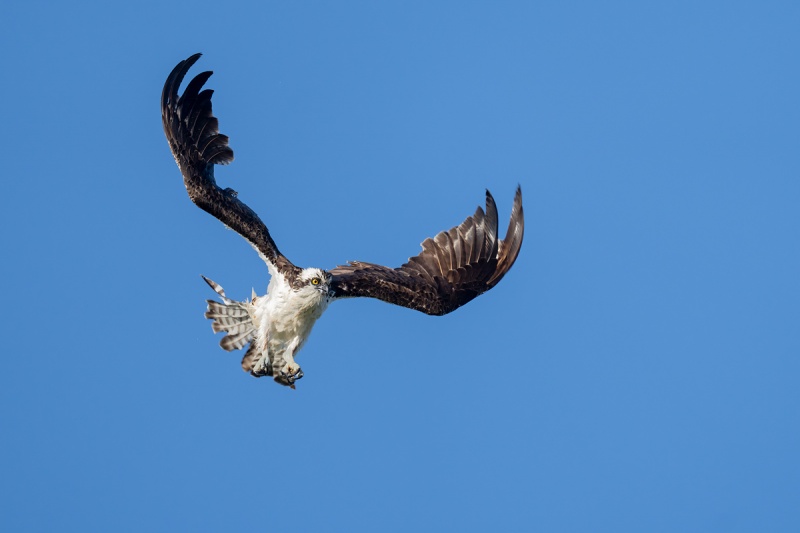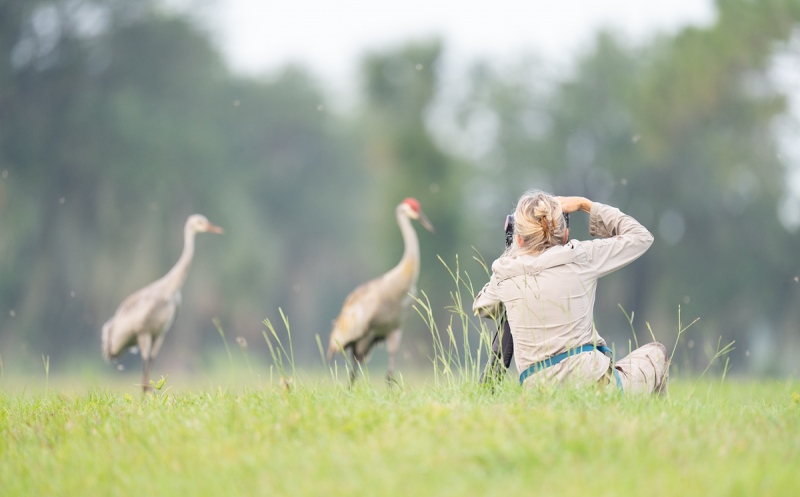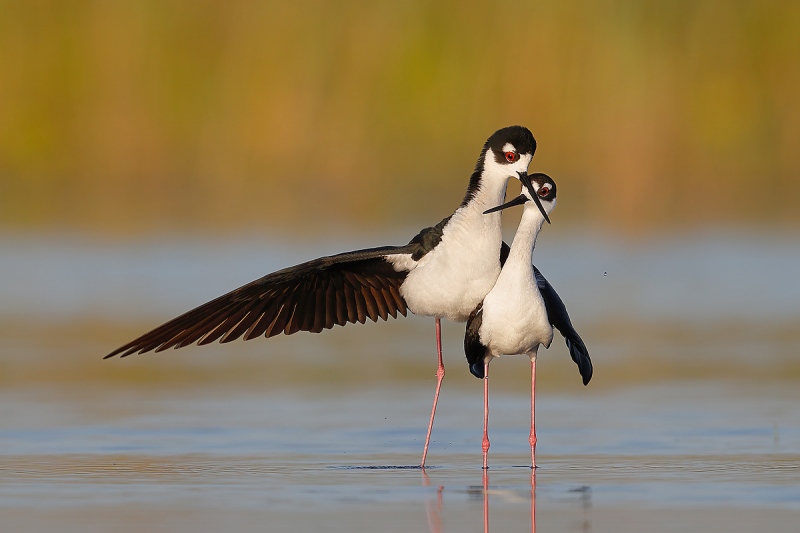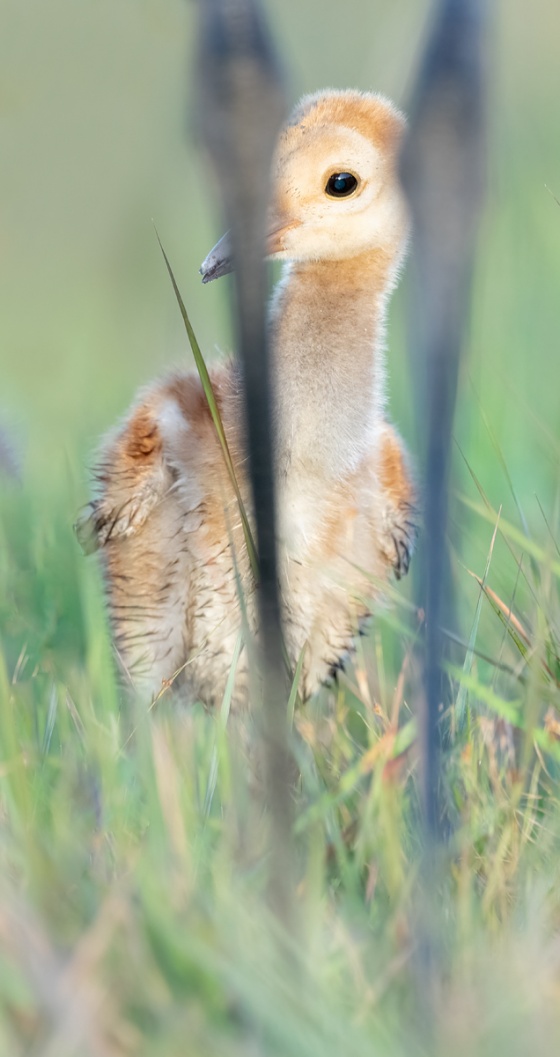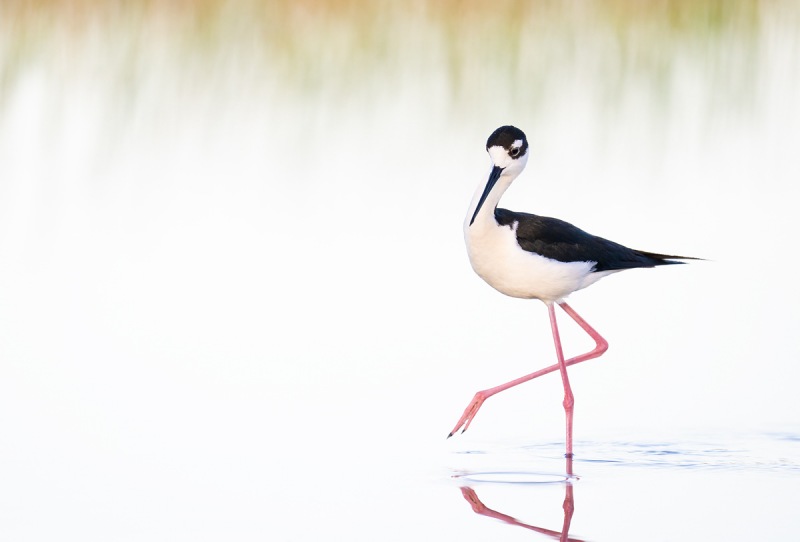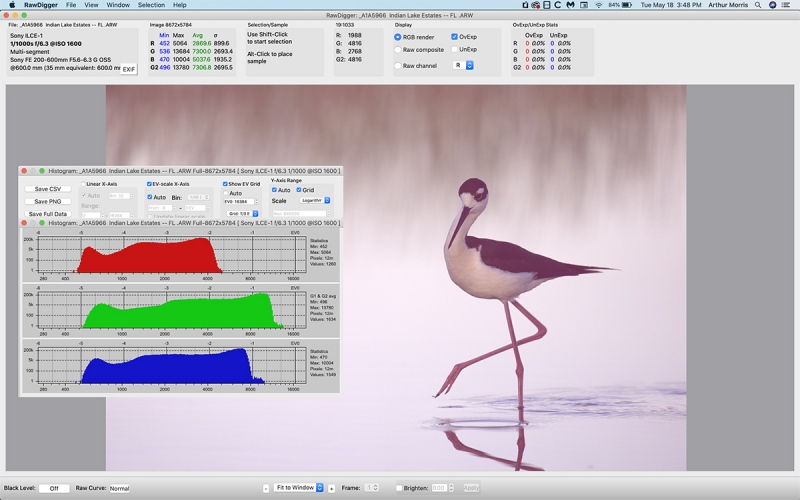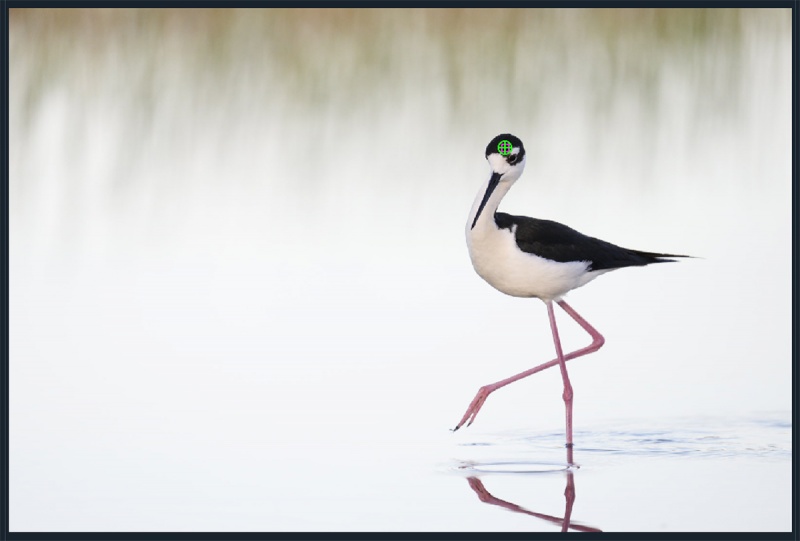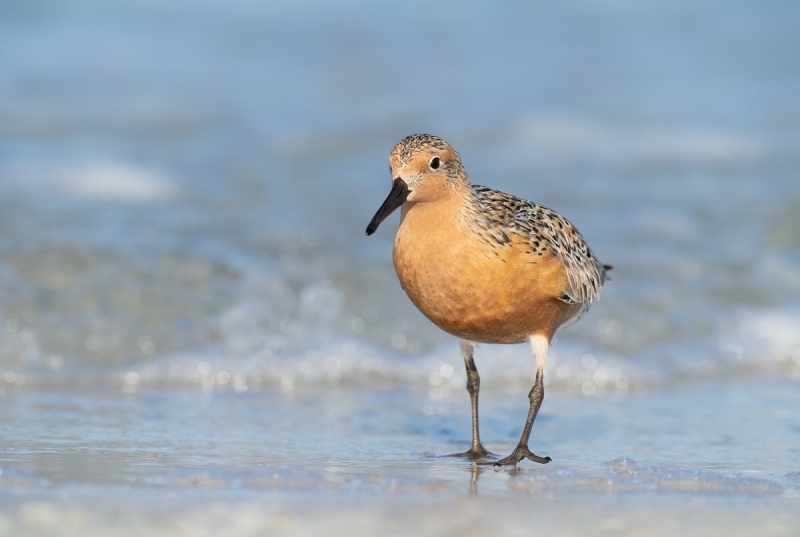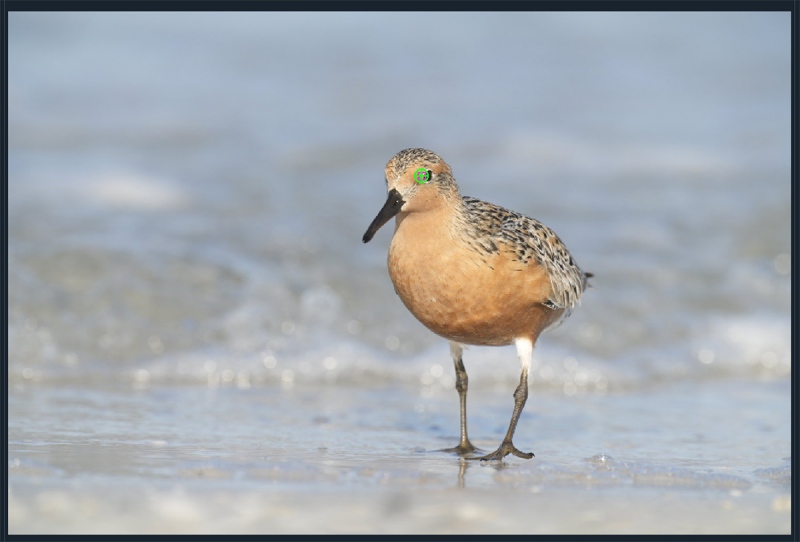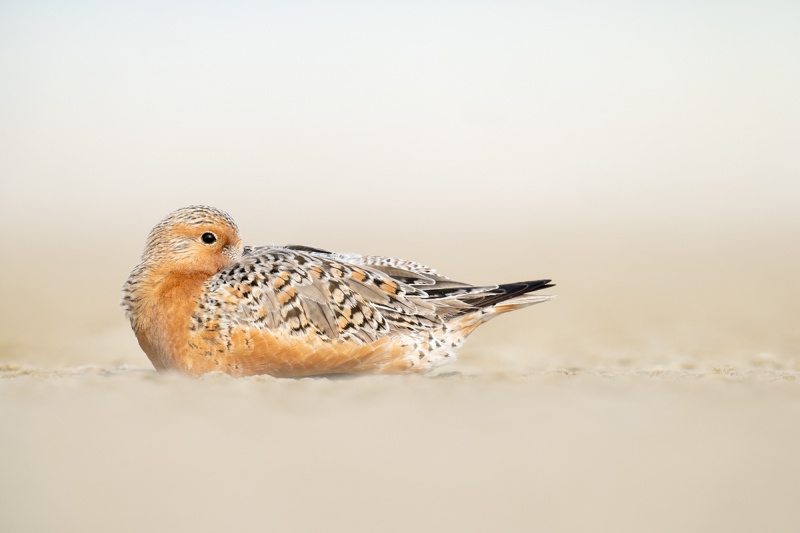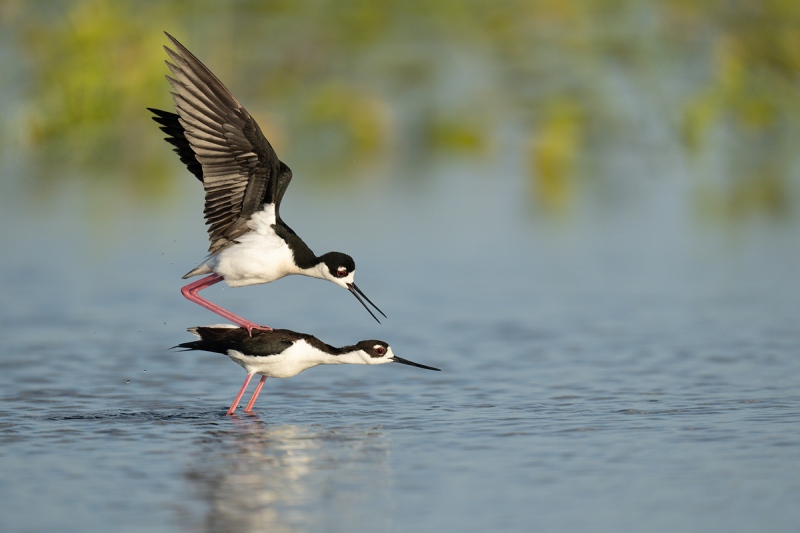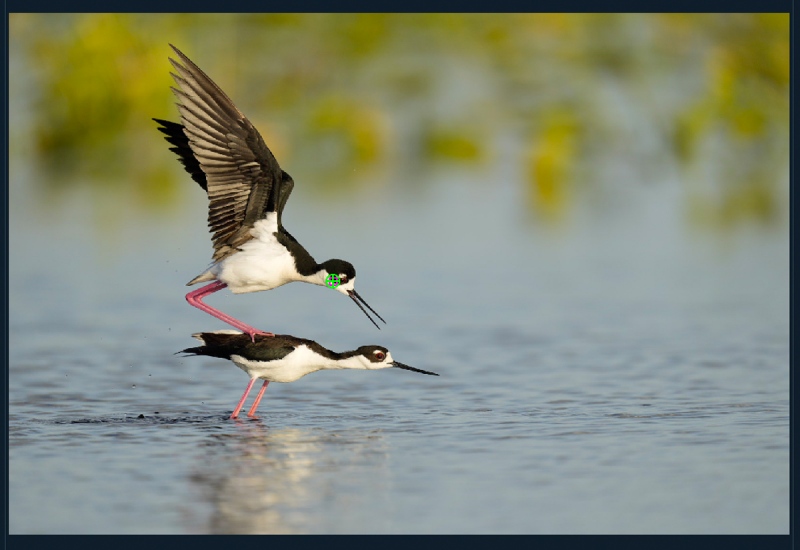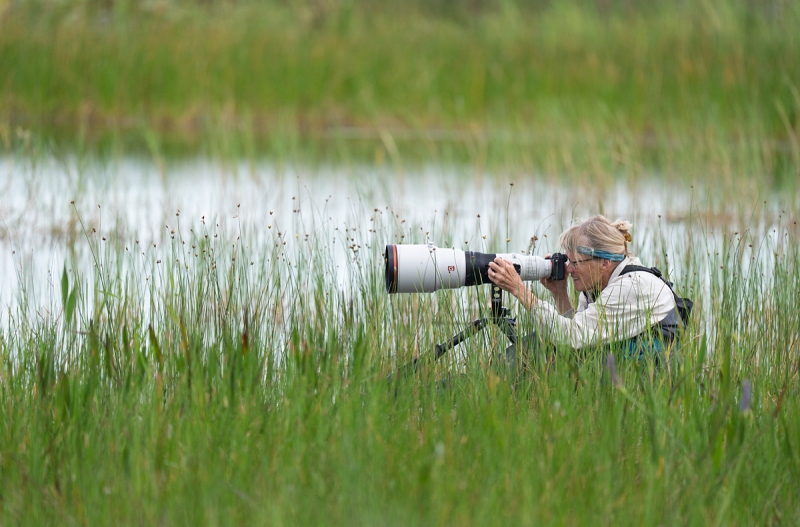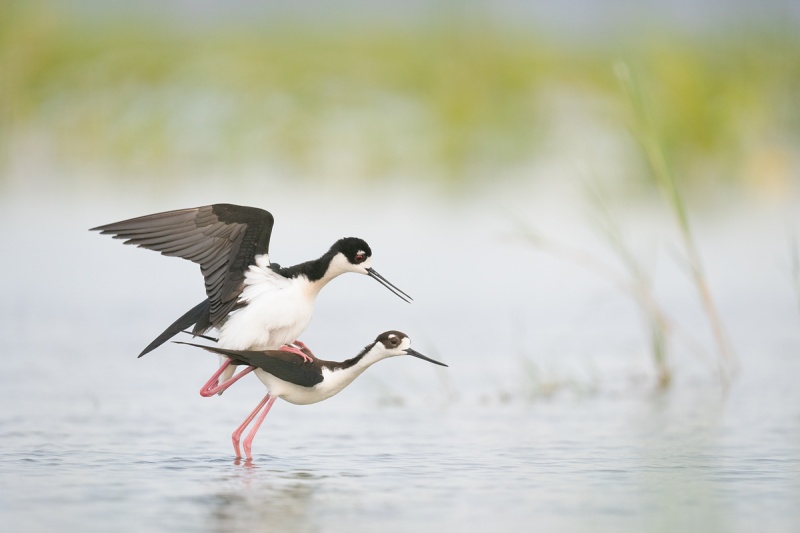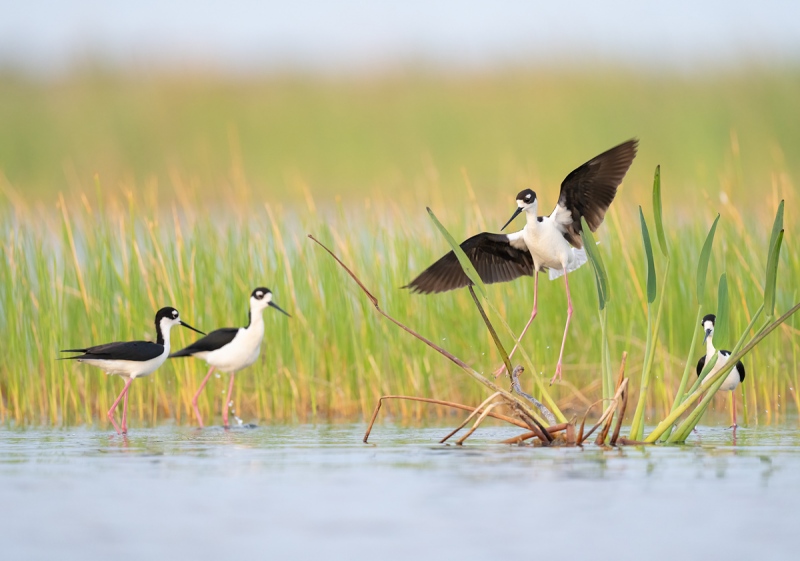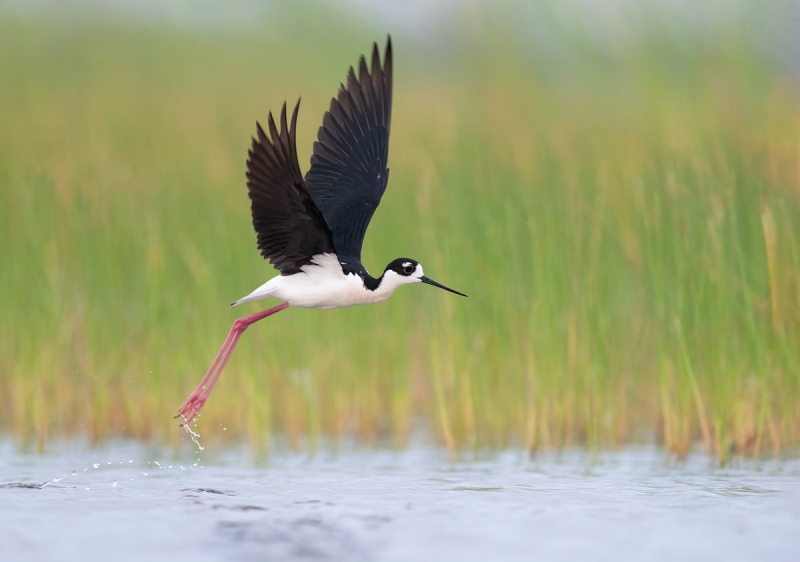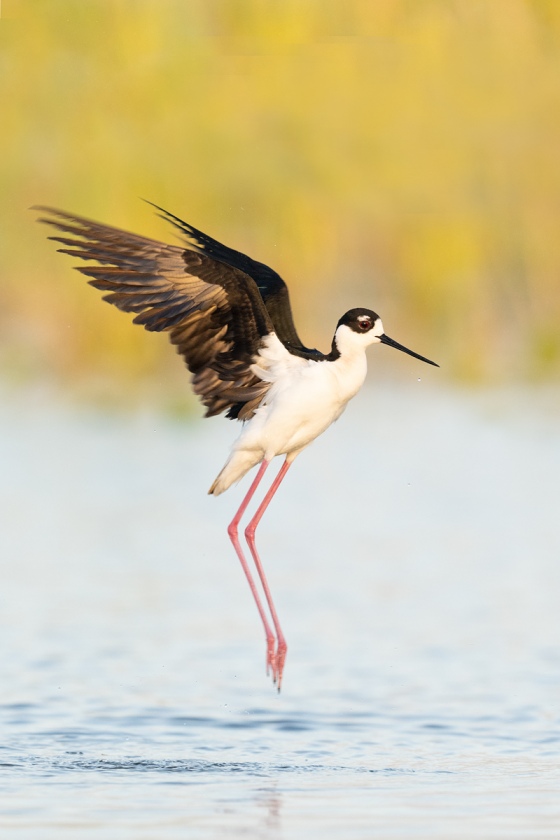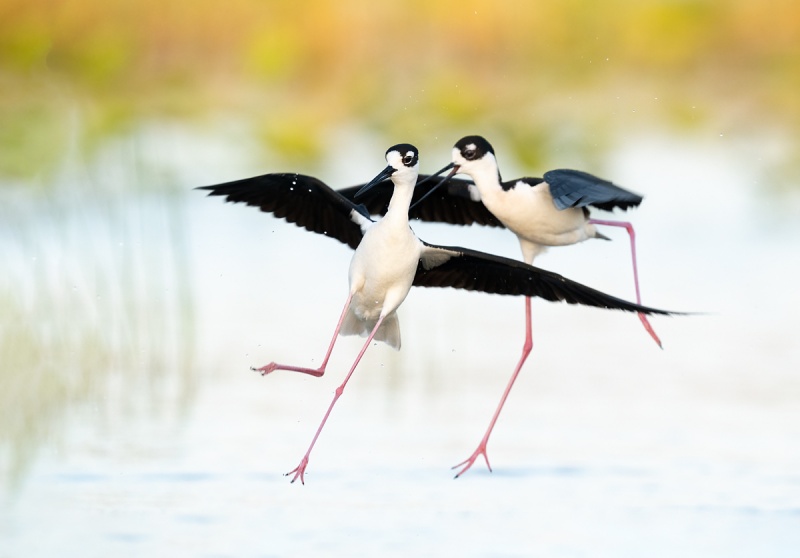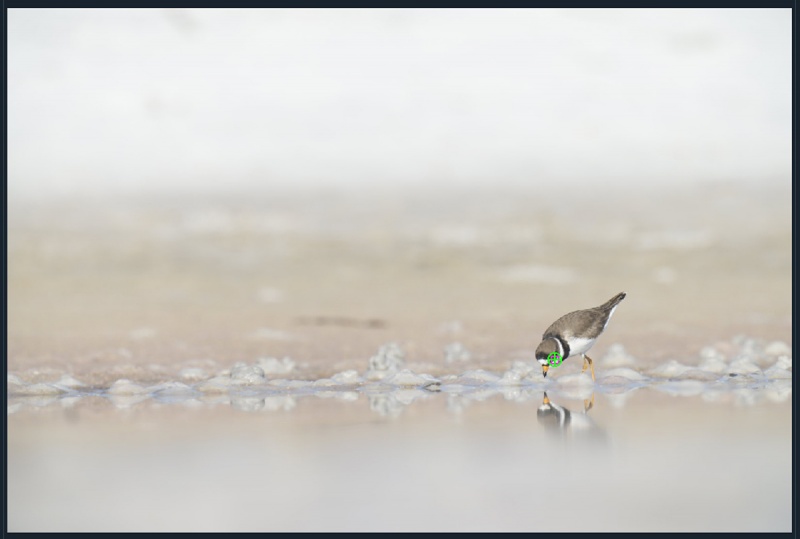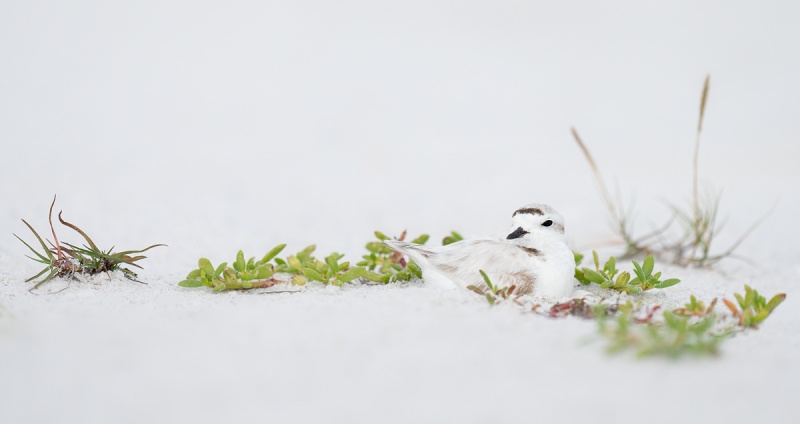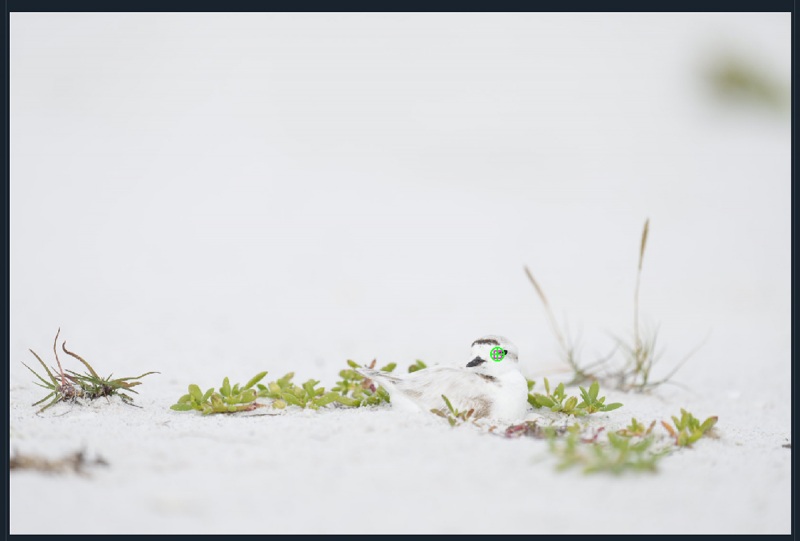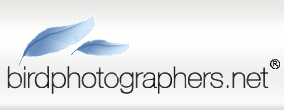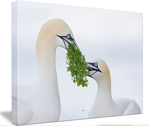June 3rd, 2021 What’s Up?
I did much better than expected on Wednesday morning. I made a few nice vertical frames of one of the stilts on clean green vegetation when I went to check on the plain nest; it now has a complete clutch of four eggs. The last time I checked, the beautiful nest had two eggs. I made one nice image of an Osprey with a whole fish, several of one of the two crane colts, and a few more of a preening adult.
Today is Thursday 3 June 2021. The forecast for this morning is for partly cloudy skies with a faint breeze from the southeast. It is 5:25am as I type. I am in Clemens’ truck on the way to Lake Blue Cypress. His flats boat is following closely behind on the trailer. Wherever you are, and whatever you are doing, I hope that you have a great day.
Be sure to check out the foreground clean-up work by comparing Image #1 with screen capture #1B and then scrolling all the way down to the Foreground Sand Clean-up item.
This blog post took about two hours to prepare, and makes 159 consecutive days with a new one. Please remember that if an item — a Delkin flash card, or a tripod head — for example, that is available from B&H and/or Bedfords and is also available in the BAA Online Store, it would be great if you opt to purchase from us. We will match any price. Please remember also to use my B&H affiliate links or to save 3% at Bedfords by using the BIRDSASART discount code at checkout. Doing either often earns you free guides and/or discounts. And doing so always earns my great appreciation.
Selling Your Used Photo Gear Through BIRDS AS ART
Selling your used (or like-new) photo gear through the BAA Blog is a great idea. We charge only a 5% commission. One of the more popular used gear for sale sites charged a minimum of 20%. Plus assorted fees! Yikes. They went out of business. And e-Bay fees are now up to 13%. Please understand that e-Bay prices are bogus. And the same is true of the prices of used gear including my dear friends at B&H and the other mega-outfits. They offer you pennies and then try to sell the stuff to ignorant folks for ridiculously high prices. With their huge international exposure, they occasionally find someone …
The minimum item price here is $500 (or less for a $25 fee). If you are interested, please shoot us an e-mail with the words Items for Sale Info Request cut and pasted into the Subject line :). Stuff that is priced fairly — I offer pricing advice to those who agree to the terms — usually sells. With the pandemic and the down economy, the market had been somewhat depressed, but sales have been brisk for the past few weeks. And over the past year, we have sold many many hundreds of items. Do know that prices of many used items have been dropping steadily. The prices garnered for used Canon gear has tanked completely as demand has dropped tremendously. It is ironic that for decades Canon gear had very strong resale value … Recently, however, the Canon used gear market has shown some signs of life. Prices on used Nikon gear have also dropped as well. You can see all the current bargains here on the Used Gear Page.
Note: all BAA Used Gear sales include insured ground shipping via UPS to lower 48 US addresses only. Others who live elsewhere are invited to e-mail the seller for shipping surcharge info. Sellers should charge you only the difference between shipping to the farthest US location from their home and the charge to a non-lower-48 address.
Canon 100-400mm EF f/4.5-5.6L IS zoom lens (the “Old” 100-400)
Sale Pending at 4:53am!
Multiple IPT veteran Geri Georg is offering a Canon 100-400mm EF f/4.5-5.6L IS zoom lens (the old Canon 100-400) in good to very good condition for a silly-low $299.00 The sale includes the front and rear lens caps, the tripod foot, the carrying case with strap, and insured ground shipping via major courier to lower-40 US addresses only. Your item will not ship until your check clears unless other arrangements are made.
Please contact Geri via e-mail or by phone at 1-970-219-4493 (Mountain time zone).
The original 100-400 is a sharp, amazingly versatile telephoto zoom lens. When I used Canon, I made hundreds of great and sale-able images with this lens (including the front cover of Scott Weidensaul’s book, “Return to Wild America!)” Denise Ippolito loved hers also. Geri’s lens would make a great starter lens for any beginning bird or nature photographer. artie
Canon Extender EF 2X II (teleconverter)
Sale Pending at 4:53am!
Multiple IPT veteran Geri Georg is offering a Canon Extender EF 2X II (teleconverter) in good to very good condition for a very low $79.00. The sale includes the front and rear caps, the carrying pouch, and insured ground shipping via major courier to lower-40 US addresses only. Your item will not ship until your check clears unless other arrangements are made.
Please contact Geri via e-mail or by phone at 1-970-219-4493 (Mountain time zone).
Regular readers know that I have long depended on both teleconverters for much of my bird photography. The series III TCs were designed for the series II super-telephoto lenses but if you have an older EF lens, the series II TCs will perform perfectly well for you (just as they did for me). artie
Sigma 12-24mm EX zoom lens 1:4.5-5.6 DG HSM wide angle zoom lens for Canon EF
Sale Pending at 4:53am!
Multiple IPT veteran Geri Georg is offering a Sigma 12-24mm EX zoom lens 1:4.5-5.6 DG HSM wide angle zoom lens in good to very good condition for Canon EF for a very low $199.00. The sale includes the rear lens cap, a LensCoat neoprene hoodie front lens protector (small), and insured ground shipping via major courier to lower-40 US addresses only. Your item will not ship until your check clears unless other arrangements are made.
Please contact Geri via e-mail or by phone at 1-970-219-4493 (Mountain time zone).
This super-wide angle has a large variable angle of view from 122° super wide-angle (at 12mm/diagonal axis) to 84.1°. The low dispersion glass elements enable effective correction of color aberration, a common problem with super-wide angle lenses. For use with Canon cameras. This lens sells used on Amazon for $399.00. artie
|
|
|
This image was created on 1 June 2021 down by the lake at ILE. While seated, I used the hand held Sony FE 200-600mm f/5.6-6.3 G OSS lens (at 600mm) and The One, the Sony Alpha 1 Mirrorless digital camera. ISO 800. Exposure determined via Zebras with ISO on the rear dial: 1/1600 sec. at f/6.3 (wide open) in Manual mode. AWB at 7:59am on a dead-clear morning.
Wide/AF-C was active at the moment of exposure and performed as expected: perfectly. Click on the image to see a larger version.
Image #1: Sandhill Crane, large colt resting — looking at bee
|
The Situation and the Strategy
There is one large hill adjacent to the parking lot to the right of the pier. I have made some very good images of cranes on that hill. And there is also a small mound adjacent to the parking lot. I was in the driver’s seat of my SUV when I saw this young crane resting on the small rise. Rather than shoot it from the car, I opened the driver’s side door very slowly so as not to scare the bird and have it stand up. I got on the ground with the 2-6 and scootched to my right on my butt to get on sun angle. I was not thrilled with the pier in the upper background but I did not want to get higher to eliminate it (in fear of causing the bird to stand up). I was pleasantly surprised to see the bee in the frame as I edited the folder, i.e, picked my keepers. And I am pretty sure that the crane colt did not see it either.
Why are even small hills, mounds, rises, and ridges ideal for bird photography? Because they often allow you to effectively move the background far from the subject thus throwing the background nicely out of focus. As was the case with today’s featured images. Be on the lookout for birds on small rises or edges. Then get low and go to work. You can control the look of the background by carefully choosing your perspective.
|
|
Image #1A: RawDigger adapted histogram for the Sandhill Crane, large colt resting — looking at bee image
|
The RawDigger Adapted Histogram
Note here that the bulk of the G channel data makes it 2/3rds of the way from the 8000 line to the 16000 line. The tiny spikes right at the 16000 line in all three channels, R, G, & B depict the 27 OvExp pixels, those from the specular highlights in the bird’s eye. Those out of 51,000,000. This histogram shows what I would call a perfect exposure. If the bulk of the data makes it right to the 16000 line without any significant numbers of OvExp pixels, that would be a dead-solid perfect exposure. I try to aim only for “perfect” to be sure of avoiding any serious over-exposures.
Via e-Mail from Geri George
Hi Artie, Thanks for the RawDigger e-Guide. With many of my flower images, DPP shows lots of over-exposure on the petals, but RawDigger shows only a smattering (less than a hundred) of over-exposed pixels. They all converted perfectly in DPP 4 simply by pulling down the Highlight slider a bit. RawDigger has some really cool stuff!
Thanks and best, Geri
|
|
RawDigger e-Guide with Two Videos
|
The RawDigger e-Guide with Two Videos
by Arthur Morris with Patrick Sparkman
The RawDigger e-Guide was created only for serious photographers who wish to get the absolute most out of their raw files.
Patrick and I began work on the guide in July 2020. At first we struggled. We asked questions. We learned about Max-G values. We puzzled as to why the Max G values for different cameras were different. IPT veteran Bart Deamer asked lots of questions that we could not answer. We got help from RawDigger creator Iliah Borg. We learned. In December, Patrick came up with an Adapted Histogram that allows us to evaluate the exposures and raw file brightness for all images created with all digital camera bodies from the last two decades. What we learned each time prompted three complete beginning to end re-writes.
The point of the guide is to teach you to truly expose to the mega-Expose-to-the-Right so that you will minimize noise, maximize image quality, best utilize your camera’s dynamic range, and attain the highest possible level of shadow detail in your RAW files in every situation. In addition, your properly exposed RAW files will contain more tonal information and feature the smoothest possible transitions between tones. And your optimized images will feature rich, accurate color.
We teach you why the GREEN channel is almost always the first to over-expose. We save you money by advising you which version of RawDigger you need. We teach you how to interpret the Max G values for your Canon, Nikon, and SONY camera bodies. It is very likely that the Shock-your-World section will shock you. And lastly — thanks to the technical and practical brilliance of Patrick Sparkman — we teach you a simple way to quickly and easily evaluate your exposures and raw file brightness using an Adapted RawDigger histogram.
The flower video takes you through a session where artie edits a folder of images in Capture One while checking the exposures and Max-G values in RawDigger. The Adapted Histogram video examines a series of recent images with the pink histograms and covers lots of fine points including and especially how to deal with specular highlights. The directions for setting up the Adapted Histogram are in the text.
If we priced this guide based on how much effort we put into it, it would sell it for $999.00. But as this guide will be purchased only by a limited number of serious photographers, we have priced it at $51.00. You can order yours here in the BAA Online Store.
|
|
Image #1B: AF point for the Sandhill Crane, large colt resting — looking at bee image
|
One Amazing Thing …
One amazing thing — as explained in the a1 Info and Updates e-mails, is that the AF system of the a1 — when set up correctly, will actually detect a bird’s eye before you half-press the shutter button . And to think that I’d always dreamed of science-fiction-like autofocus …
Sony Alpha a1 AF
Barring operator error, the performance of the Sony Alpha a1 AF system at any focal length — including 1200mm as seen in recent blog posts — is, when the a1 is set up properly as detailed in the in e-mails to the Sony Alpha a1 Info & Updates group, more than remarkable. Early on, there was lots of discussion within the group with many preferring multiple back button approaches. For me a simple shutter button approach with the right AF settings that yield 99% sharp-on-the-eye images is best. By far. It is super-simple and mega-effective. In the next SONY Alpha a1 Set-up and Info Group e-mail, I will be sharing what I have learned as to when and in what situations it is best to abandon Wide. And with what. The group has already learned to limit the AF Area choices and to switch AF Areas quickly and conveniently. The default method of switching AF points with the C2 button is both slow and cumbersome.
SONY Alpha a1 Set-up and Info Group
The SONY Alpha a1 Set-up and Info Group is going great guns as folks chime in with thoughtful questions and experience-based advice. We are now up to an astounding 46 lucky folks. Early on, we discussed the myriad AF options. I gave my opinion as to the best one for flight and general bird photography. More recently, we have been in contact with folks at SONY sharing our thoughts, experiences, and frustrations with the EVF blackout problem.
All who purchased their Alpha a1 bodies via a BAA affiliate link will receive a free subscription to the Sony Alpha a1 Set-Up and Info Updates after shooting me their receipts via e-mail. (Note: it may take me several days to confirm B&H orders.) This same service may be purchased by anyone with an a1 body via a $150.00 PayPal sent to birdsasart@verizon.net indicating payment for Alpha a1 Info Updates. Alternatively, folks can call Jim weekdays at 1-863-692-0906 to pay via credit card. New members will receive composite e-mails that summarize all previous discussions.
Foreground Sand Clean-up
The small areas of white sand in the foreground were distracting. I went with my usual cadre of clean-up tools in Photoshop. Those included the Patch Tool and Content Aware Fill. Note that I did not use the Clone Stamp at all. To smooth out the results, the final step was a 64 pixel Gaussian blur painted in as needed using an Inverse or Black Layer Mask.
|
|
The BIRDS AS ART Current Workflow e-Guide (Digital Basics II).
You can order your copy from the BAA Online Store here, by sending a PayPal for $40 here, or by calling Jim or Jennifer weekdays at 863-692-0906 with your credit card in hand. Be sure to specify Digital Basics II.
|
The BIRDS AS ART Current Workflow e-Guide (Digital Basics II)
The clean-up techniques mentioned above and tons more great Photoshop tips and techniques — along with all of my personalized Keyboard Shortcuts — are covered in detail in the BIRDS AS ART Current Workflow e-Guide (Digital Basics II), an instructional PDF that is sent via e-mail. Learn more and check out the free excerpt in the blog post here. While the new e-Guide reflects my MacBook Pro/Photo Mechanic/DPP 4/Photoshop workflow, folks using a PC and/or BreezeBrowser will also benefit greatly by studying the material on DB II. Note: folks working on a PC and/or those who do not want to miss anything Photoshop may wish to purchase the original Digital Basics along with DB II while saving $15 by clicking here to buy the DB Bundle.
Folks who learn well by following along rather than by reading can check out the complete collection of MP 4 Photoshop Tutorial Videos by clicking here. Note: all of the videos are now priced at an amazingly low $5.00 each.
You can learn how and why I converted all of my Canon digital RAW files in DPP 4 in the DPP 4 RAW Conversion Guide here. More recently, I became proficient at converting my Nikon RAW (NEF) files in Adobe Camera Raw. About two years ago I began converting my Nikon and Sony RAW files in Capture One Pro 12 and continue to do so today.
To purchase Capture One, please use this link. Then you can learn more about Capture One in the Capture One Pro 12 Simplified MP4 Video here. The next step would be to get a copy of Arash Hazeghi’s “The Nikon Photographers’ Guide to Phase One Capture One Pro e-Guide” in the blog post here.
You can learn advanced Quick Masking and advanced Layer Masking techniques in APTATS I & II. You can save $15 by purchasing the pair.
Typos
With all blog posts, feel free to e-mail or to leave a comment regarding any typos or errors.
June 2nd, 2021 Your Favorite?
Which of today’s two featured images do you like best? Why?
What’s Up?
Same old, same old. Conditions were perfect on Tuesday morning, but there was not much to photograph. Both pairs of Black-necked Stilts are incubating their clutches now. The pretty nest has a second egg. With one adult sitting on the eggs, the other feeds at quite a distance from their nest. The crane families are all doing fine.
Today is Wednesday 2 June 2021. The forecast for this morning is for cloudy with a good chance of drizzle. I may try to do some flowers … Wherever you are, and whatever you are doing, I hope that you have a great day.
This blog post took about an hour to prepare, and makes 158 consecutive days with a new one. Please remember that if an item — a Delkin flash card, or a tripod head — for example, that is available from B&H and/or Bedfords and is also available in the BAA Online Store, it would be great if you opt to purchase from us. We will match any price. Please remember also to use my B&H affiliate links or to save 3% at Bedfords by using the BIRDSASART discount code at checkout. Doing either often earns you free guides and/or discounts. And doing so always earns my great appreciation.
Huguenot Memorial Park and/or Jacksonville Nesting Beaches Info Requested
If you photograph regularly at Huguenot Memorial Park and/or any of the other of the publicly accessible beaches north of Jacksonville that have nesting Laughing Gull, Royal and Sandwich Terns, and possibly Brown Pelican, please get in touch via e-mail or call or text me at 863-221-2372.
Please Remember
With income from IPTs now close to zero, please, if you enjoy and learn from the blog, remember to use one of my two affiliate programs when purchasing new gear. Doing so just might make it possible for me to avoid having to try to get a job as a Walmart greeter and will not cost you a single penny more. And if you use Bedfords and remember to enter the BIRDSASART code at checkout, you will save 3% on every order and enjoy free second-day air shipping. In these crazy times — I am out at least forty to sixty thousand dollars so far due to COVID 19 (with lots more to come) — remembering to use my B&H link or to shop at Bedfords will help me out a ton and be greatly appreciated. Overseas folks who cannot order from the US because of import fees, duties, and taxes, are invited to help out by clicking here to leave a blog thank you gift if they see fit.
New and Better Bedfords Discount Policy!
You can now save 3% on all of your Bedfords photo gear purchases by entering the BIRDSASART coupon code at checkout. Your discount will be applied to your pre-tax total. In addition, by using the code you will get 2nd day air shipping via Fed Ex.
Grab a Nikon AF-S Teleconverter TC-14E III and save $14.99. Purchase a Canon EOS R5 and your discount will be $116.97. Purchase a Sony FE 600mm f/4 GM OSS lens and save a remarkable $389.94! Your Bedford’s purchase no longer needs to be greater than $1,000.00 for you to receive a discount. The more you spend, the more you save.
Money Saving Reminder
Many have learned that if you need a hot photo item that is out of stock at B&H and would enjoy free second-day air shipping, your best bet is to click here, place an order with Bedfords, and enter the coupon code BIRDSASART at checkout. If an item is out of stock, contact Steve Elkins via e-mail or on his cell phone at (479) 381-2592 (Central time). Be sure to mention the BIRDSASART coupon code and use it for your online order to save 3% and enjoy free 2nd-day air shipping. Steve has been great at getting folks the hot items that are out of stock at B&H and everywhere else. The wait lists at the big stores can be a year or longer for the hard to get items. Steve will surely get you your gear long before that. For the past year, he has been helping BAA Blog folks get their hands on items like the SONY a9 ii, the SONY 200-600 G OSS lens, the Canon EOS R5, the Canon RF 100-500mm lens, and the Nikon 500mm PF. Steve is personable, helpful, and eager to please.


Gear Questions and Advice
Too many folks attending BAA IPTs (remember those?) and dozens of photographers whom I see in the field and on BPN, are–out of ignorance–using the wrong gear especially when it comes to tripods and more especially, tripod heads… Please know that I am always glad to answer your gear questions via e-mail.
In the It’s a Start — Limpkin with Chick blog post here, I shared an image of a Limpkin chick huddled below one parent waiting to be fed. The next day I returned hoping to do better. I did. Much. One of the images that I wanted was one of a single Limpkin chick all by its lonesome. Since the Limpkin families, including and especially this one, are notoriously shy I started and ended my quest at 1200mm. In any case, mission accomplished.
|
|
Image #1A: AF point for the Limpkin chick image
|
You Gotta-Be-Kidding-Me AF Performance
Perfect eye-tracking at 1200mm is something I could not even have dreamed of. Coming soon: the things I hate about the world’s best bird photography camera body.
Viveza
I am continuing to use Viveza and am getting better at it. I will be doing a basics video on it soon. With both of today’s featured images, I used it to juice up the BLUEs in the water. You can see that best by comparing the color tone of the water in Image #1 with the color tone of the water in the screen capture (in #1A). The latter reflects the original.
In the second image, I used Viveza to tone down the YELLOWs and the GREENs in the BKGR.
Wearing My Glasses
When I am sitting on the milk crate working off the rear screen with the lens just inches above the water, wearing my reading glasses enables me to get a fairly good look at the screen. But from a distance of about 18 inches I cannot see the tiny, green Eye AF box. But a1 AF is so good that I have no trouble trusting the system.
I will be sharing several additional images from the Great Limpkin Morning here at some point.
Sony Alpha a1 AF
Barring operator error, the performance of the Sony Alpha a1 AF system at any focal length — including at 1200mm as seen in recent blog posts — is, when the a1 is set up properly as detailed in the in e-mails to the Sony Alpha a1 Info & Updates group, more than remarkable. Early on, there was lots of discussion within the group with many preferring multiple back button approaches. For me a simple shutter button approach with the right AF settings that yield 99% sharp-on-the-eye images is best. By far. It is super-simple and mega-effective. In recent SONY Alpha a1 Set-up and Info Group e-mails, I shared what I have learned as to when and it what situations it is best to abandon Wide. And with what. The group has already learned to limit the AF Area choices and to switch AF Areas quickly and conveniently. The default method of switching AF points with the C2 button is both slow and cumbersome. In addition, recent e-mails have detailed the best program to use to pick your a1 keepers and the big problem with the Camera Set. Memory menu item.
SONY Alpha a1 Set-up and Info Group
The SONY Alpha a1 Set-up and Info Group is going great guns as folks chime in with thoughtful questions and experience-based advice. We are now up to an astounding 49 blessed folks. Early on, we discussed the myriad AF options. I gave my opinion as to the best one for flight and general bird photography. More recently, we have been in contact with folks at SONY sharing our thoughts, experiences, and frustrations with the EVF blackout problem.
All who purchased their Alpha a1 bodies via a BAA affiliate link will receive a free subscription to the Sony Alpha a1 Set-Up and Info Updates after shooting me their receipts via e-mail. (Note: it may take me several days to confirm B&H orders.) This same service may be purchased by anyone with an a1 body via a $150.00 PayPal sent to birdsasart@verizon.net indicating payment for Alpha a1 Info Updates. Alternatively, folks can call Jim weekdays at 1-863-692-0906 to pay via credit card. New members will receive composite e-mails that summarize all previous discussions.
Typos
With all blog posts, feel free to e-mail or to leave a comment regarding any typos or errors.
June 1st, 2021 What’s Up?
Despite absolutely perfect conditions, Monday morning was close to a bust. For about two weeks, I had been creating between 850 (on a bad day) and 2800 images (on a good day) in a single session. On the last morning of May, I headed down in hopes of creating a few killer head shots of one of the stilts. I set up well away from the nest. The female walked back to the nest, sat down on her 3-egg clutch, and stayed put even after I packed up my milk crate and left. The male walked in front of me just once and I came away with one decent head portrait. That in contrast with the previous day: when the crane family walked by the nest the frantic male landed right in front on me and posed for ten minutes at point blank range. But I only had the 200-600 with me … I checked on the three crane families; all was well. I took a ride around looking for some good flowers, but it was one of those days …
I finally finished the second edit of the APRIL 2021 folder: 480 keepers remained out of more than 2500 first edit survivors. May is next.
Today is Tuesday 1 June 2021.The forecast for ILE for this morning is a carbon copy of Monday’s weather: clear with a light breeze from the southeast. I have a new plan for my morning photo session. GNPA friend Eric Boles invited me to do a webinar for the Nikonian Speaker Series on June 15; I need to get to work on that and will begin today. Wherever you are, and whatever you are doing, I hope that you have a great day.
This blog post took more than an hour to prepare, and makes 157 consecutive days with a new one. Please remember that if an item — a Delkin flash card, or a tripod head — for example, that is available from B&H and/or Bedfords and is also available in the BAA Online Store, it would be great if you opt to purchase from us. We will match any price. Please remember also to use my B&H affiliate links or to save 3% at Bedfords by using the BIRDSASART discount code at checkout. Doing either often earns you free guides and/or discounts. And doing so always earns my great appreciation.
ILE In-the-Field Sessions
Sandhill Crane colts and small chicks guaranteed!
Any morning from now til …
2-hour session (6:30 to 8:30am): $300.00/session
The crane colts family and the crane chicks family continue to be utterly dependable. Join me for a morning at Indian Lake Estates with a money-back guarantee: if we do not get to photograph either the colts and/or the chicks at close range, you will get every penny back. Point blank Black-necked Stilts are guaranteed as well.
Lodging and Photoshop lessons available. If you are seriously interested in joining me for one or more sessions, get in touch via e-mail or call or text me on my cell at 863-221-2372.
Huguenot Memorial Park and/or Jacksonville Nesting Beaches Info Requested
If you photograph regularly at Huguenot Memorial Park and/or any of the other of the publicly accessible beaches north of Jacksonville that have nesting Laughing Gull, Royal and Sandwich Terns, and possibly Brown Pelican, please get in touch via e-mail or call or text me at 863-221-2372.
Please Remember
With income from IPTs now close to zero, please, if you enjoy and learn from the blog, remember to use one of my two affiliate programs when purchasing new gear. Doing so just might make it possible for me to avoid having to try to get a job as a Walmart greeter and will not cost you a single penny more. And if you use Bedfords and remember to enter the BIRDSASART code at checkout, you will save 3% on every order and enjoy free second-day air shipping. In these crazy times — I am out at least forty to sixty thousand dollars so far due to COVID 19 (with lots more to come) — remembering to use my B&H link or to shop at Bedfords will help me out a ton and be greatly appreciated. Overseas folks who cannot order from the US because of import fees, duties, and taxes, are invited to help out by clicking here to leave a blog thank you gift if they see fit.
New and Better Bedfords Discount Policy!
You can now save 3% on all of your Bedfords photo gear purchases by entering the BIRDSASART coupon code at checkout. Your discount will be applied to your pre-tax total. In addition, by using the code you will get 2nd day air shipping via Fed Ex.
Grab a Nikon AF-S Teleconverter TC-14E III and save $14.99. Purchase a Canon EOS R5 and your discount will be $116.97. Purchase a Sony FE 600mm f/4 GM OSS lens and save a remarkable $389.94! Your Bedford’s purchase no longer needs to be greater than $1,000.00 for you to receive a discount. The more you spend, the more you save.
Money Saving Reminder
Many have learned that if you need a hot photo item that is out of stock at B&H and would enjoy free second-day air shipping, your best bet is to click here, place an order with Bedfords, and enter the coupon code BIRDSASART at checkout. If an item is out of stock, contact Steve Elkins via e-mail or on his cell phone at (479) 381-2592 (Central time). Be sure to mention the BIRDSASART coupon code and use it for your online order to save 3% and enjoy free 2nd-day air shipping. Steve has been great at getting folks the hot items that are out of stock at B&H and everywhere else. The wait lists at the big stores can be a year or longer for the hard to get items. Steve will surely get you your gear long before that. For the past year, he has been helping BAA Blog folks get their hands on items like the SONY a9 ii, the SONY 200-600 G OSS lens, the Canon EOS R5, the Canon RF 100-500mm lens, and the Nikon 500mm PF. Steve is personable, helpful, and eager to please.


Gear Questions and Advice
Too many folks attending BAA IPTs (remember those?) and dozens of photographers whom I see in the field and on BPN, are–out of ignorance–using the wrong gear especially when it comes to tripods and more especially, tripod heads… Please know that I am always glad to answer your gear questions via e-mail.
Laughing Gull as Devil?
We were just about wrapping up our morning when a handsome pair of Laughing Gulls flew in. What the hay? We got down on the ground and went to work. The bird here had just finished bathing and when it ruffled I fired away. One of the amazing things with the a1 is that you do not miss a whole lot with 30 frames per second. Yes, you need to edit ruthlessly but if you know what you are looking for it’s great to have multiple frames to choose from. That said, the crossed tail behind the head was visible in only two frames of a long series.
When photographing walking or foraging birds with a a Panning Ground Pod-mounted lens, the biggest problem is with the-side-to-side framing, getting the bird well back in the frame without clipping the tail. With a bird or birds facing you and standing still, life is much easier. Acquire focus and blast away.
Multiple Choice Crop Quiz
What percentage of the original frame does the optimized TIF file represent (as represented by the JPEG above)?
- a- 11%
- b- 22%
- c- 44%
- d- 66%
- e- 88%
Typos
With all blog posts, feel free to e-mail or to leave a comment regarding any typos or errors.
May 31st, 2021 What’s Up?
As alluded to in the This Just In item in yesterday’s blog post, I had a great 90 minutes in the marsh on Saturday morning. See below for the whole story. I was back home early working on images and catching up on the NBA Playoffs and Jeopardy on Tevo. I swam early and headed down to the lake at about 4:30pm on a cloudy afternoon to check on the stilt nests. The pretty nest still had one egg, and the plain nest, built less than ten yards from where Anita first sat in the marsh, still had three. I read most of the Birds of North America species account for Black-necked Stilt and learned that the average clutch size is four, laying to hatching time is about 23 days, and that the chicks never remain at the nest for more than a day after the last egg hatches. Once they leave, they range widely.
Today is Monday 31 May 2021. The forecast for ILE for this morning is for mostly clear skies with a very gentle southeast wind. I will be headed down to the lake early for what promises to be perfect conditions. Wherever you are, and whatever you are doing, I hope that you have a great day.
This blog post took more than an hour to prepare, and makes 156 consecutive days with a new one. Please remember that if an item — a Delkin flash card, or a tripod head — for example, that is available from B&H and/or Bedfords and is also available in the BAA Online Store, it would be great if you opt to purchase from us. We will match any price. Please remember also to use my B&H affiliate links or to save 3% at Bedfords by using the BIRDSASART discount code at checkout. Doing either often earns you free guides and/or discounts. And doing so always earns my great appreciation.
ILE In-the-Field Sessions
Sandhill Crane colts and small chicks guaranteed!
Any morning from now til …
2-hour session (6:30 to 8:30am): $300.00/session
The crane colts family and the crane chicks family continue to be utterly dependable. Join me for a morning at Indian Lake Estates with a money-back guarantee: if we do not get to photograph either the colts and/or the chicks at close range, you will get every penny back. Point blank Black-necked Stilts are guaranteed as well.
Lodging and Photoshop lessons available. If you are seriously interested in joining me for one or more sessions, get in touch via e-mail or call or text me on my cell at 863-221-2372.
Huguenot Memorial Park and/or Jacksonville Nesting Beaches Info Requested
If you photograph regularly at Huguenot Memorial Park and/or any of the other of the publicly accessible beaches north of Jacksonville that have nesting Laughing Gull, Royal and Sandwich Terns, and possibly Brown Pelican, please get in touch via e-mail or call or text me at 863-221-2372.
Please Remember
With income from IPTs now close to zero, please, if you enjoy and learn from the blog, remember to use one of my two affiliate programs when purchasing new gear. Doing so just might make it possible for me to avoid having to try to get a job as a Walmart greeter and will not cost you a single penny more. And if you use Bedfords and remember to enter the BIRDSASART code at checkout, you will save 3% on every order and enjoy free second-day air shipping. In these crazy times — I am out at least forty to sixty thousand dollars so far due to COVID 19 (with lots more to come) — remembering to use my B&H link or to shop at Bedfords will help me out a ton and be greatly appreciated. Overseas folks who cannot order from the US because of import fees, duties, and taxes, are invited to help out by clicking here to leave a blog thank you gift if they see fit.
New and Better Bedfords Discount Policy!
You can now save 3% on all of your Bedfords photo gear purchases by entering the BIRDSASART coupon code at checkout. Your discount will be applied to your pre-tax total. In addition, by using the code you will get 2nd day air shipping via Fed Ex.
Grab a Nikon AF-S Teleconverter TC-14E III and save $14.99. Purchase a Canon EOS R5 and your discount will be $116.97. Purchase a Sony FE 600mm f/4 GM OSS lens and save a remarkable $389.94! Your Bedford’s purchase no longer needs to be greater than $1,000.00 for you to receive a discount. The more you spend, the more you save.
Money Saving Reminder
Many have learned that if you need a hot photo item that is out of stock at B&H and would enjoy free second-day air shipping, your best bet is to click here, place an order with Bedfords, and enter the coupon code BIRDSASART at checkout. If an item is out of stock, contact Steve Elkins via e-mail or on his cell phone at (479) 381-2592 (Central time). Be sure to mention the BIRDSASART coupon code and use it for your online order to save 3% and enjoy free 2nd-day air shipping. Steve has been great at getting folks the hot items that are out of stock at B&H and everywhere else. The wait lists at the big stores can be a year or longer for the hard to get items. Steve will surely get you your gear long before that. For the past year, he has been helping BAA Blog folks get their hands on items like the SONY a9 ii, the SONY 200-600 G OSS lens, the Canon EOS R5, the Canon RF 100-500mm lens, and the Nikon 500mm PF. Steve is personable, helpful, and eager to please.


Gear Questions and Advice
Too many folks attending BAA IPTs (remember those?) and dozens of photographers whom I see in the field and on BPN, are–out of ignorance–using the wrong gear especially when it comes to tripods and more especially, tripod heads… Please know that I am always glad to answer your gear questions via e-mail.
|
|
|
This image was created on 30 May 2021 in the marsh to the left of the pier at ILE. I used the hand held Sony FE 24-105mm f/4 lens at 41mm and The One, the Sony Alpha 1 Mirrorless Digital Camera (Body Only). AUTO ISO 1600. The exposure was determined by Zebras with ISO on the rear wheel: 1/60 sec. at f/8 (stopped down to stops) in Manual mode. AWB at 6:48am with some clouds on the eastern horizon.
Tracking: Expand Spot/AF-C was active at the moment of exposure and performed perfectly. Click on the image to enjoy a larger version
Image #1: Black-necked Stilt nest
|
A Incredibly Beautiful, Intricate Creation
When I first saw this nest last Wednesday, I was amazed by the intricate construction with a bed of freshwater clam and mussel shells lining the nest that was made of decomposing reeds and other rotting vegetation. There were no eggs then. As I made my way into the marsh on Sunday morning in the soft, pre-dawn light, both of the adults from that nest were feeding nearby. I approached slowly and neither parent became agitated. I had set the aperture to f/8, preset the exposure, and set the a1 to bracket +/- 1/3 stop. As I got to the nest, I saw the single egg. I zoomed to what looked like an appropriate focal length, used Tracking: Flexible Spot on the egg, reframed, and created three auto-bracketed sequences varying my framing and perspective slightly for each series. I was done in less than thirty seconds.
The pair at the plain nest was nowhere to be seen so I got into the car and drove to the south end of the South Peninsula. There I got out of the car with the 200-600, got to their eye level down by the canal, and created a few nice images of the single large surviving colt and one of the parents in sweet light.
After that, I rolled past the stilt nests and saw the second pair feeding in still water. I had taken off my waders and booties and was wearing only warm slippers. Yes, warm slippers; don’t ask. Anyhoo, when I saw the crane family of four walking right at the stilt pair, I grabbed the 200-600 and walked a ways into the marsh on pretty dry mud. The cranes kept coming and the stilts attacked. I tried, but … When the bedlam calmed down, I sat down on some not-so-dry mud and photographed the adult stills. The female approached the nest about 10 yards to my right, and settled down to incubate. When I left after a few minutes, she stayed put. I was off to check on the crane chicks.
I quickly found the two adults on the edge of the marsh near the north end of the North Field, but did not see the two chicks. As had happened on my last visit, the golden baby cranes were hiding in the grass. Again, I got out of the car with the 2-6 and made some decent images. How blessed I am.
A Situation With Immense Photographic Possibilities
Though there are great possibilities to work the two adults around the stilt nests, their nesting success is quite precarious as the nests are just a good rain or two away from flooding. Then there are sterile eggs and predators to consider. Time will tell, and I will be around to witness their success or failure.
|
|
Designing and Creating Pleasing and Dramatic Natural History Images
A Video Webinar: $30 by electronic download
Order your copy by clicking here.
|
Designing and Creating Pleasing and Dramatic Natural History Images
A Video Webinar
In this 1 hour 28 minute plus video you will learn and be inspired. We cover everything from the very basics to the fine points. After a brief bio, the topics include Behavior, Action, Diagonal Lines, and the Cuteness Factor; Birds in Flight — The Holy Grail of Bird Photography; Mis-Framing!; Basic Image Design/HORIZONTALS: Get the subject out of the center of the frame. Basic Image Design/VERTICALS: The center of the frame is generally fine; The Importance of BACKGROUND; Isolating the Subject; Other Elements of Composition; On Getting Low; Going Wide for Bird-scapes; Super-tight!; Working in Sunny Conditions; Working in Cloudy Conditions; Working in Foggy Conditions; Working in the Shade; Working in Bad Weather; Creating Back-lit Images; Creating Silhouettes; and Creating Pleasing Blurs.
Each segment of the program consists of an average of about 15 images that will drive home the points being made, educate you, and inspire. The instructions and advice, given clearly and concisely, are based on my near-38 years of experience photographing birds with telephoto and super-telephoto lenses. And on several decades of creating educational blog posts.
This presentation is based on the webinar that I did for the South Shore Camera Club in April. You can find some of the comments below along with comments from two of the folks who viewed the webinar the night before the DeSoto IPT began.
You can order your copy of Designing and Creating Pleasing and Dramatic Natural History Images/A Video Webinar by clicking here or by calling Jim with your credit card in hand at 863-692-0906.
Typos
With all blog posts, feel free to e-mail or to leave a comment regarding any typos or errors.
May 30th, 2021 What’s Up?
To some degree, our morning luck at DeSoto ran out on Saturday. I headed out with the 600 and both TCs and Clemens did the same, me with my SONY a1, and he with his Canon R5. There were no wading birds in the washover pool, no feeding spree, and with a decent breeze from the west, no reflections. I stuck by the pool and did ground-level Marbled Godwits. Clemens took a long walk down the beach and did some Least Terns on their nests, a Snowy Plover fight, and a Snowy Plover chick. His morning ended with a Yellow-crowned Night-Heron grabbing a ghost crab. We were headed back to our AirBnB before 10:00am.
I was on the road back to ILE by eleven, and, after a quick stop at Publix, home by 1:20pm. For a nice nap, my bursts, and a swim. It poured — for the first time in months, for a half an hour last night.
Today is Sunday 30 May 2021. The morning forecast for ILE is for partly cloudy skies with a light breeze from the west/southwest. I will be heading down to the lake early to check on the crane families and to see how the Black-necked Stilts are doing. Wherever you are, and whatever you are doing, I hope that you have a great day.
This blog post took more than two hours to prepare, and makes 155 consecutive days with a new one. Please remember that if an item — a Delkin flash card, or a tripod head — for example, that is available from B&H and/or Bedfords and is also available in the BAA Online Store, it would be great if you opt to purchase from us. We will match any price. Please remember also to use my B&H affiliate links or to save 3% at Bedfords by using the BIRDSASART discount code at checkout. Doing either often earns you free guides and/or discounts. And doing so always earns my great appreciation.
This Just In!
In a short visit to the lake this morning, I found two Black-necked Stilt nests, photographed the large surviving crane colt family, and watched the crane family of four stumble upon one of the stilt nests — as expected, the stilts attacked with a vengeance. Then I headed to the North Field where I photographed the small crane chicks sitting in pink and yellow wildflowers on the edge of the marsh. Images and details soon. I was headed home before 8:00am.
ILE In-the-Field Sessions
Sandhill Crane colts and small chicks guaranteed!
Any morning from now til …
2-hour session (6:30 to 8:30am): $300.00/each
The crane colts family and the crane chicks family continue to be utterly dependable. Join me for a morning at Indian Lake Estates with a money-back guarantee: if we do not get to photograph either the colts and/or the chicks at close range, you will get every penny back. Point blank Black-necked Stilts are guaranteed as well.
Lodging and Photoshop lessons available. If you are seriously interested in joining me for one or more sessions, get in touch via e-mail or call or text me on my cell at 863-221-2372.
Thanks to Cliff Beittel
Cliff Beittel comment/May 29, 2021 at 5:05 pm
Sweet image. I like the plumes trailing into that still water.
I hadn’t heard Five Feet High and Rising, but I love a number of Johnny Cash songs, both late ones like his cover of Hurt and God’s Gonna Cut You Down, and many of his older classics. For those who haven’t seen the powerful video made for Hurt, it includes footage of the childhood homestead, many strong images of Cash in his prime, and even some flood footage:
https://www.youtube.com/watch?v=8AHCfZTRGiI
Arthur Morris/BIRDS AS ART/May 29, 2021 at 6:28 pm
Thanks for the link Cliff. That is one powerful 3:48. The shot of a young Cash driving the locomotive at the 54 second mark (and most of the rest) brought tears to my eyes.
with love, a
Huguenot Memorial Park and/or Jacksonville Nesting Beaches Info Requested
If you photograph regularly at Huguenot Memorial Park and/or any of the other of the publicly accessible beaches north of Jacksonville that have nesting Laughing Gull, Royal and Sandwich Terns, and possibly Brown Pelican, please get in touch via e-mail or call or text me at 863-221-2372.
The Most Pleasing Image Design?
All are invited to compare the image design for today’s three similar featured photographs. Which do you think is the most pleasing? The best? The most balanced? Keep reading to learn a ton about bird photography with the latest/greatest gear with the latest/greatest AF systems and super-high frame-rates.
Image Clean-up
I did a bit of clean-up of the bill, the face, and the hair-do in each of today’s featured images. All of the clean-up was relatively minor as the bird was remarkably clean for a fledgling. There are some slight differences in the image clean-up, but there is one fairly significant difference. If you think that you can spot it, please leave a comment. Folks with a good nose for this sort of thing will have an advantage …
Fine-Point In-the-Field Lessons
Things to note:
- 1- In no more than 34 seconds, I changed the AF method once. I changed the ISO once. I changed the shutter speed three times (from 1/800 to 1/1000 and then back to 1/800). I changed the aperture once.
The Lessons
The better you know your equipment and the more efficiently that your camera body is set up, the faster and easier it is to make small changes that may or may not lead to big improvements. I noticed that in this case, working at 1200mm, that Wide AF was not grabbing and holding the bird’s eye. In about one second, I switched from Wide to Tracking: Flexible Spot that nailed the eye in every frame thereafter. The default method of switching AF methods with the a1 is cumbersome at best. In both the a1 Info and Updates e-mails and in the R5 e-guide, we share a fast and simple way to get from one AF method or mode to the others almost instantly.
- 2- Through all of that, the three exposures were equivalent: 1/800 at f/8 at ISO 500 = 1/1000 at f/8 at ISO 640 = 1/800 at f/9 at ISO 640.
The Lesson
When you are in an obviously great situation, knowing — via Zebras technology and RawDigger study — that you have the perfect exposure, you can concentrate on firing away with impunity.
- 3- In the span of 34 seconds, the compositions varied significantly.
The Lesson
In Image #1, the image design was the result of the bird was leaning forward while walking. Though the chances of success are reduced with a moving bird, especially when working at 1200mm, it does not cost you anything but a few taps of the delete key to at least try. The image designs in #s 2 & 3 on the other hand, were by design.
- 4- In the span about two minutes, I created more than 100 images of this bird. I am now down to seven keepers.
The Lessons
In good situations, do not hesitate. Do take care with your settings, and when everything is perfect, fire away. With the super-fast high end camera bodies, you need to edit more tightly than ever. For me, with my a1 raw files, Photo Mechanic is the bomb. Holding down the right arrow key is like watching a movie!
Thanks, Ralph!
|
|
Designing and Creating Pleasing and Dramatic Natural History Images
A Video Webinar: $30 by electronic download
Order your copy by clicking here.
|
Designing and Creating Pleasing and Dramatic Natural History Images
A Video Webinar
In this 1 hour 28 minute plus video you will learn and be inspired. We cover everything from the very basics to the fine points. After a brief bio, the topics include Behavior, Action, Diagonal Lines, and the Cuteness Factor; Birds in Flight — The Holy Grail of Bird Photography; Mis-Framing!; Basic Image Design/HORIZONTALS: Get the subject out of the center of the frame. Basic Image Design/VERTICALS: The center of the frame is generally fine; The Importance of BACKGROUND; Isolating the Subject; Other Elements of Composition; On Getting Low; Going Wide for Bird-scapes; Super-tight!; Working in Sunny Conditions; Working in Cloudy Conditions; Working in Foggy Conditions; Working in the Shade; Working in Bad Weather; Creating Back-lit Images; Creating Silhouettes; and Creating Pleasing Blurs.
Each segment of the program consists of an average of about 15 images that will drive home the points being made, educate you, and inspire. The instructions and advice, given clearly and concisely, are based on my near-38 years of experience photographing birds with telephoto and super-telephoto lenses. And on several decades of creating educational blog posts.
This presentation is based on the webinar that I did for the South Shore Camera Club in April. You can find some of the comments below along with comments from two of the folks who viewed the webinar the night before the DeSoto IPT began.
You can order your copy of Designing and Creating Pleasing and Dramatic Natural History Images/A Video Webinar by clicking here or by calling Jim with your credit card in hand at 863-692-0906.
Typos
With all blog posts, feel free to e-mail or to leave a comment regarding any typos or errors.
May 29th, 2021 What’s Up?
Well, there was no feeding spree on Thursday morning. But there was zero wind; the runover tidal pool was as still as glass, a deep mercury blue. And there were a few birds along with their perfect or close to perfect reflections. We started with a lovely young Tricolored Heron. When it flew off, Clemens and I worked a solitary, young Great Egret. We moved along to do the Marbled Godwits and Willets. An hour later, that same Great Egret had not moved an inch. By 8:15am, we headed to my favorite morning back-up spot. There was not a lot of action there either. We were headed home before 9:00am!
We had a great afternoon at the rookery in North Tampa. There were lots of fledged chicks and many close to fledging. It was a great year. I got some good stuff on just-out-of-the-nest baby Wood Storks, a very young Black-crowned Night-Heron, and several fledgling Tricolored Herons. The night-heron was silly, silly tame. I made 1678 images at the rookery. Those included 929 of the young black-crowned. After the first edit there were 135 images, 51 of those were of the night heron.
Today is Saturday 29 May 2021. The forecast for St. Pete is for mostly sunny with a light southwest breeze. Not bad. We will head to DeSoto early, get back to the AirBnB in time for a shower, and be headed back to our respective homes by 11am or so. Wherever you are, and whatever you are doing, I hope that you have a great day.
This blog post took about an hour to prepare, and makes 154 consecutive days with a new one. Please remember that if an item — a Delkin flash card, or a tripod head — for example, that is available from B&H and/or Bedfords and is also available in the BAA Online Store, it would be great if you opt to purchase from us. We will match any price. Please remember also to use my B&H affiliate links or to save 3% at Bedfords by using the BIRDSASART discount code at checkout. Doing either often earns you free guides and/or discounts. And doing so always earns my great appreciation.
Five Feet High and Rising
How high’s the water mama?
Music and lyrics by Johnny Cash
I’ve spoken of my affection for the music and life of Johnny Cash before. This song is a first person account of the 1937 Mississippi flood that Cash, then aged four years and 11 months, endured with his family. They had to leave their home and flee.
Listen or sing along here.
How high’s the water, mama?
Two feet high and rising
How high’s the water, papa?
She said – it’s two feet high and rising
We can make it to the road in a homemade boat
‘Cause that’s the only thing we got left that’ll float
It’s already over all the wheat and the oats
Two feet high and rising
How high’s the water, mama?
Three feet high and rising
How high’s the water, papa?
She said – it’s three feet high and rising
Well, the hives are gone
I’ve lost my bees
The chickens are sleeping
In the willow trees
Cow’s in water up past her knees
Three feet high and rising
How high’s the water, mama?
Four feet high and rising
How high’s the water, papa?
She said – it’s four feet high and rising
Hey, come look through the window pane
The bus is coming, it’s gonna take us to the train
Looks like we’ll be blessed with a little more rain
Four feet high and rising
How high’s the water, mama?
Five feet high and rising
How high’s the water, papa?
She said – it’s five feet high and rising
Well, the rails are washed out north of town
We got to head for higher ground
We can’t come back till the water goes down
Five feet high and rising
Well it’s five feet high and rising
Please Remember
With income from IPTs now close to zero, please, if you enjoy and learn from the blog, remember to use one of my two affiliate programs when purchasing new gear. Doing so just might make it possible for me to avoid having to try to get a job as a Walmart greeter and will not cost you a single penny more. And if you use Bedfords and remember to enter the BIRDSASART code at checkout, you will save 3% on every order and enjoy free second-day air shipping. In these crazy times — I am out at least forty to sixty thousand dollars so far due to COVID 19 (with lots more to come) — remembering to use my B&H link or to shop at Bedfords will help me out a ton and be greatly appreciated. Overseas folks who cannot order from the US because of import fees, duties, and taxes, are invited to help out by clicking here to leave a blog thank you gift if they see fit.
New and Better Bedfords Discount Policy!
You can now save 3% on all of your Bedfords photo gear purchases by entering the BIRDSASART coupon code at checkout. Your discount will be applied to your pre-tax total. In addition, by using the code you will get 2nd day air shipping via Fed Ex.
Grab a Nikon AF-S Teleconverter TC-14E III and save $14.99. Purchase a Canon EOS R5 and your discount will be $116.97. Purchase a Sony FE 600mm f/4 GM OSS lens and save a remarkable $389.94! Your Bedford’s purchase no longer needs to be greater than $1,000.00 for you to receive a discount. The more you spend, the more you save.
Money Saving Reminder
Many have learned that if you need a hot photo item that is out of stock at B&H and would enjoy free second-day air shipping, your best bet is to click here, place an order with Bedfords, and enter the coupon code BIRDSASART at checkout. If an item is out of stock, contact Steve Elkins via e-mail or on his cell phone at (479) 381-2592 (Central time). Be sure to mention the BIRDSASART coupon code and use it for your online order to save 3% and enjoy free 2nd-day air shipping. Steve has been great at getting folks the hot items that are out of stock at B&H and everywhere else. The wait lists at the big stores can be a year or longer for the hard to get items. Steve will surely get you your gear long before that. For the past year, he has been helping BAA Blog folks get their hands on items like the SONY a9 ii, the SONY 200-600 G OSS lens, the Canon EOS R5, the Canon RF 100-500mm lens, and the Nikon 500mm PF. Steve is personable, helpful, and eager to please.


Gear Questions and Advice
Too many folks attending BAA IPTs (remember those?) and dozens of photographers whom I see in the field and on BPN, are–out of ignorance–using the wrong gear especially when it comes to tripods and more especially, tripod heads… Please know that I am always glad to answer your gear questions via e-mail.
|
|
|
This image was created on 28 May 2021 at Fort DeSoto Park. I used the hand held Sony FE 200-600mm f/5.6-6.3 G OSS lens (at 255mm) and The One, the Sony Alpha 1 Mirrorless digital camera. ISO 1000. Exposure determined via Zebras with ISO on the rear dial: 1/2500 sec. at f/6.3 (wide open) in Manual mode. AWB at 7:14am on a dead-clear morning.
Upper Zone/AF-C was active at the moment of exposure and performed as expected: perfectly. Click on the image to see a larger version.
Great Egret, juvenile and reflection
|
How Still’s the Water Mama?
When I saw this image, I immediately thought of Five Feet High and Rising. And from How high’s the water, Mama, came How still’s the water, Mama? I am not sure why, but it stuck. How still was the water on Friday morning? It was so still that the bird’s eye in the reflection is as sharp as the bird’s eye. In my 38 years of photography I do not recall ever seeing that before. Have you?
If there is the slightest bit of breeze, the water will move a bit and the refection will be distorted. The funny thing is, I have two other images of this bird (made minutes after) and one of a Reddish Egret (made 20 minutes later) that have the eye sharp in the reflection. It was as still a morning as I have ever seen.
The Fort DeSoto Site Guide
Though a bit long in the tooth (like me), the Fort DeSoto Site Guide will get you to my two favorite morning spots. DeSoto is one of very few locations where there is the potential for great photography every day of the year.
Typos
With all blog posts, feel free to e-mail or to leave a comment regarding any typos or errors.
May 28th, 2021 What’s Up?
On Thursday morning, Clemens Van der Werf and I enjoyed a spectacular wading bird feeding spree at Fort DeSoto. The highlights for me were several one year old Tricolored Herons fishing up a storm. Then we spent two hours sitting in four inches of warm saltwater photographing Marbled Godwits, Short-billed Dowitchers, Sempipalmated Sandpipers, and a few Red Knots. We saw lot of knots, but none were in breeding plumage.
I used the Sony VG-C4EM Vertical Grip for the first time. I will do a full review here soon. In short, it ain’t perfect.
On Thursday afternoon, we headed back to do the Least Terns with lighter gear — see below for details on that. We both think that we did much better with the lighter, slower lenses, but we have not seen the images yet. Sunset was a bust with no diving pelicans and no large terns diving.
Today is Friday 28 May 2021. The forecast for St. Pete is for clear skies with a gentle northwest wind. We shall see what we shall see. Wherever you are, and whatever you are doing, I hope that you have a great day.
This blog post took about 90 minutes to prepare, and makes 153 consecutive days with a new one. Please remember that if an item — a Delkin flash card, or a tripod head — for example, that is available from B&H and/or Bedfords and is also available in the BAA Online Store, it would be great if you opt to purchase from us. We will match any price. Please remember also to use my B&H affiliate links or to save 3% at Bedfords by using the BIRDSASART discount code at checkout. Doing either often earns you free guides and/or discounts. And doing so always earns my great appreciation.
Wanted to Buy
I have a buyer for a Canon 600mm f/4L IS III telephoto lens. If you have one sitting on a shelf, unloved and unused, and would like to find a new home for it, please get in touch via e-mail.
Please Remember
With income from IPTs now at zero, please, if you enjoy and learn from the blog, remember to use one of my two affiliate programs when purchasing new gear. Doing so just might make it possible for me to avoid having to try to get a job as a Walmart greeter and will not cost you a single penny more. And if you use Bedfords and remember to enter the BIRDSASART code at checkout, you will save 3% on every order and enjoy free second-day air shipping. In these crazy times — I am out at least forty to sixty thousand dollars so far due to COVID 19 (with lots more to come) — remembering to use my B&H link or to shop at Bedfords will help me out a ton and be greatly appreciated. Overseas folks who cannot order from the US because of import fees, duties, and taxes, are invited to help out by clicking here to leave a blog thank you gift if they see fit.
New and Better Bedfords Discount Policy!
You can now save 3% on all of your Bedfords photo gear purchases by entering the BIRDSASART coupon code at checkout. Your discount will be applied to your pre-tax total. In addition, by using the code you will get 2nd day air shipping via Fed Ex.
Grab a Nikon AF-S Teleconverter TC-14E III and save $14.99. Purchase a Canon EOS R5 and your discount will be $116.97. Purchase a Sony FE 600mm f/4 GM OSS lens and save a remarkable $389.94! Your Bedford’s purchase no longer needs to be greater than $1,000.00 for you to receive a discount. The more you spend, the more you save.
Money Saving Reminder
Many have learned that if you need a hot photo item that is out of stock at B&H and would enjoy free second-day air shipping, your best bet is to click here, place an order with Bedfords, and enter the coupon code BIRDSASART at checkout. If an item is out of stock, contact Steve Elkins via e-mail or on his cell phone at (479) 381-2592 (Central time). Be sure to mention the BIRDSASART coupon code and use it for your online order to save 3% and enjoy free 2nd-day air shipping. Steve has been great at getting folks the hot items that are out of stock at B&H and everywhere else. The wait lists at the big stores can be a year or longer for the hard to get items. Steve will surely get you your gear long before that. For the past year, he has been helping BAA Blog folks get their hands on items like the SONY a9 ii, the SONY 200-600 G OSS lens, the Canon EOS R5, the Canon RF 100-500mm lens, and the Nikon 500mm PF. Steve is personable, helpful, and eager to please.


Gear Questions and Advice
Too many folks attending BAA IPTs (remember those?) and dozens of photographers whom I see in the field and on BPN, are–out of ignorance–using the wrong gear especially when it comes to tripods and more especially, tripod heads… Please know that I am always glad to answer your gear questions via e-mail.
A Tough Task
Photographing Least Terns in flight is a tough task either with a tripod-mounted 600 f/4 (me) or a hand held 600 f/4 (Clemens). They are fast flyers, they dart and turn, and when they land, it is as if they have been shot out of the sky. None-the-less, we each managed a few good ones. Clemens was using his new R5 while his vaunted 1DX III was back at the AirBnB. On Tuesday evening, we headed back for more. Me with the much lighter 200-600, and Clemens with the lighter Canon 200-400 w/internal 1.4X TC (in place most of the time).
What to Try With a Bad Wind at Sunset …
With the sun setting in the west and a stiff wind from the west/northeast, silhouetted birds are facing away from you. We tried for either the diving terns or for diving pelicans. The latter turn away from the wind and give you at least half a chance as they dive.
Shutter Priority Mode with Auto ISO for Sunset Silhouettes
As regular readers know, I often go to Shutter Priority Mode with Auto ISO for sunset silhouette flight photography. This approach works greatly against a light-toned sky well away from the sun and the richly colored sky close to the sun. If the sun winds ups in the frame, you are gonna toast the sun no matter what mode you are in. As noted in the RawDigger guide, without the sun in the frame, everyone under-exposes silhouettes. Even though I was at +2 1/3 stops, this one was almost a stop too dark. Live and keep learning.
Going Wider was a Good Plan
While I stayed with the 2X TC to try for the larger terns, Clemens swapped his 2X for the 1.4X and did much better with the pelicans. That move paid off nicely. At 1200mm, the pelicans were too large in the frame for me. Clemens has now done three sessions with his new R5 and is getting used to it very quickly. He set his new camera up exactly as detailed in the BIRDS AS ART Canon EOS R5 Camera User’s e-Guide.
|
|
|
Cover Image courtesy of and Copyright 2021 Brian Sump (Sump scores!)
|
The BIRDS AS ART Canon EOS R5 Camera User’s e-Guide: $75.00
The guide is 82 pages long: 21,458 words. More than 50 DPP 4 Autofocus-depicting screen captures. And a 31 minute 44 second educational video. This guide took three and a half months of hard work and a ton of help from at least seventeen very helpful and generous folks.
The guide covers — in great detail — all Menu Items that are relevant to bird, nature, and wildlife photography. It does not cover video. The section on AF methods and the AF Gallery has been expanded from the R5/R6 AF e-guide. It remains the one of the great strengths of this guide. I share my thoughts on what I am sure is the single best AF Method for photographing birds in flight. As most of you know, the guide includes a simple and easy way to change AF Methods that was introduced to me by Geoff Newhouse. In the AF Gallery you will see exactly how Face Detection plus Tracking AF works. In the Educational R5 Gallery video, I share my favorite R5 images along with dozens of bird photography tips and techniques.
In addition, I teach you how to get the best exposures with your R5. Detailed instructions on using the great In-camera HDR and Multiple Exposure features will be appreciated by creative folks who like to have fun. The three shutter modes are explained in detail as well. Bruce Dudek solved the can’t-get-to-Auto ISO problem that had stumped everyone at Canon. This information is of course shared in the guide. You will learn how to set up your EVF (Electronic Viewfinder) and Screen toggle options. Not to mention that the mysterious performance of the Q Button is revealed and simplified. Brian Sump’s images reveal how well you can do when using the R5 with EF lenses using one of the three Canon EF-EOS R Mount Adapters (as Donna did with Image #1 below). You will learn how I use Customize Dials to put either ISO or EC on the Thumb Dial and how to set up and save Custom Shooting Modes (C1-C3) that can remember both your Customize Dial and Customize Button settings! That is something that none of the SONY bodies do. 🙁 Near the end of the guide I share my all-important MY MENU items with you.
Like all BAA educational materials, the R5 guide is written in my informal, easy-to-follow style. I am quite proud of this guide and look forward to hearing your thoughts on our hard work.
You can purchase your copy of the BIRDS AS ART Canon EOS R5 Camera User’s e-Guide for $75.00 here in the BAA Online Store or by calling Jim in the office weekday afternoons at 863-692-0906 with your credit card in hand.
From the late Luis Grunauer via e-mail
I’ve watched the R5 gallery video. I LOVE THE PHOTOS and the stories behind them, not to mention that the EXIF data is displayed in Photo Mechanic. Your explanations of the settings and the processes are very helpful. Your comments on framing and composition (both the great ones and the ones you refer to as “created by operator error”) were enlightening. It gives folks a chance to learn from someone with lots of in-the-field hands on experience with the R5! Well done and thanks so much for sharing it with me. There is some awesome teaching in the video to say the least!
From Ron Santini via e-mail
I have an R5 and purchased your “The BAA R5/R6 AF Guide” about a month ago. It has been a game-changer for me. I previously used back button focus (BBF), but after following your guide, that is a thing of the past. You truly simplified the process and I just want to thank you.
Typos
With all blog posts, feel free to e-mail or to leave a comment regarding any typos or errors.
May 27th, 2021 What’s Up?
On Wednesday morning, I thought at first that two of the three Limpkin chicks were lost. But after a great morning, I saw all three with two adults. I got some good stuff on a single Limpkin chick, possibly from a different pair, with and without the adult. I found a Black-necked Stilt nest with no eggs. It is quite a lovely creation made of rotting straw and aquatic vegetation and snail and mussel shells, with about a half-inch of water in the bottom … Without any recent rain, the level of the lake continues to fall daily. I will check the nest out on Monday morning. Nesting success for this species is precarious at best.
I swam early and headed over to Gulfport at about 1:00pm. We left our AirBnB at 5:45pm and, after a not-too-bad afternoon at DeSoto with Least terns and diving birds at sunset, were home by 9:30.
Today is Thursday 26 May 2021. The forecast for St. Pete is for mostly sunny with a light south wind. Good stuff. Wherever you are, and whatever you are doing, I hope that you have a great day.
This blog post took about an hour to prepare, and makes 152 consecutive days with a new one. Please remember that if an item — a Delkin flash card, or a tripod head — for example, that is available from B&H and/or Bedfords and is also available in the BAA Online Store, it would be great if you opt to purchase from us. We will match any price. Please remember also to use my B&H affiliate links or to save 3% at Bedfords by using the BIRDSASART discount code at checkout. Doing either often earns you free guides and/or discounts. And doing so always earns my great appreciation.
Please Remember
With income from IPTs now at zero, please, if you enjoy and learn from the blog, remember to use one of my two affiliate programs when purchasing new gear. Doing so just might make it possible for me to avoid having to try to get a job as a Walmart greeter and will not cost you a single penny more. And if you use Bedfords and remember to enter the BIRDSASART code at checkout, you will save 3% on every order and enjoy free second-day air shipping. In these crazy times — I am out at least forty to sixty thousand dollars so far due to COVID 19 (with lots more to come) — remembering to use my B&H link or to shop at Bedfords will help me out a ton and be greatly appreciated. Overseas folks who cannot order from the US because of import fees, duties, and taxes, are invited to help out by clicking here to leave a blog thank you gift if they see fit.
New and Better Bedfords Discount Policy!
You can now save 3% on all of your Bedfords photo gear purchases by entering the BIRDSASART coupon code at checkout. Your discount will be applied to your pre-tax total. In addition, by using the code you will get 2nd day air shipping via Fed Ex.
Grab a Nikon AF-S Teleconverter TC-14E III and save $14.99. Purchase a Canon EOS R5 and your discount will be $116.97. Purchase a Sony FE 600mm f/4 GM OSS lens and save a remarkable $389.94! Your Bedford’s purchase no longer needs to be greater than $1,000.00 for you to receive a discount. The more you spend, the more you save.
Money Saving Reminder
Many have learned that if you need a hot photo item that is out of stock at B&H and would enjoy free second-day air shipping, your best bet is to click here, place an order with Bedfords, and enter the coupon code BIRDSASART at checkout. If an item is out of stock, contact Steve Elkins via e-mail or on his cell phone at (479) 381-2592 (Central time). Be sure to mention the BIRDSASART coupon code and use it for your online order to save 3% and enjoy free 2nd-day air shipping. Steve has been great at getting folks the hot items that are out of stock at B&H and everywhere else. The wait lists at the big stores can be a year or longer for the hard to get items. Steve will surely get you your gear long before that. For the past year, he has been helping BAA Blog folks get their hands on items like the SONY a9 ii, the SONY 200-600 G OSS lens, the Canon EOS R5, the Canon RF 100-500mm lens, and the Nikon 500mm PF. Steve is personable, helpful, and eager to please.


Gear Questions and Advice
Too many folks attending BAA IPTs (remember those?) and dozens of photographers whom I see in the field and on BPN, are–out of ignorance–using the wrong gear especially when it comes to tripods and more especially, tripod heads… Please know that I am always glad to answer your gear questions via e-mail.
|
|
|
This image was created on 26 May 2021 on State Road 60 about five miles from my home at ILE. I used the hand held Sony FE 200-600mm f/5.6-6.3 G OSS lens (at 255mm) and The One, the Sony Alpha 1 Mirrorless digital camera. ISO 400. Exposure determined via Zebras with ISO on the rear dial: 1/5000 sec. at f/6.3 (wide open) in Manual mode. AWB at 6:41am with a light cloud on the eastern horizon.
Wide/AF-C was active at the moment of exposure and performed as expected: perfectly. Click on the image to see a larger version.
Pine tree at foggy sunrise
|
Blood Work — Japanese-style?
I had forgotten that Quest Diagnostics in Lake Wales opens at 6:00am. It had been 6:30 for forever. I arrived at 5:45am (without an appointment) and was thrilled when the nice lady opened the door at six. I was back in the car headed east on SR 60 by 6:24am. With the foggy sunrise, I stopped to do my favorite group of pines and then jumped in the car to rush down to the lake. Until I saw this tree right on the side of the highway. I pulled over again, grabbed the 2-6, and went to work. I shot darker and darker in an attempt to save the sun. Though RawDigger showed 99,000 OvExp pixels in the R and G channels (out of 51,000,000), I was able to recover most of those during the raw conversion. I did some Sun Doctor work to bring the complete sun ball into line.
With my butt leaning back against my vehicle, I carefully crouched down a bit and chose my perspective so as to place the sun right where I wanted it. Would you have put it somewhere else?
Sun Doctor Work
Unlike Eye Doctor Work, Sun Doctor Work is not covered in detail in Digital Basis II. But all the techniques are. I used a series of Quick Masks refined by Regular Layer Masks to cover the hot spots. Working very large, I erased the entire mask, and then painted the properly exposed sun back as needed.
SONY 200-600 Versatility
In addition to being a one-size-fits-all lens for walk around bird photography, the 2-6 is a superb landscape lens. I generally work with it hand held, but the tripod-foot with Wimberley P-30 plate affixed is always in my bag should I need to do some slow shutter speed scenic photography.
Your Call?
What do you like about today’s featured image? What don’t you like?
The Title?
Do you like the title? If you have a better one, please leave it in a comment.
Sony Alpha a1 AF
Barring operator error, the performance of the Sony Alpha a1 AF system at any focal length — including at 1200mm as seen in recent blog posts — is, when the a1 is set up properly as detailed in the in e-mails to the Sony Alpha a1 Info & Updates group, more than remarkable. Early on, there was lots of discussion within the group with many preferring multiple back button approaches. For me a simple shutter button approach with the right AF settings that yield 99% sharp-on-the-eye images is best. By far. It is super-simple and mega-effective. In recent SONY Alpha a1 Set-up and Info Group e-mails, I shared what I have learned as to when and it what situations it is best to abandon Wide. And with what. The group has already learned to limit the AF Area choices and to switch AF Areas quickly and conveniently. The default method of switching AF points with the C2 button is both slow and cumbersome. In addition, recent e-mails have detailed the best program to use to pick your a1 keepers and the big problem with the Camera Set. Memory menu item.
SONY Alpha a1 Set-up and Info Group
The SONY Alpha a1 Set-up and Info Group is going great guns as folks chime in with thoughtful questions and experience-based advice. We are now up to an astounding 49 blessed folks. Early on, we discussed the myriad AF options. I gave my opinion as to the best one for flight and general bird photography. More recently, we have been in contact with folks at SONY sharing our thoughts, experiences, and frustrations with the EVF blackout problem.
All who purchased their Alpha a1 bodies via a BAA affiliate link will receive a free subscription to the Sony Alpha a1 Set-Up and Info Updates after shooting me their receipts via e-mail. (Note: it may take me several days to confirm B&H orders.) This same service may be purchased by anyone with an a1 body via a $150.00 PayPal sent to birdsasart@verizon.net indicating payment for Alpha a1 Info Updates. Alternatively, folks can call Jim weekdays at 1-863-692-0906 to pay via credit card. New members will receive composite e-mails that summarize all previous discussions.
Typos
With all blog posts, feel free to e-mail or to leave a comment regarding any typos or errors.
May 26th, 2021 What’s Up?
Tuesday was another gorgeous morning at ILE. I got a few nice frames of one of the crane babies on the short grass on someone’s front lawn. Then, I was off to sit on my milk crate in the marsh. Again, a pair of Black-necked Stilts copulated right in front of me. Working at ground level at 840mm, I knew what was coming when the pair began splashing each other. I did not have the guts to take the time to remove the TC, so I was a bit tight with some of the frames, but got some very sweet stuff. Then I moved 30 yards to my right to go after another pair of stilts — they are getting tamer and tamer. Anyhoo, had I stayed where I was, I would have had some really great chances with the Limpkin chicks …
Belated congrats to Phil Mickelson who at age 50 (going on 51), became the oldest player to ever win a major golf tournament. That brought back memories of Tom Watson in the 2009 British Open. At age 59, Watson bogied the 18th hole after a perfect approach shot to the green. And then lost in a playoff to Stewart Cink.
Today is Wednesday 25 May 2021. The forecast for this morning is calling for partly cloudy with a southeast breeze. 5:45 I was sitting on a bench outside of Quest Diagnostics, first on line for a blood draw. They open at 6:30 so I will be headed down to the lake to check things out as soon as I am done. This afternoon I am driving over to Gulfport to meet up with Clemens Van der Werf for three days of photography at Fort DeSoto. I’ll be home on Saturday afternoon. Wherever you are, and whatever you are doing, I hope that you have a great day.
This blog post took about an hour to prepare, and makes 152 consecutive days with a new one. Please remember that if an item — a Delkin flash card, or a tripod head — for example, that is available from B&H and/or Bedfords and is also available in the BAA Online Store, it would be great if you opt to purchase from us. We will match any price. Please remember also to use my B&H affiliate links or to save 3% at Bedfords by using the BIRDSASART discount code at checkout. Doing either often earns you free guides and/or discounts. And doing so always earns my great appreciation.
Please Remember
With income from IPTs now at zero, please, if you enjoy and learn from the blog, remember to use one of my two affiliate programs when purchasing new gear. Doing so just might make it possible for me to avoid having to try to get a job as a Walmart greeter and will not cost you a single penny more. And if you use Bedfords and remember to enter the BIRDSASART code at checkout, you will save 3% on every order and enjoy free second-day air shipping. In these crazy times — I am out at least forty to sixty thousand dollars so far due to COVID 19 (with lots more to come) — remembering to use my B&H link or to shop at Bedfords will help me out a ton and be greatly appreciated. Overseas folks who cannot order from the US because of import fees, duties, and taxes, are invited to help out by clicking here to leave a blog thank you gift if they see fit.
New and Better Bedfords Discount Policy!
You can now save 3% on all of your Bedfords photo gear purchases by entering the BIRDSASART coupon code at checkout. Your discount will be applied to your pre-tax total. In addition, by using the code you will get 2nd day air shipping via Fed Ex.
Grab a Nikon AF-S Teleconverter TC-14E III and save $14.99. Purchase a Canon EOS R5 and your discount will be $116.97. Purchase a Sony FE 600mm f/4 GM OSS lens and save a remarkable $389.94! Your Bedford’s purchase no longer needs to be greater than $1,000.00 for you to receive a discount. The more you spend, the more you save.
Money Saving Reminder
Many have learned that if you need a hot photo item that is out of stock at B&H and would enjoy free second-day air shipping, your best bet is to click here, place an order with Bedfords, and enter the coupon code BIRDSASART at checkout. If an item is out of stock, contact Steve Elkins via e-mail or on his cell phone at (479) 381-2592 (Central time). Be sure to mention the BIRDSASART coupon code and use it for your online order to save 3% and enjoy free 2nd-day air shipping. Steve has been great at getting folks the hot items that are out of stock at B&H and everywhere else. The wait lists at the big stores can be a year or longer for the hard to get items. Steve will surely get you your gear long before that. For the past year, he has been helping BAA Blog folks get their hands on items like the SONY a9 ii, the SONY 200-600 G OSS lens, the Canon EOS R5, the Canon RF 100-500mm lens, and the Nikon 500mm PF. Steve is personable, helpful, and eager to please.


Gear Questions and Advice
Too many folks attending BAA IPTs (remember those?) and dozens of photographers whom I see in the field and on BPN, are–out of ignorance–using the wrong gear especially when it comes to tripods and more especially, tripod heads… Please know that I am always glad to answer your gear questions via e-mail.
|
|
|
This image was created down by the lake at ILE on 25 May 2021. While sitting on a milk crate along behind my flattened
Induro GIT 304L topped by a Levered-Clamp FlexShooter Pro, I used my Sony FE 600mm f/4 GM OSS lens with the Sony FE 1.4x Teleconverter and The One, the Sony Alpha 1 Mirrorless digital camera. ISO 640. Exposure determined via Zebras with ISO on the rear dial: 1/1600 sec. at f/5.6 (wide open) in Manual mode. AWB at 8:06am on clear sunny morning.
Wide/AF-C was active at the moment of exposure and performed quite well nailing the adult’s neck just beyond the chin. Click on the image to see a larger version.
Limpkin adult with hungry chick feeding
|
It’s a Start …
I set out on Tuesday morning with plans to perhaps create a few decent images of the Limpkin family, two adults with three chicks. This cropped image was the best I could do. Had I been a bit more patient — not my strong suit, and stuck to the original plan, I would have had some really great chances.
I knew I had the perfect exposure for the stilts, so when the darker Limpkins showed up, I lowered the shutter speed two clicks. That was right on the money; the RawDigger adapted histogram showed the G channel pushed right to the 16000 line. The only OvExp pixels were on the specular highlights on the bill. I will take another crack at the Limpkins today and try to stick to the plan.
Your Call?
What do you like about today’s featured image? What don’t you like?
Sony Alpha a1 AF
Barring operator error, the performance of the Sony Alpha a1 AF system at any focal length — including at 1200mm as seen in recent blog posts — is, when the a1 is set up properly as detailed in the in e-mails to the Sony Alpha a1 Info & Updates group, more than remarkable. Early on, there was lots of discussion within the group with many preferring multiple back button approaches. For me a simple shutter button approach with the right AF settings that yield 99% sharp-on-the-eye images is best. By far. It is super-simple and mega-effective. In recent SONY Alpha a1 Set-up and Info Group e-mails, I shared what I have learned as to when and it what situations it is best to abandon Wide. And with what. The group has already learned to limit the AF Area choices and to switch AF Areas quickly and conveniently. The default method of switching AF points with the C2 button is both slow and cumbersome. In addition, recent e-mails have detailed the best program to use to pick your a1 keepers and the big problem with the Camera Set. Memory menu item.
SONY Alpha a1 Set-up and Info Group
The SONY Alpha a1 Set-up and Info Group is going great guns as folks chime in with thoughtful questions and experience-based advice. We are now up to an astounding 49 blessed folks. Early on, we discussed the myriad AF options. I gave my opinion as to the best one for flight and general bird photography. More recently, we have been in contact with folks at SONY sharing our thoughts, experiences, and frustrations with the EVF blackout problem.
All who purchased their Alpha a1 bodies via a BAA affiliate link will receive a free subscription to the Sony Alpha a1 Set-Up and Info Updates after shooting me their receipts via e-mail. (Note: it may take me several days to confirm B&H orders.) This same service may be purchased by anyone with an a1 body via a $150.00 PayPal sent to birdsasart@verizon.net indicating payment for Alpha a1 Info Updates. Alternatively, folks can call Jim weekdays at 1-863-692-0906 to pay via credit card. New members will receive composite e-mails that summarize all previous discussions.
Typos
With all blog posts, feel free to e-mail or to leave a comment regarding any typos or errors.
May 25th, 2021 What’s Up?
On a gorgeous Monday morning, I concentrated on the two large colts and the two growing chicks. A rather late visit to the marsh to the left of the pier revealed that at least one pair of Black-necked Stilts might have a nest … I ran down at sunset for a short sunset session. So far, only Boat-tailed Grackles have landed on The Perch II.
I got some more work done on the second edit of my APRIL 2021 folder. I will start work today on a simple Viveza II instructional video.
The forecast for ILE for this morning — Tuesday 25 May 2021, is perfect: clear and sunny with a gentle breeze from the northeast. I will likely spend a good deal of time sitting on the milk crate in the marsh in hopes of getting better images of the Limpkin chicks that I photographed yesterday. Wherever you are, and whatever you are doing, I hope that you have a great day.
This blog post took about two hours to prepare, and makes 151 consecutive days with a new one. Please remember that if an item — a Delkin flash card, or a tripod head — for example, that is available from B&H and/or Bedfords and is also available in the BAA Online Store, it would be great if you opt to purchase from us. We will match any price. Please remember also to use my B&H affiliate links or to save 3% at Bedfords by using the BIRDSASART discount code at checkout. Doing either often earns you free guides and/or discounts. And doing so always earns my great appreciation.
|
|
Image #0: From the last two mornings at ILE
|
What You’ve Been Missing
All of the images in the screen capture above were created on either May 23rd or 24th with the hand held SONY 200-600 and the a1. The pickings are easy.
ILE In-the-Field Sessions
Sandhill Crane colts and small chicks guaranteed!
Wednesday May 26 or Sunday May 30, 2021.
2-hour session: $300.00/each
The crane colts family and the crane chicks family have been utterly dependable for the past few days. Join me for a morning at Indian Lake Estates with a money-back guarantee: if we do not get to photograph either the colts and/or the chicks at close range, you will get every penny back. Also possible: Ospreys in flight and Black-necked Stilts.
Lodging and Photoshop lessons available. If you are seriously interested in joining me for one or more sessions, get in touch via e-mail or call or text me on my cell at 863-221-2372.
Please Remember
With income from IPTs now at zero, please, if you enjoy and learn from the blog, remember to use one of my two affiliate programs when purchasing new gear. Doing so just might make it possible for me to avoid having to try to get a job as a Walmart greeter and will not cost you a single penny more. And if you use Bedfords and remember to enter the BIRDSASART code at checkout, you will save 3% on every order and enjoy free second-day air shipping. In these crazy times — I am out at least forty to sixty thousand dollars so far due to COVID 19 (with lots more to come) — remembering to use my B&H link or to shop at Bedfords will help me out a ton and be greatly appreciated. Overseas folks who cannot order from the US because of import fees, duties, and taxes, are invited to help out by clicking here to leave a blog thank you gift if they see fit.
New and Better Bedfords Discount Policy!
You can now save 3% on all of your Bedfords photo gear purchases by entering the BIRDSASART coupon code at checkout. Your discount will be applied to your pre-tax total. In addition, by using the code you will get 2nd day air shipping via Fed Ex.
Grab a Nikon AF-S Teleconverter TC-14E III and save $14.99. Purchase a Canon EOS R5 and your discount will be $116.97. Purchase a Sony FE 600mm f/4 GM OSS lens and save a remarkable $389.94! Your Bedford’s purchase no longer needs to be greater than $1,000.00 for you to receive a discount. The more you spend, the more you save.
Money Saving Reminder
Many have learned that if you need a hot photo item that is out of stock at B&H and would enjoy free second-day air shipping, your best bet is to click here, place an order with Bedfords, and enter the coupon code BIRDSASART at checkout. If an item is out of stock, contact Steve Elkins via e-mail or on his cell phone at (479) 381-2592 (Central time). Be sure to mention the BIRDSASART coupon code and use it for your online order to save 3% and enjoy free 2nd-day air shipping. Steve has been great at getting folks the hot items that are out of stock at B&H and everywhere else. The wait lists at the big stores can be a year or longer for the hard to get items. Steve will surely get you your gear long before that. For the past year, he has been helping BAA Blog folks get their hands on items like the SONY a9 ii, the SONY 200-600 G OSS lens, the Canon EOS R5, the Canon RF 100-500mm lens, and the Nikon 500mm PF. Steve is personable, helpful, and eager to please.


Gear Questions and Advice
Too many folks attending BAA IPTs (remember those?) and dozens of photographers whom I see in the field and on BPN, are–out of ignorance–using the wrong gear especially when it comes to tripods and more especially, tripod heads… Please know that I am always glad to answer your gear questions via e-mail.
Sump Scores and BPN
I met Brian Sump more than a year ago in the Avian Forum at BirdPhotographers.Net. Like Kevin Hice before him, Brian is a shining example of a young bird photographer who has worked hard and vastly improved his skills and the quality of his images by participating full out in the Avian Forum. You can learn more about Brian’s progress in the blog post here.
Brian is quite clever with words when he chooses titles for his BPN posts. For this image he came up with Warning!, and followed that with May cause nightmares … You can learn what the boys and girls on BPN had to say about this image here in the Avian Forum.
A New, Hand Held, Ground Level/Rear Screen Shooting Technique That is Not for the Average Joe …
I spoke by phone with Brian about the creation of this image. I had assumed that he had been lying down working with his eye to the viewfinder. Not. He was sitting on a rock dam holding the lens about in front of him, sort of Indian- style, with his heels together and his knees apart. The camera rests on the inside of his heels. He’s holding the camera — with the rear screen tilted out about 45 degrees, in his right hand. With his torso leaning forward, his left hand supports and aims the front of the big lens. He states that every shooting session is an incredibly difficult best core workout.
Even finding the bird in the frame is very, very difficult. This technique is one that I would not attempt, even once.
|
|
Image #1B: DPP 4 AF Points for the Western Grebe down-the-throat shot original.
|
The Active R5 AF Points
Here is an adapted excerpt from The BIRDS AS ART Canon EOS R5 Camera User’s e-Guide:
When Face Detection plus Tracking AF cannot detect an eye, the system will revert to a box of varying sizes with smaller boxes when it gets on the bird’s face, and bigger boxes that cover large parts of the subject. And at times, when it is struggling even more, it goes to a zone-like AF with the dancing points. The good news is that in most cases, the image winds up being razor-sharp on the bird’s eye.
And that is exactly what occurred successfully with Brian’s spectacular image.
Canon R5 Crop-ability
As seen here, sharp R5 images can stand up to healthy crops. I’d estimate that Image #1A above contains no more than 30% of the original pixels. Yet the image quality remains superb.
Boxy or 2X3?
A tough question: which crop do you prefer, the boxy crop of Image #1 or the more traditional 2X3 crop of Image #1A? Please let us know why.
|
|
|
Cover Image courtesy of and Copyright 2021 Brian Sump (Sump scores!)
|
The BIRDS AS ART Canon EOS R5 Camera User’s e-Guide: $75.00
The guide is 82 pages long: 21,458 words. More than 50 DPP 4 Autofocus-depicting screen captures. And a 31 minute 44 second educational video. This guide took three and a half months of hard work and a ton of help from at least seventeen very helpful and generous folks.
The guide covers — in great detail — all Menu Items that are relevant to bird, nature, and wildlife photography. It does not cover video. The section on AF methods and the AF Gallery has been expanded from the R5/R6 AF e-guide. It remains the one of the great strengths of this guide. I share my thoughts on what I am sure is the single best AF Method for photographing birds in flight. As most of you know, the guide includes a simple and easy way to change AF Methods that was introduced to me by Geoff Newhouse. In the AF Gallery you will see exactly how Face Detection plus Tracking AF works. In the Educational R5 Gallery video, I share my favorite R5 images along with dozens of bird photography tips and techniques.
In addition, I teach you how to get the best exposures with your R5. Detailed instructions on using the great In-camera HDR and Multiple Exposure features will be appreciated by creative folks who like to have fun. The three shutter modes are explained in detail as well. Bruce Dudek solved the can’t-get-to-Auto ISO problem that had stumped everyone at Canon. This information is of course shared in the guide. You will learn how to set up your EVF (Electronic Viewfinder) and Screen toggle options. Not to mention that the mysterious performance of the Q Button is revealed and simplified. Brian Sump’s images reveal how well you can do when using the R5 with EF lenses using one of the three Canon EF-EOS R Mount Adapters (as Donna did with Image #1 below). You will learn how I use Customize Dials to put either ISO or EC on the Thumb Dial and how to set up and save Custom Shooting Modes (C1-C3) that can remember both your Customize Dial and Customize Button settings! That is something that none of the SONY bodies do. 🙁 Near the end of the guide I share my all-important MY MENU items with you.
Like all BAA educational materials, the R5 guide is written in my informal, easy-to-follow style. I am quite proud of this guide and look forward to hearing your thoughts on our hard work.
You can purchase your copy of the BIRDS AS ART Canon EOS R5 Camera User’s e-Guide for $75.00 here in the BAA Online Store or by calling Jim in the office weekday afternoons at 863-692-0906 with your credit card in hand.
From the late Luis Grunauer via e-mail
I’ve watched the R5 gallery video. I LOVE THE PHOTOS and the stories behind them, not to mention that the EXIF data is displayed in Photo Mechanic. Your explanations of the settings and the processes are very helpful. Your comments on framing and composition (both the great ones and the ones you refer to as “created by operator error”) were enlightening. It gives folks a chance to learn from someone with lots of in-the-field hands on experience with the R5! Well done and thanks so much for sharing it with me. There is some awesome teaching in the video to say the least!
From Ron Santini via e-mail
I have an R5 and purchased your “The BAA R5/R6 AF Guide” about a month ago. It has been a game-changer for me. I previously used back button focus (BBF), but after following your guide, that is a thing of the past. You truly simplified the process and I just want to thank you.
Typos
With all blog posts, feel free to e-mail or to leave a comment regarding any typos or errors.
May 24th, 2021 What’s Up?
I had a very good session on Sunday morning. I photographed the crane colts and the crane chicks. The latter are getting large enough to be visible above the grass. Recognizing the wind and light conditions, my best images were of an Osprey landing with some chunks of reddish bark for its nest. Last were some good ground level images of a pair of Black-necked Stilts. I’ve started going down at sunset to check out The Perch II. So far, nothing but Boat-tailed Grackles …
Today is Monday 24 May 2021. I will be heading down to the lake soon no matter the weather. Today, I will be consolidating all of my April photo sessions into a single folder and then doing a second edit. Wherever you are, and whatever you are doing, I hope that you have a great day.
This blog post took about two hours to prepare, and makes 150 consecutive days with a new one. Please remember that if an item — a Delkin flash card, or a tripod head — for example, that is available from B&H and/or Bedfords and is also available in the BAA Online Store, it would be great if you opt to purchase from us. We will match any price. Please remember also to use my B&H affiliate links or to save 3% at Bedfords by using the BIRDSASART discount code at checkout. Doing either often earns you free guides and/or discounts. And doing so always earns my great appreciation.
|
|
ImaGE #0: From the last two mornings at ILE
|
What You’ve Been Missing
All of the images in the screen capture above were created on either May 23rd or 24th with the hand held SONY 200-600 and the a1. The pickings are easy.
ILE In-the-Field Sessions
Sandhill Crane colts and small chicks guaranteed!
Tuesday May 25, Wednesday May 26, or Sunday May 30, 2021.
2-hour session: $300.00/each
The crane colts family and the crane chicks family have been utterly dependable for the past few days. Join me for a morning at Indian Lake Estates with a money-back guarantee: if we do not get to photograph either the colts and/or the chicks at close range, you will get every penny back. Also possible: Ospreys in flight and Black-necked Stilts.
Lodging and Photoshop lessons available. If you are seriously interested in joining me for one or more sessions, get in touch via e-mail or call or text me on my cell at 863-221-2372.
Please Remember
With income from IPTs now at zero, please, if you enjoy and learn from the blog, remember to use one of my two affiliate programs when purchasing new gear. Doing so just might make it possible for me to avoid having to try to get a job as a Walmart greeter and will not cost you a single penny more. And if you use Bedfords and remember to enter the BIRDSASART code at checkout, you will save 3% on every order and enjoy free second-day air shipping. In these crazy times — I am out at least forty to sixty thousand dollars so far due to COVID 19 (with lots more to come) — remembering to use my B&H link or to shop at Bedfords will help me out a ton and be greatly appreciated. Overseas folks who cannot order from the US because of import fees, duties, and taxes, are invited to help out by clicking here to leave a blog thank you gift if they see fit.
New and Better Bedfords Discount Policy!
You can now save 3% on all of your Bedfords photo gear purchases by entering the BIRDSASART coupon code at checkout. Your discount will be applied to your pre-tax total. In addition, by using the code you will get 2nd day air shipping via Fed Ex.
Grab a Nikon AF-S Teleconverter TC-14E III and save $14.99. Purchase a Canon EOS R5 and your discount will be $116.97. Purchase a Sony FE 600mm f/4 GM OSS lens and save a remarkable $389.94! Your Bedford’s purchase no longer needs to be greater than $1,000.00 for you to receive a discount. The more you spend, the more you save.
Money Saving Reminder
Many have learned that if you need a hot photo item that is out of stock at B&H and would enjoy free second-day air shipping, your best bet is to click here, place an order with Bedfords, and enter the coupon code BIRDSASART at checkout. If an item is out of stock, contact Steve Elkins via e-mail or on his cell phone at (479) 381-2592 (Central time). Be sure to mention the BIRDSASART coupon code and use it for your online order to save 3% and enjoy free 2nd-day air shipping. Steve has been great at getting folks the hot items that are out of stock at B&H and everywhere else. The wait lists at the big stores can be a year or longer for the hard to get items. Steve will surely get you your gear long before that. For the past year, he has been helping BAA Blog folks get their hands on items like the SONY a9 ii, the SONY 200-600 G OSS lens, the Canon EOS R5, the Canon RF 100-500mm lens, and the Nikon 500mm PF. Steve is personable, helpful, and eager to please.


Gear Questions and Advice
Too many folks attending BAA IPTs (remember those?) and dozens of photographers whom I see in the field and on BPN, are–out of ignorance–using the wrong gear especially when it comes to tripods and more especially, tripod heads… Please know that I am always glad to answer your gear questions via e-mail.
|
|
|
I-Phone image at 1/2 magnification (wide-angle). Click on the image to see a version that fits in your browser window.
Note: most of this frame is shallow water.
Image #1: the view from the milk crate
|
Near-ground Level Shooting on the Tripod in the Water
I leave the bottom tripod leg sections extended about one inch. All the other leg sections are not extended at all. That allows me to have the tripod as low as possible. Before splaying the legs completely, I will usually loop the lens strap a few times around the near-end of the lens to keep it dry. Having my reading glasses with me for these endeavors is important. Once I set the tripod down firmly, I level the Induro GIT 304L topped by a Levered-Clamp FlexShooter Pro so that I can pan left and right while remaining perfectly level. I activate the Level to make sure that I am perfect. Then I toggle the Level off. Next, of course, is to flip up the rear screen to about 45 degrees.
It takes some practice to find the bird in the lens so that you can see it on the rear screen. Once you’ve done that, double-check your exposure by whatever method you use. It is of course, easiest for those using SONY Zebra technology (assuming of course that the camera is set up correctly). With small in the frame subjects the trick is to acquire focus with the subject in the center of the frame, and then pan to move the subject back in the frame. At times, even the AF system of the a1 is blind. With the 600 GM, it is a simple matter of focusing manually until the bird becomes fairly sharp and is thus visible to the AF system. With large in the frame subject’s such as the Black-necked Stilt in Image #2, you simply have to trust the Face/Eye/Subject tracking AF. Learn more in the AF point screen capture below.
I wear a long-sleeved outdoors shirt with two large pockets on the upper chest (like a dress shirt would have). I keep the TC caps in the left pocket, and my cell phone in the right. If I need to remove the TC, I can simply drop it in the left hand pocket and be good to go. I’ll pop my glasses into the right hand pocket for flight photography. The pockets have flaps with Velcro closures. I make sure to shut the pockets carefully ;if I get up to do something and happen to bend over, I do not want anything to fall into the lake.
The huge advantage of sitting on the milk crate (or when sitting on a beach or a mudflat using a Panning Ground Pod) is that you stay relatively dry and relatively clean. All that without having to strain your lower back and neck … Do understand that in general you have more control when lying down flat, but understand that there are large prices to pay (as noted in the two previous sentences). Shooting off the rear screen while seated is child’s play as compared to truly getting down and dirty.
One thing that I have failed to mention is that if you are working super-low off the rear screen and spot a bird in the distance flying toward you, it is possible — even easy with a slow-flying bird, to flip the rear screen down, unclamp the lever, grab the rig, and hand hold it for flight.
|
|
The iPhone Photography e-Guide
To order your copy of the iPhone Photography e-Guide, please click here.
The PDF is sent link by e-mail for downloading: the file is relatively huge at 216 MB.
|
Hard to Believe
Yes, Cliff has a great eye and wonderfully creative vision. Yet it is still hard for me to believe that he can make so many great images with “just“ an i-phone. Almost more amazingly Cliff captures with his iPhone and does all of his post-processing on the phone! In this great new e-Guide written for BIRDS AS ART you will learn to use set up you iPhone quickly and efficiently and how to use it. In addition, there are dozens and dozens of tips on Cliff’s favorite apps and his favorite gear. Scroll down to the bottom to see the Table of Contents.
The iPhone Photography e-Guide: $20.00.
To order your copy of the iPhone Photography e-Guide please click here.
Dr. Cliff Oliver
Dr. Cliff Oliver is an award-winning photographer, former photography instructor for the San Diego Natural History Museum, cutting-edge integrative health care professional, and international workshop leader. He created and taught the first 5-day immersion iPhone photography workshop at Hollyhock, Canada’s premier Leadership Learning Center. He teaches quarterly iPhone photography classes at the Athenaeum Music & Arts Library School of the Arts (these include Art on the iPhone, iPhoneography, Portraits and Selfies, and Practicing in the Field). His images have been on the cover of WildBird magazine, on display at Scripps Oceanography Institute, and been honored with multiple first-place finishes in the International Exhibition of Photography Del Mar. The San Diego Natural History Museum’s, “Birds of the World” centennial exhibit featured several of his images. One of his iPhone images received an honorable mention in the Athenaeum 23rd annual juried exhibition. He has displayed images at Art Speaks: Expressions of Hope and Healing and has produced a series of books, called Zen I, II, III, IV, V, VI and VII that feature original images that promote inner peace. The last 4 books feature only images taken on the iPhone. He teaches individuals and groups the skills of capturing iPhone/mobile photographs and then how to create personalized works of art.
To see some of Cliff’s iPhone images, click here. Learn more about Cliff and what he does on his Center for Balance website here. And don’t forget, if I had never met Cliff I would be pushing up daisies somewhere. To request my Health Basics File that contains the whole story, please shoot me an e-mail by clicking here..
|
|
|
This image was created down by the lake at ILE on 21 May 2021. While sitting on a milk crate along behind my flattened
Induro GIT 304L topped by a Levered-Clamp FlexShooter Pro, I used my Sony FE 600mm f/4 GM OSS lens with the Sony FE 1.4x Teleconverter and The One, the Sony Alpha 1 Mirrorless digital camera. ISO 500. Exposure determined via Zebras with ISO on the rear dial: 1/2000 sec. at f/5.6 (wide open) in Manual mode. AWB at 7:35am on clear sunny morning.
Wide/AF-C was active at the moment of exposure and performed beyond flawlessly — see the second screen capture below. Click on the image to see a larger version.
Image #2: Black-necked Stilt male feeding
|
Success!
When you do everything just right, the results can be spectacular. Today’s featured image is full frame. The raw file was converted in Adobe Camera Raw and aside from a layer of Topaz DeNoise, is pretty much right out of camera. As regular readers know, I have recently become obsessed with ground level shooting. It’s official: I am now addicted.
The males of this species are totally black above, while the females have a brownish saddle of feathers on their backs.
|
|
Image #2A: The RawDigger Adapted (Pink) histogram for the Black-necked Stilt male feeding image
|
Dead Solid Perfect Exposures …
This one, with the G channel just a shade inside the 16000 line, is better than most as far as exposures go. Learn how to fine tune your exposures in the RawDigger e-Guide.
|
|
RawDigger e-Guide with Two Videos
|
The RawDigger e-Guide with Two Videos
by Arthur Morris with Patrick Sparkman
The RawDigger e-Guide was created only for serious photographers who wish to get the absolute most out of their raw files.
Patrick and I began work on the guide in July 2020. At first we struggled. We asked questions. We learned about Max-G values. We puzzled as to why the Max G values for different cameras were different. IPT veteran Bart Deamer asked lots of questions that we could not answer. We got help from RawDigger creator Iliah Borg. We learned. In December, Patrick came up with an Adapted Histogram that allows us to evaluate the exposures and raw file brightness for all images created with all digital camera bodies from the last two decades. What we learned each time prompted three complete beginning to end re-writes.
The point of the guide is to teach you to truly expose to the mega-Expose-to-the-Right so that you will minimize noise, maximize image quality, best utilize your camera’s dynamic range, and attain the highest possible level of shadow detail in your RAW files in every situation. In addition, your properly exposed RAW files will contain more tonal information and feature the smoothest possible transitions between tones. And your optimized images will feature rich, accurate color.
We teach you why the GREEN channel is almost always the first to over-expose. We save you money by advising you which version of RawDigger you need. We teach you how to interpret the Max G values for your Canon, Nikon, and SONY camera bodies. It is very likely that the Shock-your-World section will shock you. And lastly — thanks to the technical and practical brilliance of Patrick Sparkman — we teach you a simple way to quickly and easily evaluate your exposures and raw file brightness using an Adapted RawDigger histogram.
The flower video takes you through a session where artie edits a folder of images in Capture One while checking the exposures and Max-G values in RawDigger. The Adapted Histogram video examines a series of recent images with the pink histograms and covers lots of fine points including and especially how to deal with specular highlights. The directions for setting up the Adapted Histogram are in the text.
If we priced this guide based on how much effort we put into it, it would sell it for $999.00. But as this guide will be purchased only by a limited number of serious photographers, we have priced it at $51.00. You can order yours here in the BAA Online Store.
|
|
Image #2B: The AF point for the Black-necked Stilt male feeding image
|
More-Than-You-Could-Ever-Hope-For Autofocus …
With large-in-the-frame birds, most AF systems will simply grab the side of the bird leaving the head and eye quite soft, well beyond point of focus. Even with my reading glasses on I cannot see the tiny green box that tracks the bird’s eye with the a1. And though I am forced to trust the AF system, I never dreamed that it would have performed so superbly in this situation. But it did, not only for this image but for all those in the series!
Sony Alpha a1 AF
Barring operator error, the performance of the Sony Alpha a1 AF system at any focal length — including 1200mm as seen in recent blog posts — is, when the a1 is set up properly as detailed in the in e-mails to the Sony Alpha a1 Info & Updates group, more than remarkable. Early on, there was lots of discussion within the group with many preferring multiple back button approaches. For me a simple shutter button approach with the right AF settings that yield 99% sharp-on-the-eye images is best. By far. It is super-simple and mega-effective. In the next SONY Alpha a1 Set-up and Info Group e-mail, I will be sharing what I have learned as to when and it what situations it is best to abandon Wide. And with what. The group has already learned to limit the AF Area choices and to switch AF Areas quickly and conveniently. The default method of switching AF points with the C2 button is both slow and cumbersome.
SONY Alpha a1 Set-up and Info Group
The SONY Alpha a1 Set-up and Info Group is going great guns as folks chime in with thoughtful questions and experience-based advice. We are now up to an astounding 46 lucky folks. Early on, we discussed the myriad AF options. I gave my opinion as to the best one for flight and general bird photography. More recently, we have been in contact with folks at SONY sharing our thoughts, experiences, and frustrations with the EVF blackout problem.
All who purchased their Alpha a1 bodies via a BAA affiliate link will receive a free subscription to the Sony Alpha a1 Set-Up and Info Updates after shooting me their receipts via e-mail. (Note: it may take me several days to confirm B&H orders.) This same service may be purchased by anyone with an a1 body via a $150.00 PayPal sent to birdsasart@verizon.net indicating payment for Alpha a1 Info Updates. Alternatively, folks can call Jim weekdays at 1-863-692-0906 to pay via credit card. New members will receive composite e-mails that summarize all previous discussions.
Typos
With all blog posts, feel free to e-mail or to leave a comment regarding any typos or errors.
May 23rd, 2021 What’s Up?
Saturday morning was gorgeous, dead clear with a gentle northeast breeze. I was set-up on the edge of the marsh by 6:45am, but the Black-necked Stilts were nowhere to be seen. None showed up, nothing flew by, and nothing swam by. At 7:15, I left to drive around. There was an Osprey atop a dead cabbage palm struggling with a big Black Crappie. As that bird is is very shy, I stayed well back. The wind was perfect. But as I placed the lens on the lowered window the bird flew off. It was gonna be one of those days …
I drove around some more with similar results. I did see all five of the young Sandhill Cranes along the lakefront, making a few images only of the half-grown colts. I headed home early and decided to go look for a new perch. Anita North and I had searched for and set up a new one last week. The very attractive top broke off as we took it out of my SUV. We thought that we had repaired it well with duct tape and wire, but by the next day the repair failed, probably startling the first Osprey that landed on it. So I decided to look for a new perch a few blocks from my house.
I was fairly deep in the woods when a friendly voice said, “Arthur, is that you?” It was my neighbor Ralph. On that day, at that minute, Ralph was the perfect person to run into. Keep reading below to learn why.
Today is Sunday 23 May 2021. I will be heading down to the lake soon no matter the weather. Wherever you are, and whatever you are doing, I hope that you have a great day.
This blog post took about 90 minutes to prepare, and makes 149 consecutive days with a new one. Please remember that if an item — a Delkin flash card, or a tripod head — for example, that is available from B&H and/or Bedfords and is also available in the BAA Online Store, it would be great if you opt to purchase from us. We will match any price. Please remember also to use my B&H affiliate links or to save 3% at Bedfords by using the BIRDSASART discount code at checkout. Doing either often earns you free guides and/or discounts. And doing so always earns my great appreciation.
ILE In-the-Field Sessions
Sandhill Crane colts and small chicks guaranteed!
Monday May 24, Tuesday May 25, or Wednesday May 26, 2021
2-hour sessions: $300.00
The crane colts family and the crane chicks family have been utterly dependable for the past few days. Join me for a morning at Indian Lake Estates with a money-back guarantee: if we do not get to photograph either the colts or the chicks at close range you will get every penny back. Also possible: Ospreys in flight and Black-necked Stilts.
Lodging and Photoshop lessons available. If you are seriously interested in joining me for one or more sessions, get in touch via e-mail or call or text me on my cell at 863-221-2372.
|
|
|
This image was created on 22 May 2021 in the marsh down by the lake at ILE. I used the hand held Sony FE 200-600mm f/5.6-6.3 G OSS lens (at 368mm) and The One, the Sony Alpha 1 Mirrorless digital camera. ISO 1000. Exposure determined via Zebras with ISO on the rear dial: 1/1250 sec. at f/6.3 (wide open) in Manual mode. The exposure was confirmed as perfect by RawDigger. AWB at 8:08pm with some haze along the western horizon.
Wide/AF-C was active at the moment of exposure and performed perfectly. Click on the image to see a version that fits in your browser window.
Image #1: The Perch II on Day One at sunset
|
The Right Man at the Right Time …
So Ralph says to me, “Whatcha doing?””Looking for the perfect perch,” I replied. We chatted for a while and an hour later, we were driving around in Ralph’s somewhat battered truck with a chain saw in the bed. We looked and looked and I explained him why each dead tree he pointed out was not the perfect perch. “You’re being quite picky, “he said. “You are correct sir.” Anyhoo, I finally spotted a dead tree that I thought would do the trick. It was tall enough –about 18 or 20 feet. It was very sturdy compared to previous perches. And the single branch at the top, on your left in the image above, seemed to be perfect for all manner of large birds like Osprey, Anhinga, and Great Blue Heron.
The first trick would be to cut the tree down without breaking off the single side-perch near the top. We came up with a plan. Ralph made the first cut from the bottom. Then he taught me to use the chain saw. I would make the top cut and Ralph, shorter, 15 years younger than me, and quite a bit stronger, would break the fall of the tree to prevent the side perch from snapping off. I had never used a chain saw before, so my goal was not to cut off a hand or part of a leg. I made the cut and withdrew the saw as the tree began to crack and fall. It was a great plan, but the tree was too large and too heavy for Ralph to manage; he lost control of it almost instantly and it crashed to the ground. We heard a loud crack, and we were both sure that the side perch had broken off. Miraculously, it had not.
After Ralph cut off the bottom four feet of the new perch, we wrestled it into the back of his truck. It probably weighed at least 80 pounds. We stopped by my house to grab a post-hole digger and by Ralph’s house to grab two five-gallon buckets. We drove to the home of a guy whose lawn Ralph mows regularly to fill the buckets with broken and smashed roof tiles. So far, so good.
Anita and I had found and set up the first The Perch about three or four years ago. The birds loved it and I shared many of the images made of birds sitting atop (and flying to and from) The Perch here on the blog. About a year and a half ago, the top cracked off. I attempted to repair it, but it was not tall enough and, as above, the repair failed. I set up several other perches fairly recently, but none of them were any good for various reasons. The trick now would be to plant the new perch successfully.
|
|
|
This image was created on 23 May 2021 in the marsh down by the lake at ILE. I used the hand held Sony FE 24-105mm f/4 lens at 24mm and The One, the Sony Alpha 1 Mirrorless digital camera. ISO 1000. Exposure determined via Zebras with ISO on the rear dial: 1/80 sec. at f/4 (wide open) in Manual mode. The exposure was confirmed as perfect by RawDigger. AWB at 6:35am in pre-dawn light.
Upper Zone/AF-C was active at the moment of exposure and performed perfectly. Click on the image to see a version that fits in your browser window.
Image #2: The Perch II on the morning of Day Two in the pre-dawn
|
Success!
I picked a spot for the new perch and started the hole with a long-handled spade as Ralph suggested. Then he took over with the post-hole digger. When Anita and I had set up the perch that failed last week, it took me about 20 minutes to dig a four-inch wide 18-inch deep hole. As The Perch II was much bigger and much heavier, we would need a much deeper and much wider hole. I volunteered to go back to the truck and grab the two buckets of rocks. When I returned five minutes later I was amazed; the hole was about eight inches wide and three feet deep! Ralph was a machine!
In short order, The Perch II was upright in the hole. We rotated it so that the side perch would be close to square with both the rising and the setting sun (as the position of the sun in the sky changed with the seasons). Then we filled in the hole with rocks, tamped them down with a shovel, and topped that off with a few shovel-fulls of dirt. Last was to pour two half-buckets of water onto the dirt and into the hole and stamp the mud down. Running into Ralph on Saturday morning was quite serendipitous as he was surely the right man for the moment. Without his help, strength, and brains, not to mention his chain saw, the Perch II would never had happened.
Ralph thinks that this perch will definitely outlast me. And I agree.
Now, it is up to the birds. I am quite optimistic, but only time will tell …
Thanks, Ralph!
|
|
Designing and Creating Pleasing and Dramatic Natural History Images
A Video Webinar: $30 by electronic download
Order your copy by clicking here.
|
Designing and Creating Pleasing and Dramatic Natural History Images
A Video Webinar
In this 1 hour 28 minute plus video you will learn and be inspired. We cover everything from the very basics to the fine points. After a brief bio, the topics include Behavior, Action, Diagonal Lines, and the Cuteness Factor; Birds in Flight — The Holy Grail of Bird Photography; Mis-Framing!; Basic Image Design/HORIZONTALS: Get the subject out of the center of the frame. Basic Image Design/VERTICALS: The center of the frame is generally fine; The Importance of BACKGROUND; Isolating the Subject; Other Elements of Composition; On Getting Low; Going Wide for Bird-scapes; Super-tight!; Working in Sunny Conditions; Working in Cloudy Conditions; Working in Foggy Conditions; Working in the Shade; Working in Bad Weather; Creating Back-lit Images; Creating Silhouettes; and Creating Pleasing Blurs.
Each segment of the program consists of an average of about 15 images that will drive home the points being made, educate you, and inspire. The instructions and advice, given clearly and concisely, are based on my near-38 years of experience photographing birds with telephoto and super-telephoto lenses. And on several decades of creating educational blog posts.
This presentation is based on the webinar that I did for the South Shore Camera Club in April. You can find some of the comments below along with comments from two of the folks who viewed the webinar the night before the DeSoto IPT began.
You can order your copy of Designing and Creating Pleasing and Dramatic Natural History Images/A Video Webinar by clicking here or by calling Jim with your credit card in hand at 863-692-0906.
Typos
With all blog posts, feel free to e-mail or to leave a comment regarding any typos or errors.
May 22nd, 2021 What’s Up?
Anita and I were down at the lake early on Friday morning. She paid a final visit to the two crane families while I worked on the Black-necked Stilts off the flattened tripod in thee inches of water. It was a still, gorgeous morning, with water like glass. The more ground level stuff I shoot, the more I become addicted to the look. There is, however, one very big negative to working at or near ground level. And that is the subject of today’s post.
Anita North should be home by now. She flew to Buffalo on Friday and got a lift from there to her home in Toronto where she will do her mandatory two-week quarantine … We had a great visit.
Today is Saturday, 22 May 2021. The forecast is for more of the same, mostly sunny skies with a gentle breeze from the northeast. You will surely be able to find me sitting on my milk crate down by the edge of the marsh. Wherever you are, and whatever you are doing, I hope that you have a great day.
This blog post took about 90 minutes to prepare and makes 149 consecutive days with a new one. Please remember that if an item — a Delkin flash card, or a tripod head — for example, that is available from B&H and/or Bedfords and is also available in the BAA Online Store, it would be great if you opt to purchase from us. We will match any price. Please remember also to use my B&H affiliate links or to save 3% at Bedfords by using the BIRDSASART discount code at checkout. Doing either often earns you free guides and/or discounts. And doing so always earns my great appreciation.
Cataract Surgery …
If you are a nature photographer who has had any experience with cataract corrective surgery, please get in touch with Joe Norton via e-mail> He would love to chat with you.
Coincidentally, I had my annual eye exam with Dr. Braunstein in Lake Wales the other day. I love the guy. He always tells me the same thing: “You have the eyes of a non-diabetic.” That of course is music to my ears. He mentioned that I did have some evidence of cataracts, but that I probably would not live long enough for them to ever be a problem. I said, “That might be good or bad …” “At least 15 years,” he said.
Please Remember
With income from IPTs now at zero, please, if you enjoy and learn from the blog, remember to use one of my two affiliate programs when purchasing new gear. Doing so just might make it possible for me to avoid having to try to get a job as a Walmart greeter and will not cost you a single penny more. And if you use Bedfords and remember to enter the BIRDSASART code at checkout, you will save 3% on every order and enjoy free second-day air shipping. In these crazy times — I am out at least forty to sixty thousand dollars so far due to COVID 19 (with lots more to come) — remembering to use my B&H link or to shop at Bedfords will help me out a ton and be greatly appreciated. Overseas folks who cannot order from the US because of import fees, duties, and taxes, are invited to help out by clicking here to leave a blog thank you gift if they see fit.
New and Better Bedfords Discount Policy!
You can now save 3% on all of your Bedfords photo gear purchases by entering the BIRDSASART coupon code at checkout. Your discount will be applied to your pre-tax total. In addition, by using the code you will get 2nd day air shipping via Fed Ex.
Grab a Nikon AF-S Teleconverter TC-14E III and save $14.99. Purchase a Canon EOS R5 and your discount will be $116.97. Purchase a Sony FE 600mm f/4 GM OSS lens and save a remarkable $389.94! Your Bedford’s purchase no longer needs to be greater than $1,000.00 for you to receive a discount. The more you spend, the more you save.
Money Saving Reminder
Many have learned that if you need a hot photo item that is out of stock at B&H and would enjoy free second-day air shipping, your best bet is to click here, place an order with Bedfords, and enter the coupon code BIRDSASART at checkout. If an item is out of stock, contact Steve Elkins via e-mail or on his cell phone at (479) 381-2592 (Central time). Be sure to mention the BIRDSASART coupon code and use it for your online order to save 3% and enjoy free 2nd-day air shipping. Steve has been great at getting folks the hot items that are out of stock at B&H and everywhere else. The wait lists at the big stores can be a year or longer for the hard to get items. Steve will surely get you your gear long before that. For the past year, he has been helping BAA Blog folks get their hands on items like the SONY a9 ii, the SONY 200-600 G OSS lens, the Canon EOS R5, the Canon RF 100-500mm lens, and the Nikon 500mm PF. Steve is personable, helpful, and eager to please.


Gear Questions and Advice
Too many folks attending BAA IPTs (remember those?) and dozens of photographers whom I see in the field and on BPN, are–out of ignorance–using the wrong gear especially when it comes to tripods and more especially, tripod heads… Please know that I am always glad to answer your gear questions via e-mail.
The Single Biggest Negative to Ground Level Shooting
The single biggest negative to working at ground level is that for 99% of folks, it is impossible to shoot flight. If you are using the tilted read screen you have zero chance. If you are lying down looking through the viewfinder you might have one chance in a thousand on a low-flying bird. Heck, make that one chance in a million. More than a decade ago I saw a nice flight image made by Long Island friend James Galletto that he made while lying prone in the mud at the East Pond at Jamaica Bay Wildlife Refuge in Queens, NY.
Thanks, Clemens!
Thanks to Clemens Van der Werf for re-acquainting me with Nik’s great Viveza plug-in. And for the tutorial session he did for Anita and me before he headed home on Thursday. I used Viveza with today’s image to transform the rather bland white sky– as seen in the screen capture below, into a fairly pleasant shade of blue. If you might be interested in purchasing a short Viveza tutorial video, please shoot me an e-mail and I will get to work.
|
|
| Image #1A: AF Point for the Mottled Duck in flight imaget
|
What Can I Say?
Well, the AF system of the a1 missed, the eye, and technically, it missed the face. But this image, and about fifteen others in the series, were laser/razor sharp on the duck’s eye. Anita liked the image so much she said, “It looks like a Sump Duck.” That is a high compliment as later winter, BPN-friend Brian Sump consistently produced spectacular images of ducks in flight, including the cover of the Canon EOS R5 Camera User’s e-Guide.
Members of the A1 Info and Updates Group learn about and receive a link to the program that enables folks to see the AF points with SONY raw files. And all receive a free copy of the Sony Camera User’s e-Guide that I did with Patrick Sparkman.
Sony Alpha a1 AF
Barring operator error, the performance of the Sony Alpha a1 AF system at any focal length — including 1200mm as seen in recent blog posts — is, when the a1 is set up properly as detailed in the in e-mails to the Sony Alpha a1 Info & Updates group, more than remarkable. Early on, there was lots of discussion within the group with many preferring multiple back button approaches. For me a simple shutter button approach with the right AF settings that yield 99% sharp-on-the-eye images is best. By far. It is super-simple and mega-effective. In the next SONY Alpha a1 Set-up and Info Group e-mail, I will be sharing what I have learned as to when and it what situations it is best to abandon Wide. And with what. The group has already learned to limit the AF Area choices and to switch AF Areas quickly and conveniently. The default method of switching AF points with the C2 button is both slow and cumbersome.
SONY Alpha a1 Set-up and Info Group
The SONY Alpha a1 Set-up and Info Group is going great guns as folks chime in with thoughtful questions and experience-based advice. We are now up to an astounding 46 lucky folks. Early on, we discussed the myriad AF options. I gave my opinion as to the best one for flight and general bird photography. More recently, we have been in contact with folks at SONY sharing our thoughts, experiences, and frustrations with the EVF blackout problem.
All who purchased their Alpha a1 bodies via a BAA affiliate link will receive a free subscription to the Sony Alpha a1 Set-Up and Info Updates after shooting me their receipts via e-mail. (Note: it may take me several days to confirm B&H orders.) This same service may be purchased by anyone with an a1 body via a $150.00 PayPal sent to birdsasart@verizon.net indicating payment for Alpha a1 Info Updates. Alternatively, folks can call Jim weekdays at 1-863-692-0906 to pay via credit card. New members will receive composite e-mails that summarize all previous discussions.
Typos
With all blog posts, feel free to e-mail or to leave a comment regarding any typos or errors.
May 21st, 2021 What’s Up?
Thursday morning was my least productive outings in many weeks. Clemens headed home after the morning shoot and Anita spent most of the day packing for her flight home today. Speaking of today, it is Friday 21 May 2021. The forecast is for partly cloudy with a brisk northeast wind. We will be heading down to the lake for Anita’s last session at least for a while. Wherever you are, and whatever you are doing, I hope that you have a great day.
This blog post took about 90 minutes to prepare and makes 148 consecutive days with a new one. Please remember that if an item — a Delkin flash card, or a tripod head — for example, that is available from B&H and/or Bedfords and is also available in the BAA Online Store, it would be great if you opt to purchase from us. We will match any price. Please remember also to use my B&H affiliate links or to save 3% at Bedfords by using the BIRDSASART discount code at checkout. Doing either often earns you free guides and/or discounts. And doing so always earns my great appreciation.
Please Remember
With income from IPTs now at zero, please, if you enjoy and learn from the blog, remember to use one of my two affiliate programs when purchasing new gear. Doing so just might make it possible for me to avoid having to try to get a job as a Walmart greeter and will not cost you a single penny more. And if you use Bedfords and remember to enter the BIRDSASART code at checkout, you will save 3% on every order and enjoy free second-day air shipping. In these crazy times — I am out at least forty to sixty thousand dollars so far due to COVID 19 (with lots more to come) — remembering to use my B&H link or to shop at Bedfords will help me out a ton and be greatly appreciated. Overseas folks who cannot order from the US because of import fees, duties, and taxes, are invited to help out by clicking here to leave a blog thank you gift if they see fit.
New and Better Bedfords Discount Policy!
You can now save 3% on all of your Bedfords photo gear purchases by entering the BIRDSASART coupon code at checkout. Your discount will be applied to your pre-tax total. In addition, by using the code you will get 2nd day air shipping via Fed Ex.
Grab a Nikon AF-S Teleconverter TC-14E III and save $14.99. Purchase a Canon EOS R5 and your discount will be $116.97. Purchase a Sony FE 600mm f/4 GM OSS lens and save a remarkable $389.94! Your Bedford’s purchase no longer needs to be greater than $1,000.00 for you to receive a discount. The more you spend, the more you save.
Money Saving Reminder
Many have learned that if you need a hot photo item that is out of stock at B&H and would enjoy free second-day air shipping, your best bet is to click here, place an order with Bedfords, and enter the coupon code BIRDSASART at checkout. If an item is out of stock, contact Steve Elkins via e-mail or on his cell phone at (479) 381-2592 (Central time). Be sure to mention the BIRDSASART coupon code and use it for your online order to save 3% and enjoy free 2nd-day air shipping. Steve has been great at getting folks the hot items that are out of stock at B&H and everywhere else. The wait lists at the big stores can be a year or longer for the hard to get items. Steve will surely get you your gear long before that. For the past year, he has been helping BAA Blog folks get their hands on items like the SONY a9 ii, the SONY 200-600 G OSS lens, the Canon EOS R5, the Canon RF 100-500mm lens, and the Nikon 500mm PF. Steve is personable, helpful, and eager to please.


Gear Questions and Advice
Too many folks attending BAA IPTs (remember those?) and dozens of photographers whom I see in the field and on BPN, are–out of ignorance–using the wrong gear especially when it comes to tripods and more especially, tripod heads… Please know that I am always glad to answer your gear questions via e-mail
|
|
|
This image was created on 19 May 2021 by Anita North. She used the hand held Sony FE 600mm f/4 GM OSS lens and The One, the Sony Alpha 1 Mirrorless digital camera. ISO 400. Exposure determined via Zebras with ISO on the rear dial: 1/2500 sec. at f/4 (wide open) in Manual mode. AWB at 8:38am on a clear, sunny morning.
Wide/AF-C was active at the moment of exposure. Click on the image to see a larger version.
Image #1: Osprey shaking off after plunge-bathing
Image courtesy of and Copyright 2021 Anita North
|
Plunge-bathing Ospreys
At ILE, in spring and summer, it is not uncommon to see Ospreys dive into four- to six-inch deep pools in the marsh, flap around, and bathe. I published one image of a plunge-bathing Osprey last year. When Anita saw this behavior, she hustled down the shoreline (leaving me in the dust) and in a few hundred yards, made this image of a bird shaking water off in flight.
|
|
|
This image was created down by the lake at ILE on 1 May 2021. I used the Induro GIT 304L/
Levered-Clamp FlexShooter Pro-mounted-Sony FE 600mm f/4 GM OSS lens and The One, the Sony Alpha 1 Mirrorless digital camera. ISO 640. Exposure determined via Zebras with ISO on the rear dial: 1/160 sec. at f/4 (wide open) in Manual mode. AWB at 7:1a6am on an overcast morning.
Tracking Expand Spot/AF-C was active at the moment of exposure. Click on the image to see a larger version.
Image #2:Anita North with the large surviving colt and one parent
|
Fitness and Bird Photography
With my 30-year tender bone on bone left knee, I take extreme care traversing the marsh. The soft muck can be four to six inches deep and if you stay out of the mud, the tall grasses and bushes can easily trip you up. Though the bugs love Anita — I am practically immune to their bites and stings, she never hesitates to get down and dirty in pursuit of a good image. The fitter you are, the more easily you are able to get in position to make a great image.
Patience and Determination and Bird Photography
On his first morning in the marsh, Anita and I both left Clemens in our favorite spot as we impatiently headed off in pursuit of more action. While we struck out, Clemens’ determination paid off in spades when our favorite pair of stilts copulated right in front of him while facing straight at him. He created more than a few family jewels from what turned out to be a fabulous sequence.
|
|
|
This image was created in the marsh down by the lake at ILE. I used the hand held Sony FE 600mm f/4 GM OSS lens and The One, the Sony Alpha 1 Mirrorless digital camera. ISO 500. Exposure determined via Zebras with ISO on the rear dial: 1/4000 sec. at f/4 (wide open) in Manual mode. AWB at 8:56am on a clear, sunny morning.
Wide/AF-C was active at the moment of exposure. Click on the image to see a larger version.
Image #4: Clemens in the marsh with the hand held Canon 600 II and the 1D X III
|
Strength and Height in Bird Photography
Strong at six foot, six inches, and after pedaling many hundreds of miles a month on his racing bike, Clemens has the physical tools that are a huge plus for anyone wishing to be a great bird, wildlife, or nature photographer. At times, his height can be a big advantage — you can always get shorter but you need a stool to get taller. On his flats boat, he often stands on the rear platform, and I have seen him get even taller by standing atop a big Yeti cooler placed on the rear platform. At times, hand holding the 600. Yikes!
Like Anita, he is driven to make great images no matter how tough the conditions. Like Anita he is quite determined. Approaching my 75th birthday I still have tons of determination — heck, that has always been number one on the list of reasons that I have enjoyed success as a bird photographer. But, I no longer have the stamina and physical tools to make like the Energizer Bunny. That said, I ain’t done yet; I can still give it a good go for a few hours. Hanging with Anita and Clemens inspires me.
|
|
Designing and Creating Pleasing and Dramatic Natural History Images
A Video Webinar: $30 by electronic download
Order your copy by clicking here.
|
Designing and Creating Pleasing and Dramatic Natural History Images
A Video Webinar
In this 1 hour 28 minute plus video you will learn and be inspired. We cover everything from the very basics to the fine points. After a brief bio, the topics include Behavior, Action, Diagonal Lines, and the Cuteness Factor; Birds in Flight — The Holy Grail of Bird Photography; Mis-Framing!; Basic Image Design/HORIZONTALS: Get the subject out of the center of the frame. Basic Image Design/VERTICALS: The center of the frame is generally fine; The Importance of BACKGROUND; Isolating the Subject; Other Elements of Composition; On Getting Low; Going Wide for Bird-scapes; Super-tight!; Working in Sunny Conditions; Working in Cloudy Conditions; Working in Foggy Conditions; Working in the Shade; Working in Bad Weather; Creating Back-lit Images; Creating Silhouettes; and Creating Pleasing Blurs.
Each segment of the program consists of an average of about 15 images that will drive home the points being made, educate you, and inspire. The instructions and advice, given clearly and concisely, are based on my near-38 years of experience photographing birds with telephoto and super-telephoto lenses. And on several decades of creating educational blog posts.
This presentation is based on the webinar that I did for the South Shore Camera Club in April. You can find some of the comments below along with comments from two of the folks who viewed the webinar the night before the DeSoto IPT began.
You can order your copy of Designing and Creating Pleasing and Dramatic Natural History Images/A Video Webinar by clicking here or by calling Jim with your credit card in hand at 863-692-0906.
Typos
With all blog posts, feel free to e-mail or to leave a comment regarding any typos or errors.
May 20th, 2021 What’s Up?
Ye of little faith …
On Wednesday morning, in perfect conditions, Anita, Clemens, and I made our way into the marsh at 6:40am. We did not see a single Black-necked Stilt anywhere. It seemed as if we were in a dead zone. I said, “I’m outta here,” and headed north for the two small chicks (by car). I did OK. Like me, Anita was not optimistic and headed to the south end of the marsh. When she returned, Clemens was ecstatic; his patience had been rewarded when two stilts landed right in from of him, courted, and copulated. Facing him! Then two more showed up for a battle royale. His final reward was a single stilt bathing. Anita had chased a dive-bathing Osprey and got a great image of the bird shaking out in flight after its bath. I hooked back up with them at about 8:00am; we all worked the edge of the marsh and enjoyed some really good chances with the two large crane colts and their parents. And finally, with a young Green Heron.
That evening we decided to head to Lake Blue Cypress for sunset … We left the dock at about 6:00pm and took a beating on the way across the lake as we headed into a stiff northeasterly wind. Once we got in the lee of the eastern shore we were fine. We had a decent sunset. For the better part of the evening, we did scenic photography with the occasional landing Osprey thrown in for good measure. We got back to the dock at 8:45pm and headed home well past my usual bedtime.
Today is Thursday 20 May 2021. The forecast for ILE is calling for partly cloudy with a northeast wind. Partly cloudy at ILE usually means clear as a bell. The three of us will be back down in the marsh. It is likely that Anita and I will be more patient than we were this morning. I have neglected to mention that the weather here for the past five days has been quite strange for May in central Florida. Morning and later afternoons have been cool and there has been a pretty decent cool breeze each day as we’ve dined on the pool deck, sort of like October on Long Island …
Wherever you are, and whatever you are doing, I hope that you have a great day.
This blog post took about two hours to prepare and makes 147 consecutive days with a new one. Please remember that if an item — a Delkin flash card, or a tripod head — for example, that is available from B&H and/or Bedfords and is also available in the BAA Online Store, it would be great if you opt to purchase from us. We will match any price. Please remember also to use my B&H affiliate links or to save 3% at Bedfords by using the BIRDSASART discount code at checkout. Doing either often earns you free guides and/or discounts. And doing so always earns my great appreciation.
Please Remember
With income from IPTs now at zero, please, if you enjoy and learn from the blog, remember to use one of my two affiliate programs when purchasing new gear. Doing so just might make it possible for me to avoid having to try to get a job as a Walmart greeter and will not cost you a single penny more. And if you use Bedfords and remember to enter the BIRDSASART code at checkout, you will save 3% on every order and enjoy free second-day air shipping. In these crazy times — I am out at least forty to sixty thousand dollars so far due to COVID 19 (with lots more to come) — remembering to use my B&H link or to shop at Bedfords will help me out a ton and be greatly appreciated. Overseas folks who cannot order from the US because of import fees, duties, and taxes, are invited to help out by clicking here to leave a blog thank you gift if they see fit.
New and Better Bedfords Discount Policy!
You can now save 3% on all of your Bedfords photo gear purchases by entering the BIRDSASART coupon code at checkout. Your discount will be applied to your pre-tax total. In addition, by using the code you will get 2nd day air shipping via Fed Ex.
Grab a Nikon AF-S Teleconverter TC-14E III and save $14.99. Purchase a Canon EOS R5 and your discount will be $116.97. Purchase a Sony FE 600mm f/4 GM OSS lens and save a remarkable $389.94! Your Bedford’s purchase no longer needs to be greater than $1,000.00 for you to receive a discount. The more you spend, the more you save.
Money Saving Reminder
Many have learned that if you need a hot photo item that is out of stock at B&H and would enjoy free second-day air shipping, your best bet is to click here, place an order with Bedfords, and enter the coupon code BIRDSASART at checkout. If an item is out of stock, contact Steve Elkins via e-mail or on his cell phone at (479) 381-2592 (Central time). Be sure to mention the BIRDSASART coupon code and use it for your online order to save 3% and enjoy free 2nd-day air shipping. Steve has been great at getting folks the hot items that are out of stock at B&H and everywhere else. The wait lists at the big stores can be a year or longer for the hard to get items. Steve will surely get you your gear long before that. For the past year, he has been helping BAA Blog folks get their hands on items like the SONY a9 ii, the SONY 200-600 G OSS lens, the Canon EOS R5, the Canon RF 100-500mm lens, and the Nikon 500mm PF. Steve is personable, helpful, and eager to please.


Gear Questions and Advice
Too many folks attending BAA IPTs (remember those?) and dozens of photographers whom I see in the field and on BPN, are–out of ignorance–using the wrong gear especially when it comes to tripods and more especially, tripod heads… Please know that I am always glad to answer your gear questions via e-mail
Out of the Crane Box #1
This image — a photo illustration if you would, was created from a horizontal original that included the second chick and the bill of the adult whose legs remain in the photo to frame the chick. The bill of the adult was cloned away and I did some work on the grass as well. If you would like to see the JPEG that represents the original frame, please click here.
Like It or Hate It?
Like it or hate it. Why?
|
|
|
This image was created on 19 May 2021 by Anita North. She used the hand held Sony FE 600mm f/4 GM OSS lens and The One, the Sony Alpha 1 Mirrorless digital camera. ISO 500. Exposure determined via Zebras with ISO on the rear dial: 1/2500 sec. at f/4 (wide open) in Manual mode. AWB at 8:34am on a clear, sunny morning.
Wide/AF-C was active at the moment of exposure. Click on the image to see a larger version.
Image #2: Stretched wing detail of Sandhill Crane colt
Image courtesy of and Copyright 2021 Anita North
|
Out of the Crane Box #2
When I saw one of the big colts do a wingstretch right in front of Anita, I wanted to call out, “Shoot the wing,” but there was no time so I went back to what I was doing. The bird was much too close to her for anything but an out of the box body parts image. A few hours later I walked by her open laptop and lo and behold, there was Image #2. She was in the next room so I called out, “Anita, I am so proud of you for getting the wing shot!”
|
|
Designing and Creating Pleasing and Dramatic Natural History Images
A Video Webinar: $30 by electronic download
Order your copy by clicking here.
|
Designing and Creating Pleasing and Dramatic Natural History Images
A Video Webinar
In this 1 hour 28 minute plus video you will learn and be inspired. We cover everything from the very basics to the fine points. After a brief bio, the topics include Behavior, Action, Diagonal Lines, and the Cuteness Factor; Birds in Flight — The Holy Grail of Bird Photography; Mis-Framing!; Basic Image Design/HORIZONTALS: Get the subject out of the center of the frame. Basic Image Design/VERTICALS: The center of the frame is generally fine; The Importance of BACKGROUND; Isolating the Subject; Other Elements of Composition; On Getting Low; Going Wide for Bird-scapes; Super-tight!; Working in Sunny Conditions; Working in Cloudy Conditions; Working in Foggy Conditions; Working in the Shade; Working in Bad Weather; Creating Back-lit Images; Creating Silhouettes; and Creating Pleasing Blurs.
Each segment of the program consists of an average of about 15 images that will drive home the points being made, educate you, and inspire. The instructions and advice, given clearly and concisely, are based on my near-38 years of experience photographing birds with telephoto and super-telephoto lenses. And on several decades of creating educational blog posts.
This presentation is based on the webinar that I did for the South Shore Camera Club in April. You can find some of the comments below along with comments from two of the folks who viewed the webinar the night before the DeSoto IPT began.
You can order your copy of Designing and Creating Pleasing and Dramatic Natural History Images/A Video Webinar by clicking here or by calling Jim with your credit card in hand at 863-692-0906.
Typos
With all blog posts, feel free to e-mail or to leave a comment regarding any typos or errors.
May 19th, 2021 What’s Up?
Clemens Van der Werf, Anita North, and I sat in the marsh on a gorgeous Tuesday morning. The courtship behaviors and the number of squabbles have gone way down but we had some good chances with several Black-necked Stilts feeding in still blue water tinged by the reflections of some grey clouds in the southwest. Clemens and Anita went off to photograph the Mother’s Day II chicks and I headed home early to finish yesterday’s blog post.
With both shoulders pain free and feeling much stronger, I’ve gotten back in the pool for the past three days.
Today is Wednesday 19 May 2021. Clemens and Anita had so much fun with the stilts and the new crane babies that Clemens’ boat will again be staying in the driveway while we head down to the marsh.The weather looks good with mostly clear skies and a northeast wind. Wherever you are, and whatever you are doing, I hope that you have a great day.
This blog post took about ninety minutes to prepare and makes 146 consecutive days with a new one. Please remember that if an item — a Delkin flash card, or a tripod head — for example, that is available from B&H and/or Bedfords and is also available in the BAA Online Store, it would be great if you opt to purchase from us. We will match any price. Please remember also to use my B&H affiliate links or to save 3% at Bedfords by using the BIRDSASART discount code at checkout. Doing either often earns you free guides and/or discounts. And doing so always earns my great appreciation.
Care For a YouTube Smile?
Click here to view Kids Meet a 101 Year Old from Hi Ho Kids.
With Zebras, Eye Tracking AF, & Topaz, Is Bird Photography Too Easy Now?
SONY Zebras allow folks to consistently get near-perfect exposures even in changing light. The latest eye/face/bird tracking AF systems truly are science-fiction like. Topaz DeNoise allows us to work at high ISOs while paying only a small penalty if the images are properly exposed. Topaz Sharpen AI does a great job with small errors of motion blur. And with or without Zebras, RawDigger enables serious photographers to learn to fine-tune their exposures.
So is bird photography too easy now?
It is surely easier but nowhere near too easy. You still need to get up early and slog around in the mud. Or walk for mile (with still relatively heavy gear). You still need to know how to evaluate and analyze sky conditions, wind direction, and the quality and direction of the lights.You still need to study the behavior of your subjects in order to maximize your chances. As good as the new AF systems are, you need to study them long and hard in order to get the most out of them. Many folks listening to the know-nothing, online gurus have their cameras set up so poorly that it is a wonder that they ever make a single sharp image, much less a sharp image of a bird in flight. That is why the various BAA Camera User’s e-Guides have been so successful. And lastly, you still need to know what makes a good image.
And as good as the AF systems are, the photographer is still the one who has to point the lens in the right direction to come up with the image design they are looking for. (And to keep the lens still.) There is and will never be an Auto Composition system …
Creativity, intelligence, determination, good sharpness techniques, camera handling skill, and some degree of strength, stamina, hand-eye coordination, good reflexes, and fine motor skills are all needed if one is to become at least a good bird photographer. And field-craft is an oft-overlooked factor; how skilled are you at getting close to free and wild birds? Yes, it is a plus to have the latest/greatest gear, but the factors mentioned above are far more important than what camera and lens you are holding. That said, the recent technological advances have enabled me and many others to make better and better images on a consistent basis, especially of birds in flight and in action.
Did I leave anything out? Do you think that bird photography is too easy now?
|
|
|
This image was created on 17 May 2021 in a marsh down by the lake at ILE. While seated on a milk Crate, I used the hand held Sony FE 200-600mm f/5.6-6.3 G OSS lens (at 600mm) and The One, the Sony Alpha 1 Mirrorless digital camera. ISO 640. Exposure determined via Zebras with ISO on the rear dial: 1/1000 sec. at f/6.3 (wide open) in Manual mode. The exposure was confirmed as perfect by RawDigger. AWB at 7:10am when a big cloud covered the sun for a bit.
Wide/AF-C was active at the moment of exposure and performed just about perfectly. Click on the image to see a larger version.
Image #1: Black-necked Stilt walking elegantly
|
Ballerino or Danseur Noble (FR)
Just as a big cloud slid in front of the sun, this male Black-necked Stilt strode by right in front of me and my milk crate. I grabbed the 2-6 off of my work table — another milk crate — to my left, leaned to my right around the tripod mounted 600 GM, dialed up the ISO, and fired off perhaps a half dozen frames. This one, with the balletic pose, was magical. The raised foot with the bill perfectly centered on the white neck gives the bird a quite elegant look. At least from where I sit.
Ballerino is slang for a male ballet dancer, and danseur noble is the French version. The bird in Image #1 certainly qualified, if only for a brief instant in time.
|
|
Image #1A: RawDigger screen capture for the Black-necked Stilt walking elegantly image
|
RawDigger Screen Capture
Though RawDigger showed the raw file brightness for this image to be just about perfect with the G channel two-thirds of the way from the 8000 line to the 16000 line, I brightened the image considerably in post: Exposure +0.65, Whites +12, and Shadows +8. Low light/high key images require some fancy stepping in Photoshop. Note that in no light/low light situations, it is simply impossible to reveal the ruby red irises of this species.
|
|
RawDigger e-Guide with Two Videos
|
The RawDigger e-Guide with Two Videos
by Arthur Morris with Patrick Sparkman
The RawDigger e-Guide was created only for serious photographers who wish to get the absolute most out of their raw files.
Patrick and I began work on the guide in July 2020. At first we struggled. We asked questions. We learned about Max-G values. We puzzled as to why the Max G values for different cameras were different. IPT veteran Bart Deamer asked lots of questions that we could not answer. We got help from RawDigger creator Iliah Borg. We learned. In December, Patrick came up with an Adapted Histogram that allows us to evaluate the exposures and raw file brightness for all images created with all digital camera bodies from the last two decades. What we learned each time prompted three complete beginning to end re-writes.
The point of the guide is to teach you to truly expose to the mega-Expose-to-the-Right so that you will minimize noise, maximize image quality, best utilize your camera’s dynamic range, and attain the highest possible level of shadow detail in your RAW files in every situation. In addition, your properly exposed RAW files will contain more tonal information and feature the smoothest possible transitions between tones. And your optimized images will feature rich, accurate color.
We teach you why the GREEN channel is almost always the first to over-expose. We save you money by advising you which version of RawDigger you need. We teach you how to interpret the Max G values for your Canon, Nikon, and SONY camera bodies. It is very likely that the Shock-your-World section will shock you. And lastly — thanks to the technical and practical brilliance of Patrick Sparkman — we teach you a simple way to quickly and easily evaluate your exposures and raw file brightness using an Adapted RawDigger histogram.
The flower video takes you through a session where artie edits a folder of images in Capture One while checking the exposures and Max-G values in RawDigger. The Adapted Histogram video examines a series of recent images with the pink histograms and covers lots of fine points including and especially how to deal with specular highlights. The directions for setting up the Adapted Histogram are in the text.
If we priced this guide based on how much effort we put into it, it would sell it for $999.00. But as this guide will be purchased only by a limited number of serious photographers, we have priced it at $51.00. You can order yours here in the BAA Online Store.
|
|
Image #1B: AF Point for the Black-necked Stilt walking elegantly image
|
Sony Alpha a1 AF
Barring operator error, the performance of the Sony Alpha a1 AF system at any focal length — including 1200mm as seen in recent blog posts — is, when the a1 is set up properly as detailed in the in e-mails to the Sony Alpha a1 Info & Updates group, more than remarkable. Early on, there was lots of discussion within the group with many preferring multiple back button approaches. For me a simple shutter button approach with the right AF settings that yield 99% sharp-on-the-eye images is best. By far. It is super-simple and mega-effective. In the next SONY Alpha a1 Set-up and Info Group e-mail, I will be sharing what I have learned as to when and it what situations it is best to abandon Wide. And with what. The group has already learned to limit the AF Area choices and to switch AF Areas quickly and conveniently. The default method of switching AF points with the C2 button is both slow and cumbersome.
SONY Alpha a1 Set-up and Info Group
The SONY Alpha a1 Set-up and Info Group is going great guns as folks chime in with thoughtful questions and experience-based advice. We are now up to an astounding 46 lucky folks. Early on, we discussed the myriad AF options. I gave my opinion as to the best one for flight and general bird photography. More recently, we have been in contact with folks at SONY sharing our thoughts, experiences, and frustrations with the EVF blackout problem.
All who purchased their Alpha a1 bodies via a BAA affiliate link will receive a free subscription to the Sony Alpha a1 Set-Up and Info Updates after shooting me their receipts via e-mail. (Note: it may take me several days to confirm B&H orders.) This same service may be purchased by anyone with an a1 body via a $150.00 PayPal sent to birdsasart@verizon.net indicating payment for Alpha a1 Info Updates. Alternatively, folks can call Jim weekdays at 1-863-692-0906 to pay via credit card. New members will receive composite e-mails that summarize all previous discussions.
Typos
With all blog posts, feel free to e-mail or to leave a comment regarding any typos or errors.
May 18th, 2021 What’s Up?
Paradise Lost
On Monday morning, Anita North and I returned to our favorite Black-necked Stilt spot. For the most part, the birds did not cooperate. I took a walk with my tripod-mounted 600 GM/1.4X/ai and my milk crate and found a cooperative stilt in a nice setting and worked low with the legs of my tripod splayed so that I was working with the lens about nine inches above the surface of the water. I got some very nice stuff.
Paradise Found
We ended early and ran into ILE-neighbor John. He drives down most mornings to check on the crane families. He told me that he had heard of (but not seen) two recently-hatched chicks and directed us to the spot. We drove down, found the family, and realized that the pair that had lost two half-grown colts had double clutched, that is, re-nested successfully. Best of all, both the adults and the chicks are very tame. It is looking like a repeat of the 2020 Mother’s Day tale. I wish them luck while counting my blessings. Coincidentally, we had seen a Bobcat sun-bathing the morning before about a half mile from the new family … I will be calling this family Mother’s Day II.
Today
Today is Tuesday 18 May 2021. Clemens Van der Werf arrived last night and we had planned on an outing on his flats boat for this morning. But after seeing our images of the Black-necked Stilts and the tiny, brand new Mother’s Day II chicks, we will all be heading down to the marsh with our milk crates. The forecast for this morning if for partly cloudy with a breeze from the northeast. Wherever you are, and whatever you are doing, I hope that you have a great day.
This blog post took about an hour to prepare and makes 145 consecutive days with a new one. Please remember that if an item — a Delkin flash card, or a tripod head — for example, that is available from B&H and/or Bedfords and is also available in the BAA Online Store, it would be great if you opt to purchase from us. We will match any price. Please remember also to use my B&H affiliate links or to save 3% at Bedfords by using the BIRDSASART discount code at checkout. Doing either often earns you free guides and/or discounts. And doing so always earns my great appreciation.
Please Remember
With income from IPTs now at zero, please, if you enjoy and learn from the blog, remember to use one of my two affiliate programs when purchasing new gear. Doing so just might make it possible for me to avoid having to try to get a job as a Walmart greeter and will not cost you a single penny more. And if you use Bedfords and remember to enter the BIRDSASART code at checkout, you will save 3% on every order and enjoy free second-day air shipping. In these crazy times — I am out at least forty to sixty thousand dollars so far due to COVID 19 (with lots more to come) — remembering to use my B&H link or to shop at Bedfords will help me out a ton and be greatly appreciated. Overseas folks who cannot order from the US because of import fees, duties, and taxes, are invited to help out by clicking here to leave a blog thank you gift if they see fit.
New and Better Bedfords Discount Policy!
You can now save 3% on all of your Bedfords photo gear purchases by entering the BIRDSASART coupon code at checkout. Your discount will be applied to your pre-tax total. In addition, by using the code you will get 2nd day air shipping via Fed Ex.
Grab a Nikon AF-S Teleconverter TC-14E III and save $14.99. Purchase a Canon EOS R5 and your discount will be $116.97. Purchase a Sony FE 600mm f/4 GM OSS lens and save a remarkable $389.94! Your Bedford’s purchase no longer needs to be greater than $1,000.00 for you to receive a discount. The more you spend, the more you save.
Money Saving Reminder
Many have learned that if you need a hot photo item that is out of stock at B&H and would enjoy free second-day air shipping, your best bet is to click here, place an order with Bedfords, and enter the coupon code BIRDSASART at checkout. If an item is out of stock, contact Steve Elkins via e-mail or on his cell phone at (479) 381-2592 (Central time). Be sure to mention the BIRDSASART coupon code and use it for your online order to save 3% and enjoy free 2nd-day air shipping. Steve has been great at getting folks the hot items that are out of stock at B&H and everywhere else. The wait lists at the big stores can be a year or longer for the hard to get items. Steve will surely get you your gear long before that. For the past year, he has been helping BAA Blog folks get their hands on items like the SONY a9 ii, the SONY 200-600 G OSS lens, the Canon EOS R5, the Canon RF 100-500mm lens, and the Nikon 500mm PF. Steve is personable, helpful, and eager to please.


Gear Questions and Advice
Too many folks attending BAA IPTs (remember those?) and dozens of photographers whom I see in the field and on BPN, are–out of ignorance–using the wrong gear especially when it comes to tripods and more especially, tripod heads… Please know that I am always glad to answer your gear questions via e-mail
|
|
|
This image was created on 10 May 2021 on the first morning of my recent busman’s holiday at Fort DeSoto. Working while seated on the sand, I used the Induro GIT 304L/
Levered-Clamp FlexShooter Pro-mounted-Sony FE 600mm f/4 GM OSS lens, the Sony FE 2.0x Teleconverter, and The One, the Sony Alpha 1 Mirrorless Digital Camera (Body Only). ISO 800. The exposure was determined by Zebras with ISO on the rear wheel: 1/1000 sec. at f/9 (stopped down 1/3 stop) in Manual mode. AWB at 8:26am on a sunny morning.
Tracking: Expand Spot/AF-C was active at the moment of exposure and performed perfectly. Click on the image to enjoy a larger version.
Image #1: Red Knot almost fully molted into breeding plumage — in the Gulf surf
|
In Search of the Perfect Field Guide Portrait
I headed back to DeSoto in hopes of finding a Red Knot in 100% breeding plumage and creating the perfect field guide portrait, an image from the side showing the spectacularly patterned feathers of the back and the coverts of a fully molted bird. This bird was pretty close, but never turned to give me the profile shot I wanted …
|
|
Image #1A: AF Point screen capture for the Red Knot almost fully molted into breeding plumage — in the Gulf surf image
|
You-Gotta-Be-Kidding-Me AF Performance
Can your camera body detect and track the eye of an active shorebird as it forages along the edge of the surf? At 1200mm? The Sony Alpha a1 can. You will not get consistent results unless your camera is set up exactly right. If you own an a1 and are not getting the AF performance that you want and expect, consider joining the SONY a1 Info and Updates group. Scroll down for details.
|
|
|
This image was created on 12 May 2021 on the third morning of my recent busman’s holiday at Fort DeSoto. Working on the Panning Ground Pod, I used the Sony FE 600mm f/4 GM OSS lens, the Sony FE 2.0x Teleconverter, and The One, the Sony Alpha 1 Mirrorless Digital Camera (Body Only). ISO 1000. The exposure was determined by Zebras with ISO on the rear wheel: 1/800 sec. at f/8 (wide open) in Manual mode. AWB at 9:09am in cloudy bright conditions.
Tracking: Expand Spot/AF-C was active at the moment of exposure and performed perfectly. Click on the image to enjoy a larger version.
Image #2: Red Knot partially molted into breeding plumage resting on sand flat
|
Hard Work …
Wednesday morning started off great and I made some Marbled Godwit and Dunlin in heaven images working in the soft light on the Panning Ground Pod. Next was a fishing Snowy Egret in the surf and a close-to-shore diving frigatebird. Then I crawled and rolled my way about 40 yards on a sand flat with the 600 GM/2X TC/a1 along for the ride in an effort to isolate a Red Knot. The only one that I was able to single out was the sleeping bird in Image #2. I was so knackered that morning that I went for a swim in the Gulf.
Anita is headed back to Canada this coming Friday. I just might head over to DeSoto for another busman’s holiday …
Sony Alpha a1 AF
Barring operator error, the performance of the Sony Alpha a1 AF system at any focal length — including 1200mm as in Image #1 above, is, when the a1 is set up properly as detailed in the in e-mails to the Sony Alpha a1 Info & Updates group, more than remarkable. Early on, there was lots of discussion within the group with many preferring multiple back button approaches. For me a simple shutter button approach with the right AF settings that yield 99% sharp-on-the-eye images is best. By far. It is super-simple and mega-effective. In the next SONY Alpha a1 Set-up and Info Group e-mail, I will be sharing what I have learned as to when and it what situations it is best to abandon Wide. And with what. The group has already learned to limit the AF Area choices and to switch AF Areas quickly and conveniently. The default method of switching AF points with the C2 button is both slow and cumbersome.
SONY Alpha a1 Set-up and Info Group
The SONY Alpha a1 Set-up and Info Group is going great guns as folks chime in with thoughtful questions and experience-based advice. We are now up to an astounding 46 lucky folks. Early on, we discussed the myriad AF options. I gave my opinion as to the best one for flight and general bird photography. More recently, we have been in contact with folks at SONY sharing our thoughts, experiences, and frustrations with the EVF blackout problem.
All who purchased their Alpha a1 bodies via a BAA affiliate link will receive a free subscription to the Sony Alpha a1 Set-Up and Info Updates after shooting me their receipts via e-mail. (Note: it may take me several days to confirm B&H orders.) This same service may be purchased by anyone with an a1 body via a $150.00 PayPal sent to birdsasart@verizon.net indicating payment for Alpha a1 Info Updates. Alternatively, folks can call Jim weekdays at 1-863-692-0906 to pay via credit card. New members will receive composite e-mails that summarize all previous discussions.
Typos
With all blog posts, feel free to e-mail or to leave a comment regarding any typos or errors.
May 17th, 2021 What’s Up?
On Sunday morning we sat in the marsh again and enjoyed another great day with the Black-necked Stilts. Again, they landed right in front of us and copulated. Twice. In addition, we got some great stuff on Boat-tailed Grackles grabbing snails. Toward the end of the session, I did some ultra-low-level shooting off the tripod with the Levered-clamp FlexShooter Pro. That gets me down to about a foot above the mud. I am getting better and better at working off the rear monitor. Techniques for doing that will be shared here soon.
Thanks to all who left comments on Anita’s images yesterday. As I wrote in reply to one comment, Anita’s images are not perfect. Had anyone pointed out some of the legitimate flaws, I would have thanked them very much. The point of the post, however, was that she worked very hard to discover a new location and got some very good images. Not to mention that the first three images were made in extreme low light conditions. I have been preaching here for years that depth of field with super-telephoto lenses, especially with subjects at relatively close range, is very shallow. And some folks on BPN often ask for “more d-o-f” in low light-, already high ISO-, slow shutter speed situations. That is why for decades, my mantra has been to focus on the eye, get that sharp, and to heck with depth of field.
There are many other comments and replies worth reading. Learn more about d-o-f with long lenses in today’s post below.
Today is Monday 17 May 2021. The forecast is for still and sunny with a light breeze from the northeast developing. We are heading down to the lake early. Wherever you are, and whatever you are doing, I hope that you have a great day.
This blog post took about two hours to prepare and makes 144 consecutive days with a new one. Please remember that if an item — a Delkin flash card, or a tripod head — for example, that is available from B&H and/or Bedfords and is also available in the BAA Online Store, it would be great if you opt to purchase from us. We will match any price. Please remember also to use my B&H affiliate links or to save 3% at Bedfords by using the BIRDSASART discount code at checkout. Doing either often earns you free guides and/or discounts. And doing so always earns my great appreciation.
Please Remember
With income from IPTs now at zero, please, if you enjoy and learn from the blog, remember to use one of my two affiliate programs when purchasing new gear. Doing so just might make it possible for me to avoid having to try to get a job as a Walmart greeter and will not cost you a single penny more. And if you use Bedfords and remember to enter the BIRDSASART code at checkout, you will save 3% on every order and enjoy free second-day air shipping. In these crazy times — I am out at least forty to sixty thousand dollars so far due to COVID 19 (with lots more to come) — remembering to use my B&H link or to shop at Bedfords will help me out a ton and be greatly appreciated. Overseas folks who cannot order from the US because of import fees, duties, and taxes, are invited to help out by clicking here to leave a blog thank you gift if they see fit.
New and Better Bedfords Discount Policy!
You can now save 3% on all of your Bedfords photo gear purchases by entering the BIRDSASART coupon code at checkout. Your discount will be applied to your pre-tax total. In addition, by using the code you will get 2nd day air shipping via Fed Ex.
Grab a Nikon AF-S Teleconverter TC-14E III and save $14.99. Purchase a Canon EOS R5 and your discount will be $116.97. Purchase a Sony FE 600mm f/4 GM OSS lens and save a remarkable $389.94! Your Bedford’s purchase no longer needs to be greater than $1,000.00 for you to receive a discount. The more you spend, the more you save.
Money Saving Reminder
Many have learned that if you need a hot photo item that is out of stock at B&H and would enjoy free second-day air shipping, your best bet is to click here, place an order with Bedfords, and enter the coupon code BIRDSASART at checkout. If an item is out of stock, contact Steve Elkins via e-mail or on his cell phone at (479) 381-2592 (Central time). Be sure to mention the BIRDSASART coupon code and use it for your online order to save 3% and enjoy free 2nd-day air shipping. Steve has been great at getting folks the hot items that are out of stock at B&H and everywhere else. The wait lists at the big stores can be a year or longer for the hard to get items. Steve will surely get you your gear long before that. For the past year, he has been helping BAA Blog folks get their hands on items like the SONY a9 ii, the SONY 200-600 G OSS lens, the Canon EOS R5, the Canon RF 100-500mm lens, and the Nikon 500mm PF. Steve is personable, helpful, and eager to please.


Gear Questions and Advice
Too many folks attending BAA IPTs (remember those?) and dozens of photographers whom I see in the field and on BPN, are–out of ignorance–using the wrong gear especially when it comes to tripods and more especially, tripod heads… Please know that I am always glad to answer your gear questions via e-mail
|
|
|
This image was created on 15 May 2021, my first morning of sitting on a milk crate in the marsh along the lakeshore at ILE. I used the Induro GIT 304L/Levered-clamp FlexShooter Pro-mounted-Sony FE 600mm f/4 GM OSS lens and The One, the Sony Alpha 1 Mirrorless digital camera. ISO 500. Exposure determined via Zebras with ISO on the rear dial: 1/4000 sec. at f/4 (wide open) in Manual mode. AWB at 7:39am on a clear sunny morning.
Wide/AF-C was active at the moment of exposure and performed perfectly by nailing the plover’s eye. Click on the image to see a larger version.
Image #1: Black-necked Stilts, pre-copulatory stand
|
Thanks! Anita
Thanks to Anita for coming up with the idea of sitting on a milk crate in the marsh. It is something that I will be doing quite often — not only in May, but throughout the year. Right now, however, the opportunities have been amazing. We can hardly wait to get up each day and head down to the lake. I’ve gone down the last two mornings, and we’ve had two copulations right in front of us each day. Plus numerous fights between pairs from abutting territories.
The courtship rituals of all members of the Recurvirostridae family, the stilts and avocets, are entirely fascinating and beautiful. You will be seeing images here over the next few weeks of the various courtship behaviors. I have seen this species in previous years as the water level in the lake drops, but had only photographed them from afar (and not very well) working at 1200mm. As long as we sit and stay still, they come right up to us. Today is day four for Anita, and day three for me. We have been improving our strategies and techniques each day and will continue to do so.
And who knows, perhaps they will nest successfully this year at ILE for the first time … I have never seen a BNST chick here …
Depth of Field with Super-telephoto Lenses
I have attempted to share the information below here on the blog for many years. But after reading some of the comments on yesterday’s blog post, my teachings — for some folks — have fallen on deaf ears. Here are the facts:
Depth-of-field (d-o-f) with super-telephoto lenses is extremely shallow when working at or near the wide open aperture. The closer you are to the subject, the less the d-o-f. Working a 600mm lens at 15 feet at f/4, the total d-o-f is less than 1/4 inch. Increase the distance to 50 feet, and the d-o-f increases to roughly 3 3/4 inches. In each situation, stopping down two full stops roughly doubles to the total d-o-f. Note that with super-telephoto lenses, the d-o-f is about 50/50 with half of the d-o-f in front of the point of focus, and half behind.
Today’s featured image was created at a distance of about 50 feet, perhaps 60. Though the d-o-f was 5.4 inches at most, that was more than enough to cover both subjects. How do we know that? Because both birds are razor sharp.
I recommend stopping down with long lenses when you are very close to the subject. But realize then that the additional d-o-f you will gain will be minimal. Again, the d-o-f roughly doubles for each two stops that you stop down. But folks need to understand that there is a price to pay when stopping down. Stopping down two stops will cost you either two stops of shutter speed or two stops of ISO (or some combination of the two).
My strategy for three and and half decades has been to focus on the bird’s eye and let the d-o-f fall where it may. Unless you can verbalize a good reason for stopping down.
|
|
Image #1A: AF Points for the Black-necked Stilts, pre-copulatory stand image
|
You-Gotta-Be-Kidding-Me AF Performance
Can your camera body detect and track the eye of a Black-necked Stilt, a dark red eye buried in a black cap? The Sony Alpha a1 can. Easily. As for the Sony Alpha a1 AF system, what can I say? The results that you see above are typical of those achieved with Animal Eye Tracking. You will not, however, get consistent results easily unless your AF Menu is set up correctly. If you own an a1, and are not getting the AF performance that you want and expect, consider joining the SONY a1 Info and Updates group. If you are planning on purchasing an a1 — the world’s best camera for bird photography, be sure to use one of my two affiliate links and earn free entry into the group. Details immediately below.
Sony Alpha a1 AF
Barring operator error, the performance of the Sony Alpha a1 AF system at any focal length — as we saw recently even at 1200mm — when your a1 is set up properly as detailed in the in e-mails to the Sony Alpha a1 Info & Updates group, more than remarkable. Early on, there was lots of discussion within the group with many preferring multiple back button approaches. For me a simple shutter button approach with the right AF settings that yield 99% sharp-on-the-eye images is best. By far. It is super-simple and mega-effective. In the next SONY Alpha a1 Set-up and Info Group e-mail, I will be sharing what I have learned as to when and it what situations it is best to abandon Wide. We have already learned to limit the AF Area choices and to switch AF Areas quickly and conveniently. The default method of switching AF points with the C2 button is both slow and cumbersome.
SONY Alpha a1 Set-up and Info Group
The SONY Alpha a1 Set-up and Info Group is going great guns as folks chime in with thoughtful questions and experience-based advice. We are now up to an astounding 41 folks. Early on, we discussed the myriad AF options. I gave my opinion as to the best one for flight and general bird photography. More recently, we have been in contact with folks at SONY sharing our thoughts, experiences, and frustrations with the EVF blackout problem.
All who purchased their Alpha a1 bodies via a BAA affiliate link will receive a free subscription to the Sony Alpha a1 Set-Up and Info Updates after shooting me their receipts via e-mail. (Note: it may take me several days to confirm B&H orders.) This same service may be purchased by anyone with an a1 body via a $150.00 PayPal sent to birdsasart@verizon.net indicating payment for Alpha a1 Info Updates. Alternatively, folks can call Jim weekdays at 1-863-692-0906 to pay via credit card. New members will receive composite e-mails that summarize all previous discussions.
Typos
With all blog posts, feel free to e-mail or to leave a comment regarding any typos or errors.
May 16th, 2021 Which?
Which of Anita North’s five images do you think is the strongest? Why? Also, you may wish to learn something by trying to answer the Aperture Errors Question below.
What’s Up?
Early on Saturday morning, I sat on a plastic milk crate in the marsh behind my tripod-mounted 600 GM/a1. Anita was to my left with the same gear, sitting on a small plastic stool. Two minutes after we were in place two Black-necked Stilts flew in and landed right in front of us. That was just the beginning of a truly great morning.
I did lots of catching up on e-mails and doing critiques in the Avian Forum at BPN. Since 12-13-2007, I have commented on or created 31,339 threads. I was pleased to learn that Dan Womack sold his Canon EF 100-400 f/4.5-5.6L IS II lens in mint condition for $1449.00 within hours of it being listed in yesterday’s blog post.
Today is Sunday 16 May 2021 and the forecast is perfect for sitting in the marsh: mostly sunny with a soft northeast breeze!. So that is exactly what we will be doing at 6:45am. Wherever you are, and whatever you are doing, I hope that you have a great day.
This blog post took about two hours to prepare and makes 143 consecutive days with a new one. Please remember that if an item — a Delkin flash card, or a tripod head — for example, that is available from B&H and/or Bedfords and is also available in the BAA Online Store, it would be great if you opt to purchase from us. We will match any price. Please remember also to use my B&H affiliate links or to save 3% at Bedfords by using the BIRDSASART discount code at checkout. Doing either often earns you free guides and/or discounts. And doing so always earns my great appreciation.
Please Remember
With income from IPTs now at zero, please, if you enjoy and learn from the blog, remember to use one of my two affiliate programs when purchasing new gear. Doing so just might make it possible for me to avoid having to try to get a job as a Walmart greeter and will not cost you a single penny more. And if you use Bedfords and remember to enter the BIRDSASART code at checkout, you will save 3% on every order and enjoy free second-day air shipping. In these crazy times — I am out at least forty to sixty thousand dollars so far due to COVID 19 (with lots more to come) — remembering to use my B&H link or to shop at Bedfords will help me out a ton and be greatly appreciated. Overseas folks who cannot order from the US because of import fees, duties, and taxes, are invited to help out by clicking here to leave a blog thank you gift if they see fit.
New and Better Bedfords Discount Policy!
You can now save 3% on all of your Bedfords photo gear purchases by entering the BIRDSASART coupon code at checkout. Your discount will be applied to your pre-tax total. In addition, by using the code you will get 2nd day air shipping via Fed Ex.
Grab a Nikon AF-S Teleconverter TC-14E III and save $14.99. Purchase a Canon EOS R5 and your discount will be $116.97. Purchase a Sony FE 600mm f/4 GM OSS lens and save a remarkable $389.94! Your Bedford’s purchase no longer needs to be greater than $1,000.00 for you to receive a discount. The more you spend, the more you save.
Money Saving Reminder
Many have learned that if you need a hot photo item that is out of stock at B&H and would enjoy free second-day air shipping, your best bet is to click here, place an order with Bedfords, and enter the coupon code BIRDSASART at checkout. If an item is out of stock, contact Steve Elkins via e-mail or on his cell phone at (479) 381-2592 (Central time). Be sure to mention the BIRDSASART coupon code and use it for your online order to save 3% and enjoy free 2nd-day air shipping. Steve has been great at getting folks the hot items that are out of stock at B&H and everywhere else. The wait lists at the big stores can be a year or longer for the hard to get items. Steve will surely get you your gear long before that. For the past year, he has been helping BAA Blog folks get their hands on items like the SONY a9 ii, the SONY 200-600 G OSS lens, the Canon EOS R5, the Canon RF 100-500mm lens, and the Nikon 500mm PF. Steve is personable, helpful, and eager to please.


Gear Questions and Advice
Too many folks attending BAA IPTs (remember those?) and dozens of photographers whom I see in the field and on BPN, are–out of ignorance–using the wrong gear especially when it comes to tripods and more especially, tripod heads… Please know that I am always glad to answer your gear questions via e-mail
|
|
|
This image was created on 14 May 2021 down by the lake at ILE. Working from my SUV with the lens resting on a lowered window, I used Sony FE 600mm f/4 GM OSS lens and The One, the Sony Alpha 1 Mirrorless digital camera. ISO 800. Exposure determined via Zebras with ISO on the rear dial: 1/500 sec. at f/4 (wide open) in Manual mode. AWB at 7:30am on a cloudy morning.
Zone/AF-C was active at the moment of exposure and performed perfectly. Click on the image to see a larger version.
Image #1: Anita North in marsh
|
I Thought She Was Nuts!
When I first saw Anita sitting in the marsh, I thought that she was nuts. She had been observing the stilts on and off for about a week and had faith that they would land in front of her. That despite that fact that I had recently sat at the edge of a small mudflat at DeSoto and had firmly believed that if you sat, they would come.
|
|
|
This image was created on 14 May 2021 by Anita North in the marsh along the lakeshore at ILE. She used the
Induro GIT 304L/Mongoose M3.6-mounted Sony FE 600mm f/4 GM OSS lens and The One, the Sony Alpha 1 Mirrorless digital camera. ISO 5000. Exposure determined via Zebras with ISO on the rear dial: 1/500 sec. at f/4.5 (stopped down 1/3 stop in error) in Manual mode. AWB at 7:00am on a cloudy morning.
Zone/AF-C was active at the moment of exposure and performed perfectly by nailing the plover’s eye. Click on the image to see a larger version.
Image #2: Black-necked Stilts copulating
Image courtesy of an copyright 2021: Anita North
|
Copulations
The first pair that landed in front of Anita did the whole courtship deal: the female crouched in invitation while the male strutted around her splashing water with his bill. Then he mounted, her and they copulated. When he hopped off her, he put one raised wing over his mate, and they intertwined their necks in a seemingly loving embrace. Not a bad way to start!
|
|
|
This image was also created on 14 May 2021 by Anita North in the marsh along the lakeshore at ILE. She used the Induro GIT 304L/Mongoose M3.6-mounted Sony FE 600mm f/4 GM OSS lens and The One, the Sony Alpha 1 Mirrorless digital camera. ISO 3200. Exposure determined via Zebras with ISO on the rear dial: 1/500 sec. at f/4 (wide open) in Manual mode. AWB at 7:03am on a cloudy morning.
Zone/AF-C was active at the moment of exposure and performed perfectly by nailing the plover’s eye. Click on the image to see a larger version.
Image #3: Black-necked Stilts starting to squabble
Image courtesy of an copyright 2021: Anita North
|
The Squabbles
As many as six stilts are often involved in fairly violent, exceedingly-difficult-to-photograph squabbles. In a way, Anita was lucky on her first attempt to have a cloudy morning. As there was no sun, she was able to photograph birds in positions where they would have been terribly sidelit on a clear morning.
|
|
|
This image was also created on 14 May 2021 by Anita North in the marsh along the lakeshore at ILE. She used the Induro GIT 304L/Mongoose M3.6-mounted Sony FE 600mm f/4 GM OSS lens and The One, the Sony Alpha 1 Mirrorless digital camera. ISO 2500. Exposure determined via Zebras with ISO on the rear dial: 1/1000 sec. at f/4 (wide open) in Manual mode. AWB at 7:07am on a cloudy morning.
Zone/AF-C was active at the moment of exposure and performed perfectly. Click on the image to see a larger version.
Image #4: Black-necked Stilt in flight
Image courtesy of an copyright 2021: Anita North
|
Flight Opportunities
On occasion, there are decent flight chances with the BNSTs as they fly to and from their three favorite spots well to the left of the pier. In addition, there is no telling what will fly by: Great and Snowy Egrets, Green, Little Blue, and Tricolored Herons, Fish Crow, Red-winged Blackbird, Boat-tailed Grackle, Black-bellied Whistling Duck, Mottled Duck, Osprey, and Bald Eagle are all likely.
|
|
|
This image was created on 15 May 2021 by Anita North in the marsh along the lakeshore at ILE. She used the Induro GIT 304L/Mongoose M3.6-mounted Sony FE 600mm f/4 GM OSS lens and The One, the Sony Alpha 1 Mirrorless digital camera. ISO 2500. Exposure determined via Zebras with ISO on the rear dial: 1/1000 sec. at f/5.6 (stopped down 1 stop in error) in Manual mode. AWB at 6:54am on just before sunrise.
Tracking: Zone/AF-C was active at the moment of exposure and performed perfectly by nailing the plover’s eye. Click on the image to see a larger version.
Image #5: Black-necked Stilt flapping after bath
Image courtesy of an copyright 2021: Anita North
|
Aprés Bath
On a recent IPT, I called out that a Willet would jump into the air and flap. I even predicted that the bird would turn to its right before jumping up. That, after repeatedly dipping its breast in the water and splashing around. Several folks were stunned. How did you know that that would happen? More than nine times out of ten, when you see a bird, any bird, dipping its breast in the water to bathe, it will flap in place and then jump up and flap some more as it heads back to the shoreline. And since the wind was from behind us, I knew that it would turn so that it could flap (and fly) into the wind. Knowledge of bird behavior can get you images that you might otherwise miss.
|
|
|
This image was also created on 15 May 2021 by Anita North in the marsh along the lakeshore at ILE. She used the Induro GIT 304L/Mongoose M3.6-mounted Sony FE 600mm f/4 GM OSS lens and The One, the Sony Alpha 1 Mirrorless digital camera. ISO 2500. Exposure determined via Zebras with ISO on the rear dial: 1/1000 sec. at f/5.6 (stopped down 1 stop in error) in Manual mode. AWB at 6:53am just before sunrise.
Tracking: Zone/AF-C was active at the moment of exposure and performed perfectly by nailing the plover’s eye. Click on the image to see a larger version.
Image #6: Black-necked Stilts battling
Image courtesy of an copyright 2021: Anita North
|
The Holy Grail Shot!
It seem that the stilts from adjoining territories will meet up to fight just once each morning. On day two in the marsh, the big battle took place right in front of us. I pretty much fanned on all of my attempts as I struggled to properly frame the combatants as they jumped into the air. Anita did a great job with this one.
Aperture Errors Question
Anita made three errors in setting the aperture. Take a close look at the EXIF for images #2, #5, & #6 and see if you can figure out what she did wrong. If you think that you know, please leave your explanation in a comment. On a higher level, let us know if you can figure out why she made the error with images #5 & #6.
The Great News!
Anita is headed back to Toronto in about a week. The best news for me is that her strategy for photographing in the marsh while sitting on a milk crate (or in the water, to get even lower), will continue to pay dividends for me personally for years to come (at various settings).
Typos
With all blog posts, feel free to e-mail or to leave a comment regarding any typos or errors.
May 15th, 2021 Need Your Help
In general, shorebirds live in flat, featureless, — usually pretty ugly places. There is not usually much of interest on a sandy beach or a mudflat. Your best chance of creating an artistically pleasing image is to get right down on the ground as close as possible to the bird’s eye level. I did that with Image #1 but not with Image #2 … I was, however, able to include some pretty neat habitat in each of these panoramic images. Please be so kind as to leave a comment and let us know which of the two images you believe to be the more beautiful, and what you liked about it. I am on the fence.
What’s Up?
I dropped Anita off at the lake early. With her 600 GM/a1 on a tripod; she sat in the marsh for two hours hoping to have some Black-necked Stilts land in front of her and copulate. I thought that she was totally nuts. But they did and they did! She got some very nice stuff. I headed back down at about 7:30am and came away with a very few decent Osprey and crane family photos. I worked on some images and took care of some business e-mails. I was glad to learn that IPT veteran Bob Willmschen sold his Canon 100-400 II in mint condition for $1499.00 in early May before it was even listed.
Today is Saturday 15 May 2021. The forecast for early this morning at ILE is for mostly sunny skies and a northeast breeze. I will be heading down to the lake very early and sitting in the lake next to Anita … Wherever you are, and whatever you are doing, I hope that you have a great day.
This blog post took about two hours to prepare and makes 142 consecutive days with a new one. Please remember that if an item — a Delkin flash card, or a tripod head, for example, that is available from B&H and/or Bedfords and is also available in the BAA Online Store, it would be great if you opt to purchase from us. We will match any price. Please remember also to use my B&H affiliate links or to save 3% at Bedfords by using the BIRDSASART discount code at checkout. Doing either often earns you free guides and/or discounts. And doing so always earns my great appreciation.
The BAA Used Gear Page
The Used Gear page continues to be very active. The BAA Used Gear Page is the place to sell your used photographic equipment. We will help you to get your gear sold quickly for 30 to 70% or more than what the big guys are offering … Doubt me? Check out the Recent Sales list at the bottom of the page.
Canon EF 100-400 f/4.5-5.6L IS II Lens
Dan Womack is offering a Canon EF 100-400 f/4.5-5.6L IS II lens in mint condition for $1449.00. The sale includes the front and rear lens caps, the tough fabric lens case, the original shipping box and insured ground shipping via major courier to lower-48 US addresses only. Your item will not ship until your check clears unless other arrangements are made.
Please contact Dan via e-mail.
This incredibly versatile zoom lens — with its amazing .98 meter close focus — was my favorite Canon telephoto zoom lens ever. By far. It is easy to hand hold, great for tight portraits, birds in flight, quasi-macro stuff, and lots more. For flight, it is even better with an R5! The lens sells new for $2399.00 so you can save some hard cash by grabbing Dan’s pretty much new lens now. artie
Please Remember
With income from IPTs now at zero, please, if you enjoy and learn from the blog, remember to use one of my two affiliate programs when purchasing new gear. Doing so just might make it possible for me to avoid having to try to get a job as a Walmart greeter and will not cost you a single penny more. And if you use Bedfords and remember to enter the BIRDSASART code at checkout, you will save 3% on every order and enjoy free second-day air shipping. In these crazy times — I am out at least forty to sixty thousand dollars so far due to COVID 19 (with lots more to come) — remembering to use my B&H link or to shop at Bedfords will help me out a ton and be greatly appreciated. Overseas folks who cannot order from the US because of import fees, duties, and taxes, are invited to help out by clicking here to leave a blog thank you gift if they see fit.
New and Better Bedfords Discount Policy!
You can now save 3% on all of your Bedfords photo gear purchases by entering the BIRDSASART coupon code at checkout. Your discount will be applied to your pre-tax total. In addition, by using the code you will get 2nd day air shipping via Fed Ex.
Grab a Nikon AF-S Teleconverter TC-14E III and save $14.99. Purchase a Canon EOS R5 and your discount will be $116.97. Purchase a Sony FE 600mm f/4 GM OSS lens and save a remarkable $389.94! Your Bedford’s purchase no longer needs to be greater than $1,000.00 for you to receive a discount. The more you spend, the more you save.
Money Saving Reminder
Many have learned that if you need a hot photo item that is out of stock at B&H and would enjoy free second-day air shipping, your best bet is to click here, place an order with Bedfords, and enter the coupon code BIRDSASART at checkout. If an item is out of stock, contact Steve Elkins via e-mail or on his cell phone at (479) 381-2592 (Central time). Be sure to mention the BIRDSASART coupon code and use it for your online order to save 3% and enjoy free 2nd-day air shipping. Steve has been great at getting folks the hot items that are out of stock at B&H and everywhere else. The wait lists at the big stores can be a year or longer for the hard to get items. Steve will surely get you your gear long before that. For the past year, he has been helping BAA Blog folks get their hands on items like the SONY a9 ii, the SONY 200-600 G OSS lens, the Canon EOS R5, the Canon RF 100-500mm lens, and the Nikon 500mm PF. Steve is personable, helpful, and eager to please.


Gear Questions and Advice
Too many folks attending BAA IPTs (remember those?) and dozens of photographers whom I see in the field and on BPN, are–out of ignorance–using the wrong gear especially when it comes to tripods and more especially, tripod heads… Please know that I am always glad to answer your gear questions via e-mail
|
|
|
This image was created on 11 May 2021 on the second day of my recent busman’s holiday at Fort DeSoto. Working on the Panning Ground Pod while seated, I used the Sony FE 600mm f/4 GM OSS lens, the Sony FE 2.0x Teleconverter, and The One, the Sony Alpha 1 Mirrorless Digital Camera (Body Only). ISO 500. The exposure was determined by Zebras with ISO on the rear wheel: 1/800 sec. at f/9 (stopped down 1/3 stop) in Manual mode. AWB at 9:09am when a light cloud obscured the sun for a bit.
Tracking: Expand Spot/AF-C was active at the moment of exposure and performed perfectly. Click on the image to enjoy a wider version.
Image #1: Semipalmated Plover on mudflat with invertebrate burrows, extreme pano
|
Mudflat with Invertebrate Burrows
It is not uncommon to see large areas of exposed mudflats at North Beach in Fort DeSoto dotted with small mounds and pyramidal & irregularly-shaped structures of wet sand. Such landscapes remind me of Mono Lake, but on a much tinier scale, of course. They can be strangely beautiful. With no birds in sight, I set up my gear abutting a small pool on a rising tide with the flat as described above. The little sand piles were so pretty that I made a few images of them without any birds.
The habitat looked perfect for shorebirds and I was confident that I would get some birds. It was a case of if you sit, they will come. The SEPL featured in Image #1 was the first to venture into the shallow pool to feed. It was soon joined by a few more semi-plovers, about a dozen Dunlin, a Black-bellied Plover, and a Willet. Many of the shorebirds wound up coming quite close. Image #1, however, the one of those that showed the habitat quite well, was my favorite from the session by the pretty little mudflat.
The Panning Ground Pod
Having recently (again!) become enamored with ground level shooting, I have been using the Panning Ground Pod more and more when I am at the beach. It gets me right down on the bird’s level and, by using the rear monitor, it allows me to sit rather than to have to lie in the muck and the mud. As soon as I get several pairs of new reading glasses made by Zenni, I will always have a pair on when I am at the beach with the Panning Ground Pod. I will be teaching you a lot about how to use this great product in future blog posts with lots of examples of what it can do. We have six in stock right now.
|
|
Image #1A: AF Point screen capture for the Semipalmated Plover on mud flat with invertebrate burrows, extreme pano image
|
You-Gotta-Be-Kidding-Me AF Performance
Can your camera body detect and track the eye of a distant, small-in-the-frame bird when you are working at 1200mm? The Sony Alpha a1 can. You will not get consistent results unless your camera is set up exactly right. If you own an a1 and are not getting the AF performance that you want and expect, consider joining the SONY a1 Info and Updates group. Scroll down for details.
The Image Optimization
By comparing Image #1 with Image #1A, the original capture, you can see my chosen crop, the background (and a bit of mud) clean-up, and the Gaussian Blur applied mostly to the background but to a bit of the foreground as well.
|
|
Image #1B: Photoshop trick used to level the Semipalmated Plover on mud flat with invertebrate burrows, extreme pano image
|
A Great Photoshop Leveling Tip
In Digital Basics II, I describe several methods for leveling an images. One of my favorites involves the use of the Ruler Tool. For Image #1 I drew a line from the tip of the actual bill to the clearly defined tip of the bill in the reflection. Then I hit Image > Rotate > Arbitrary and then hit OK. Using my keyboard shortcuts the entire process take less than ten seconds. If you are a slow-poke. This image needed 1.41 degrees of clockwise rotation. My excuse? Without my glasses on, I cannot see the activated level on the rear monitor very well.
|
|
The BIRDS AS ART Current Workflow e-Guide (Digital Basics II).
You can order your copy from the BAA Online Store here, by sending a PayPal for $40 here, or by calling Jim or Jennifer weekdays at 863-692-0906 with your credit card in hand. Be sure to specify Digital Basics II.
|
The BIRDS AS ART Current Workflow e-Guide (Digital Basics II)
The image rotation, Gaussian Blur, and clean-up techniques mentioned above and tons more great Photoshop tips and techniques, along with all of my personalized Keyboard Shortcuts — are covered in detail in the BIRDS AS ART Current Workflow e-Guide (Digital Basics II), an instructional PDF that is sent via e-mail. Learn more and check out the free excerpt in the blog post here. While the new e-Guide reflects my MacBook Pro/Photo Mechanic/DPP 4/Photoshop workflow, folks using a PC and/or BreezeBrowser will also benefit greatly by studying the material on DB II. Note: folks working on a PC and/or those who do not want to miss anything Photoshop may wish to purchase the original Digital Basics along with DB II while saving $15 by clicking here to buy the DB Bundle.
Folks who learn well by following along rather than by reading can check out the complete collection of MP 4 Photoshop Tutorial Videos by clicking here. Note: all of the videos are now priced at an amazingly low $5.00 each.
You can learn how and why I converted all of my Canon digital RAW files in DPP 4 in the DPP 4 RAW Conversion Guide here. More recently, I became proficient at converting my Nikon RAW (NEF) files in Adobe Camera Raw. About two years ago I began converting my Nikon and Sony RAW files in Capture One Pro 12 and continue to do so today.
To purchase Capture One, please use this link. Then you can learn more about Capture One in the Capture One Pro 12 Simplified MP4 Video here. The next step would be to get a copy of Arash Hazeghi’s “The Nikon Photographers’ Guide to Phase One Capture One Pro e-Guide” in the blog post here.
You can learn advanced Quick Masking and advanced Layer Masking techniques in APTATS I & II. You can save $15 by purchasing the pair. Folks can learn sophisticated sharpening and (NeatImage) Noise Reduction techniques in The Professional Post Processing Guide by Arash Hazeghi and edited by yours truly. Please use this link to purchase NeatImage.
|
|
|
This image was created on 12 May 2021 on the last day of my recent busman’s holiday at Fort DeSoto. While standing, I used the hand held Sony FE 600mm f/4 GM OSS lens and The One, the Sony Alpha 1 Mirrorless digital camera. ISO 400. Exposure determined via Zebras with ISO on the rear dial: 1/2000 sec. at f/4 (wide open) in Manual mode. AWB at 9:29am with some faint clouds taking the edge off the sun.
Tracking: Expand Spot/AF-C was active at the moment of exposure and performed perfectly by nailing the plover’s eye. Click on the image to see a larger version.
Image #2: Snowy Plover, male on eggs, pano
|
Why Stand?
First off, thanks to Anita North who shared a similar image of this bird on the nest with me, thus providing me with significant inspiration. I opted to stand to eliminate some foreground vegetation. I chose f4 for a similar reason – to render the vegetation in front of the bird on our right as out-of-focus as possible. Situations like this where I needed to keep the lens raised and steady without a tripod were very tough on my left shoulder. The shoulder is, however, feeling quite a bit better with a bit of rest and rehab.
|
|
Image #2A: AF Point screen capture for the for the Snowy Plover, male on eggs, pano image
|
The Original and the AF Point
Here again you can note the pano crop and my beach clean-up efforts. I could have added either teleconverter and made an image with the bird much larger in the frame, but inspired by Anita, I went with the wider view so as to include the mighty attractive beach vegetation.
As for the Sony Alpha a1 AF system, what can I say? The results that you see above are typical of those achieved with Animal Eye Tracking. If you own an a1 and are not getting the results that you want and expect, consider joining the SONY a1 Info and Updates group. The details are immediately below.
Sony Alpha a1 AF
Barring operator error, the performance of the Sony Alpha a1 AF system at any focal length — as we saw in Image #1 above, is, when the a1 is set up properly as detailed in the in e-mails to the Sony Alpha a1 Info & Updates group, more than remarkable. Early on, there was lots of discussion within the group with many preferring multiple back button approaches. For me a simple shutter button approach with the right AF settings that yield 99% sharp-on-the-eye images is best. By far. It is super-simple and mega-effective. In the next SONY Alpha a1 Set-up and Info Group e-mail, I will be sharing what I have learned as to when and it what situations it is best to abandon Wide. We have already learned to limit the AF Area choices and to switch AF Areas quickly and conveniently. The default method of switching AF points with the C2 button is both slow and cumbersome.
SONY Alpha a1 Set-up and Info Group
The SONY Alpha a1 Set-up and Info Group is going great guns as folks chime in with thoughtful questions and experience-based advice. We are now up to an astounding 41 folks. Early on, we discussed the myriad AF options. I gave my opinion as to the best one for flight and general bird photography. More recently, we have been in contact with folks at SONY sharing our thoughts, experiences, and frustrations with the EVF blackout problem.
All who purchased their Alpha a1 bodies via a BAA affiliate link will receive a free subscription to the Sony Alpha a1 Set-Up and Info Updates after shooting me their receipts via e-mail. (Note: it may take me several days to confirm B&H orders.) This same service may be purchased by anyone with an a1 body via a $150.00 PayPal sent to birdsasart@verizon.net indicating payment for Alpha a1 Info Updates. Alternatively, folks can call Jim weekdays at 1-863-692-0906 to pay via credit card. New members will receive composite e-mails that summarize all previous discussions.
Typos
With all blog posts, feel free to e-mail or to leave a comment regarding any typos or errors.
|
|


